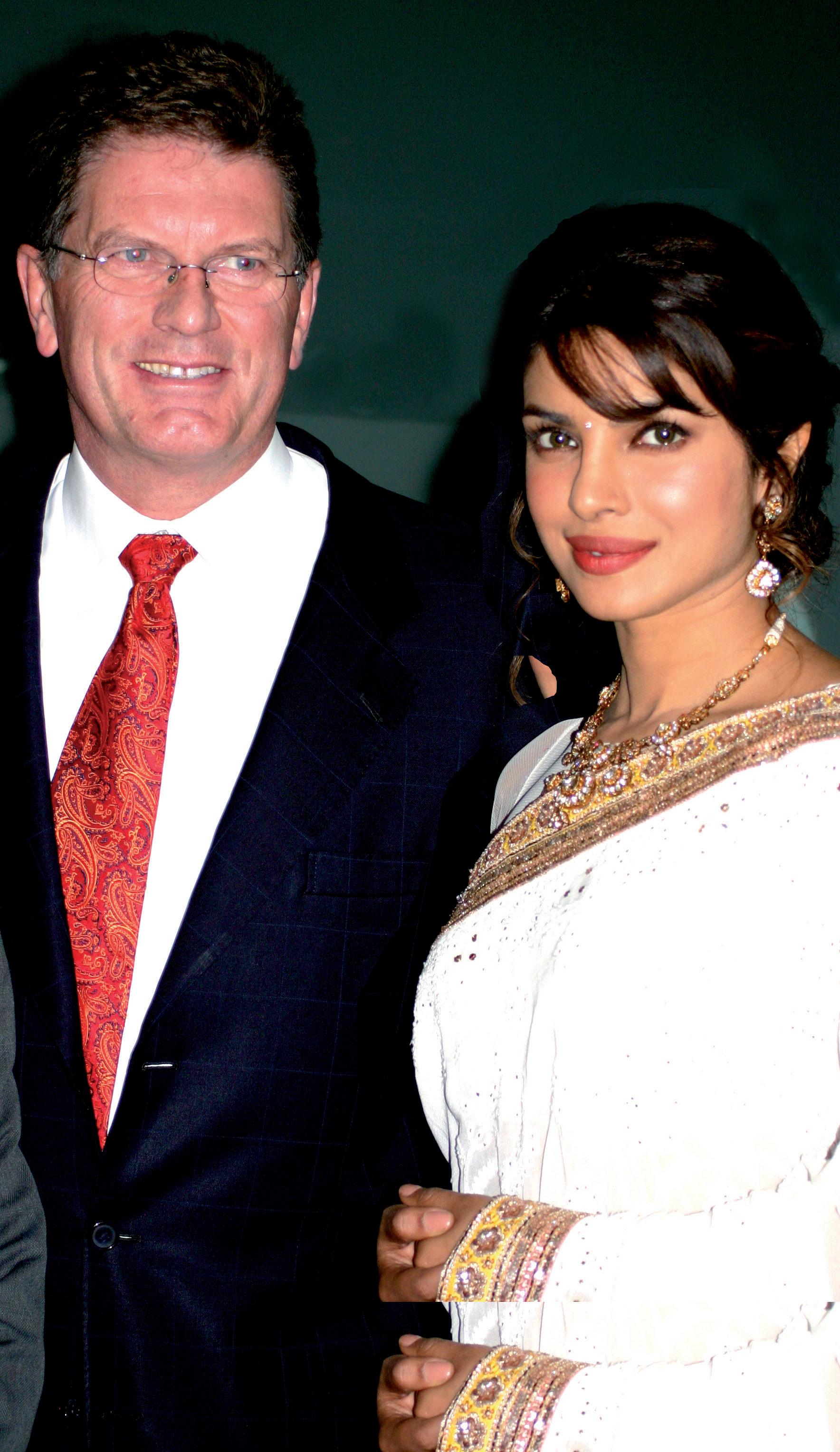


hugs&sunshine FREE Vol. 12 No. 8 • JUNE 2012 • melb@indianlink.com.au • www.indianlink.com.au MELBOURNE Sydney • Melbourne • Adelaide • Brisbane • Perth • Canberra PO Box 80, Chadstone Shopping Centre, Chadstone VIC 3148 • Ph: 03 9803 0200 • 1 8000 15 8 47 • Fax: 03 9803 0255 Bollywood stars bring Vic Premier Ted Baillieu
Priyanka Chopra Melb warms up to Shahid and Priyanka
with

2 JUNE 2012 www.indianlink.com.au

JUNE 2012 3 INDIAN LINK



letyourvoice be heard! Tuneinathome, atwork,oreveninthecar, Andturnupthevolume! INDIAN LINK STAY CONNECTED radIO Or listen live on www.indianlink.com.au 1 8000 15 8 47 to subscribe* *Min. 12 months, $9.95 pm $50 refundable deposit Free App Indian Link Radio now available at itunes app store wegiveyousomethingtoshoutabout
INDIAN LINK
PUBLISHER
Pawan Luthra
EDITOR
Rajni Anand Luthra
ASSISTANT EDITOR
Sheryl Dixit
MELBOURNE
Preeti Jabbal
CONTRIBUTORS
Preeti Jabbal, Sujith Krishnan, Sri Balachandran, Ritam Mitra, Petra O’Neill, Tim Blight, Rani Jhala, Nancy Althea, LP Ayer
ADVERTISING MANAGER
Ashish Chawla 0468 389 272
ADVERTISING ASSISTANT
Nitika Sondhi 02 9279 2004
DESIGN
Danielle Cairis
Indian Link is a fortnightly newspaper published in English. No material, including advertisements designed by Indian Link, maybe reproduced in part or in whole without the written consent of the editor. Opinions carried in Indian Link are those of the writers and not necessarily endorsed by Indian Link. All correspondence should be addressed to Indian Link
Level 24/44 Market St, Sydney 2000 or GPO Box 108, Sydney 2001
Ph: 02 9279-2004 Fax: 02 9279-2005
Email: info@indianlink.com.au

www.indianlink.com.au
Living in a world of migration
PAWAN LUTHRA
Speaking recently at a function in the UK, well known author Salman Rushdie touched on the theme of global migration.
“We live in an age of migration. There are more people now living in countries in which they were not born, than in the rest of human history combined.”
Rushdie’s observation on the flight of human capital between countrieswhether economic or political refugees or with family reunion motives - was that humanity is on the move, and will continue to be so for seemingly the better part of this century.
The world population of over 7 billion, combined with increasing awareness of what lies on the other side of the world thanks to the media, the internet and cheap travel, has allowed the exodus of people to take place much faster and in quicker time than in any other time of history.
This movement of people brings different sides of our characters to the fore, some of them good and others not so good.
Over the past few years, one has

come across a number of Indian entrepreneurs who have linked the business opportunities in their adopted country Australia to opportunities in India. On one side, there are those who, having lived here for a few years, have migrated back to India, established back offices in business processing in IT and now travel regularly to Australia to tender for business here for their teams in India. There are yet others, who have successful businesses in Australia but have over the past few years, set up back offices in India and so, while living in Australia travel regularly to use the skill set in India to provide services to their Australian customers. These entrepreneurs are normally young Indian migrants who are flexible and global with their approach in the business world.
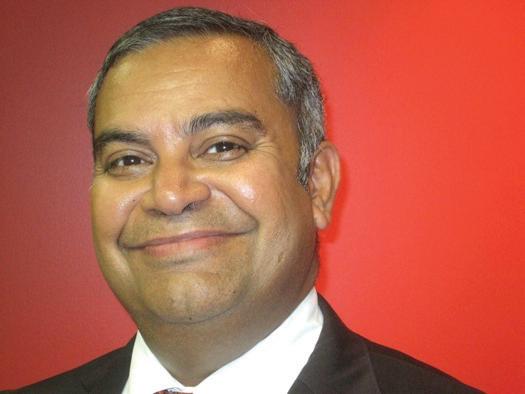
Even at a more basic level, there are an increasing number of local travel agents who are setting up call centres in India for their basic travel enquiries: once the customer is won over, the tickets can be picked up from a physical office in Australia, which allows the customer to have assurance of a face-toface contact.
On the negative side, the arrival of new people in the country creates fear about job security and lifestyle changes for the existing community. As different cultures with different traditions, lifestyle, clothes, food, languages etc flood into the country, it is normal to feel concerned
about change in the social fabric. It is often left to the leaders to explain the benefits of the change and how the tapestry of society can be enriched. Sure, there could be initial teething problems but over a longer period, the strength in the local culture should be strong enough to absorb the habits and lifestyle of the new migrants.
Xenophobia can raise its ugly head as vested interests speak out against the new arrivals. In a veiled manner, this was experienced when the recent proposal to bring in 1,700 overseas workers raised the shackles of the Australian Union movement. Most of the leaders, themselves from Irish and Scottish backgrounds lost sight of the bigger picture behind this proposal and their reaction was hostile. That the Prime Minister of the country could not explain the benefits of this migration agreement, rather feigned ignorance, was criticized by all.
With global migration at this scale, the challenge will be for greater education about the benefits of these changes to society. Leaders need to speak out and play down the shock jocks who prey on the feelings of paranoia and xenophobia of the masses. At the same time, new migrants need to work hard in keeping alive awareness of their roots and appreciation of where they came from and yet, assimilate in their new adopted countries.
JUNE 2012 5 INDIAN LINK EDITORIAL

6 JUNE 2012 www.indianlink.com.au





JUNE 2012 7 INDIAN LINK CHEAPEST AIRFARES TO INDIA, PAKISTAN, SRI LANKA, BANGLADESH, NEPAL, AFGHANISTAN. Kamlesh Patel: 0412 302306 Abdullah: 0430 553246 Ph: (03) 9793 0095 Fax: (03) 9793 0092 Email: k.patel@bookandfly.com.au, abdullah@bookandfly.com.au ADD: 20 Clow Street, Dandenong. VIC 3175 Send Money To India, Pakistan, Srilanka, Bangladesh, Afghanistan. Guaranteed Best Rates* *Conditions Apply Dhaka $960* Pakistan $995* India $950* Colombo $950* (*incl. taxes, 30kg luggage) 4 Individual Tax returns 4 Business Advisory & Taxation 4 Business activity statements 4 Company Accounting & Tax Returns 4 Trust Accounting & Tax Returns 4 SMSF Compliance & Tax Returns 4 Business, Company & Trust Setup 4 BAS & GST 4 Business Plans 4 Cash flow projections Our Services Call 1300 468 222 Full time offices NOW in Adelaide & Caroline Springs Offices located at: “We thrive for Excellent Service & Client Satisfaction” Harish Bisam Director Glenhuntly 1135, Glenhuntly Rd, Glenhuntly, VIC 3163 Caroline Springs Suite1, 218-222, Caroline Springs Bld, Caroline Springs, VIC 3023 Next to Contours Gym Adelaide Suite 26, Level5, 121 King William Street, Adelaide 5000 Melbourne Suite 808, 365 Lt Collins Street, Melbourne, VIC 3000 IT Payroll IT Recruitment Business Advisory & Consultants Medicare levy Exemption certificate Application for free Only $60 tax return for students and under 21’s
A Kahani
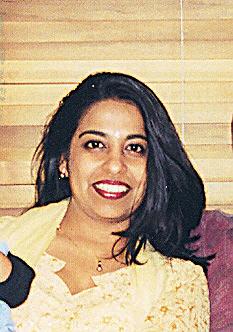
In defiance of Melbourne’s dreary weather, Bollywood’s best bring warmth, cheer and glitter to fans and
It was hugs and sunshine for the fans that managed to get up, close and a tad proprietorial with Bollywood
A-listers Shahid Kapoor and Priyanka

Chopra at the opening night of the Indian Film Festival of Melbourne 2012 recently. The star-studded diversion during a dreary Melbourne winter was a great way to wrap up the long weekend.
Every year since 2009, the IFF, under the aegis of Mind Blowing Films, brings its edgy brand of Bollywood glamour to Melbourne, and showcases dozens of innovative, independent films. On offer this year were over 40 affordable films from India, Nepal, Bangladesh, Pakistan and Sri Lanka, making the festival a multicultural delight.

‘Delight’ was an understatement for fans who went wild, screaming and fawning their pleasure when hunky Shahid and hot Priyanka took centrestage to inaugurate the IFF at Hoyts Melbourne Central. The Q&A was completely taken over by proclamations of love and adulation for the two popular stars. In between the delirious demands for hugs, some people did manage to ask questions on DVD piracy, Shahid’s bachelor status and how the stars cope with failure.
Priyanka’s diet or lack thereof came to the fore with Shahid taking great pleasure in counting all the things Priyanka had already eaten that day. “She loves food and eats everything including burgers and fries so follow Priyanka’s diet at your own risk,” he stated cheekily. Wonder where all that food went because there was not an ounce out of place in the actress’s perfectly toned body, as she sparkled in a white Manish Malhotra saree.
Priyanka and Shahid have previously been linked together as a couple; however according to recent reports they are no longer an item. When a fan asked whether they were having an affair, Priyanka clarified that they are “neighbours, co-actors and friends, and the rest no one needs to know!” The chemistry between the two was interesting to watch as it waxed and waned under public scrutiny at the opening event, as well as the press conference and the myriad interviews that were conducted with them that afternoon. There was an element of comfort in their current relationship as Shahid made several teasing remarks aimed at Priyanka, and she seemed to take them with good humour. On popular demand, the jodi also danced together to hits Mukhtasar and Jabse mere dil ko uff from their latest film release Teri Meri Kahani
The actors were accompanied by writer/ director Kunal Kohli and producer/director Vicky Bahri. They were here to promote the release of their epic time-hopping romance Teri Meri Kahani in cinemas in Melbourne on
June 20 and worldwide on June 22.
“We are all excited about the release of this film. It was a lot of effort to span three different eras during the movie but that’s what makes it unique, the concept of soulmates who meet and fall in love over three eras,” said Kunal. “It is a light-hearted movie and our favourite era is 1910. We hark back to pre-independence period but it’s not all about British rule and patriotism; it is about how people fell in love and led ordinary lives in extraordinary times”.
Also present at the opening were acclaimed designer Sabyasachi Mukherjee and award-winning director Jugal Hansraj, who will be conducting master classes during the festival.

Victorian Premier Ted Baillieu was chief guest at the opening night, accompanied by his wife Robyn. The Consul General of India in Melbourne Dr. Shubhakanta Behera was also present, with his wife Rajashree. The Hoyts Melbourne Central Theatre was packed to capacity; however it was clearly the stars that attracted the crowd as many of them left after the session with celebrities. Premier Baillieu and his wife stayed back to watch the opening night special Kahani, a wonderfully executed movie featuring Festival Ambassador Vidya Balan.
The award-winning entries for the Western Union Short Film Competition were also presented before the movie. In her introductory speech, Festival Director Mitu Bhowmick said, “The judging panel
of this year’s competition comprised of renowned film-makers and producers like Raj Kumar Hirani, Mick Molloy, Kabir Khan and Kunal Kohli. It was difficult for them to pick a winner amongst the brilliant work that was seen at this competition. The theme of ‘Connections’ was wonderfully explored by all the entrants.”
The star among stars at the glittery opening night was clearly the very youthful, very lovable, very effortless Shahid Kapoor. Add to that very charming, and you get the complete alpha male who flirted unabashedly with the audience. The ‘darlings’ were delirious to see their favourite and they all wanted to hug him. Kunal Kohli had to intervene and save Shahid from having to hug the shrieking youngsters collectively. Buoyed by the success of IIFA awards that he hosted recently in Singapore, Shahid had a humorous comeback for every question posed to him, whether it was good, bad or dumb. He was also game to dance with the Shiamak Indo Jazz Movement dancers who were invited back on stage so that Shahid could shake hands with each of them. Prior to joining the film industry, Shahid was an instructor for the Shiamak Davar Group, and he claimed that the Shiamak dances were ‘very special’ for him.
In true Indian style the Film Festival 2012 opened with colour and vivacity and surely this feast of diversity will continue till it concludes on June 22.
COVER STORY
PREETI JABBAL
movie-buffs at the Indian Film Festival
in the making
When a fan asked whether they were having an affair, Priyanka clarified that they are “neighbours, co-actors and friends, and the rest no one needs to know!”
Left page: Film Festival audience
Winners of the Western Union Short Film Competition: Shaun Thomas from NZ, Soumya Guruprasad from Melbourne, Nilesh from Sydney and Manjari Makijany from India
This page: Shahid and Priyanka are crowd-pullers


Priyanka Chopra with Victoria Premier Ted Baillieu

Director Jugal Hansraj brings his animation films to Melb
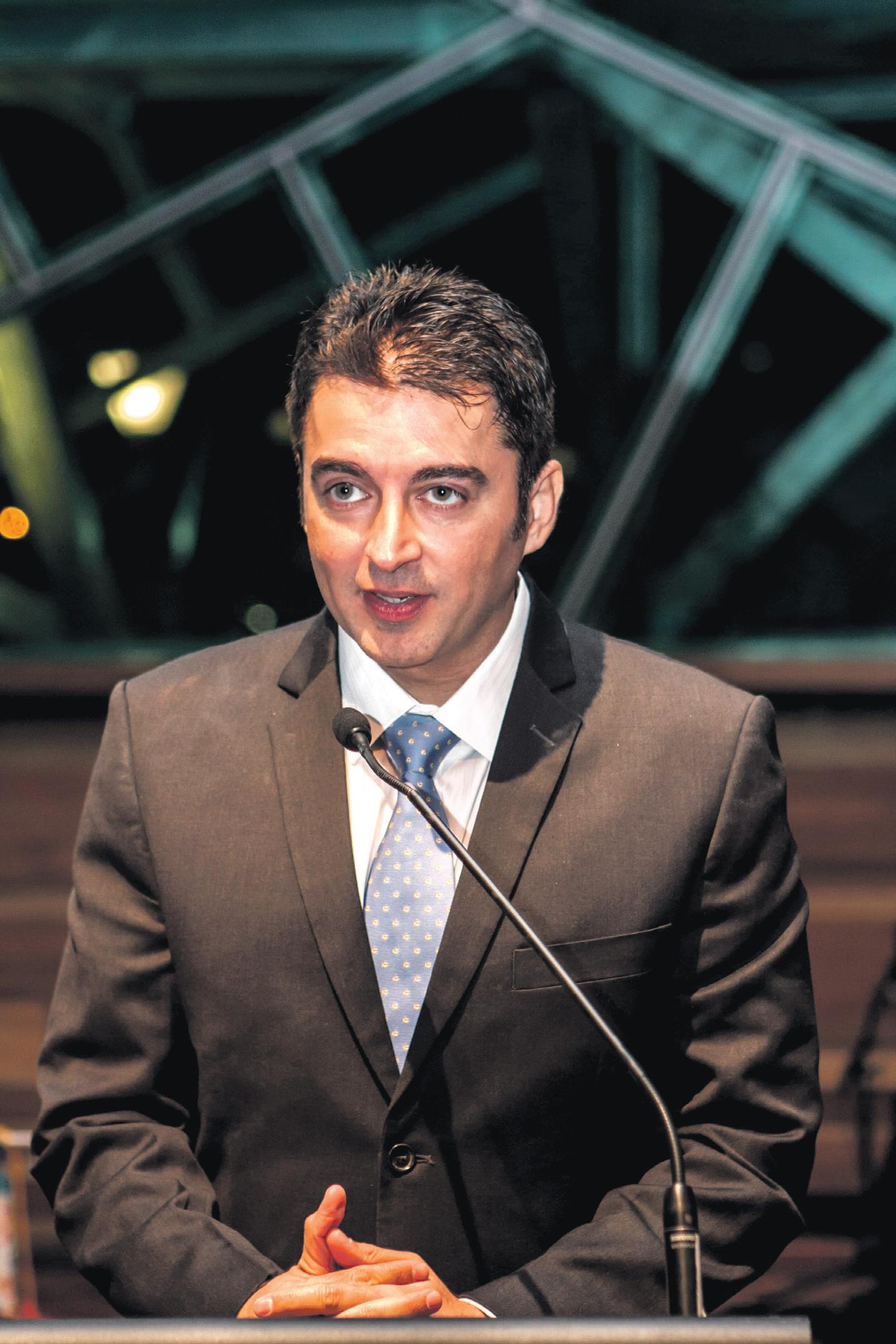
Festival Director Mitu Bhowmick Lange at the gala night
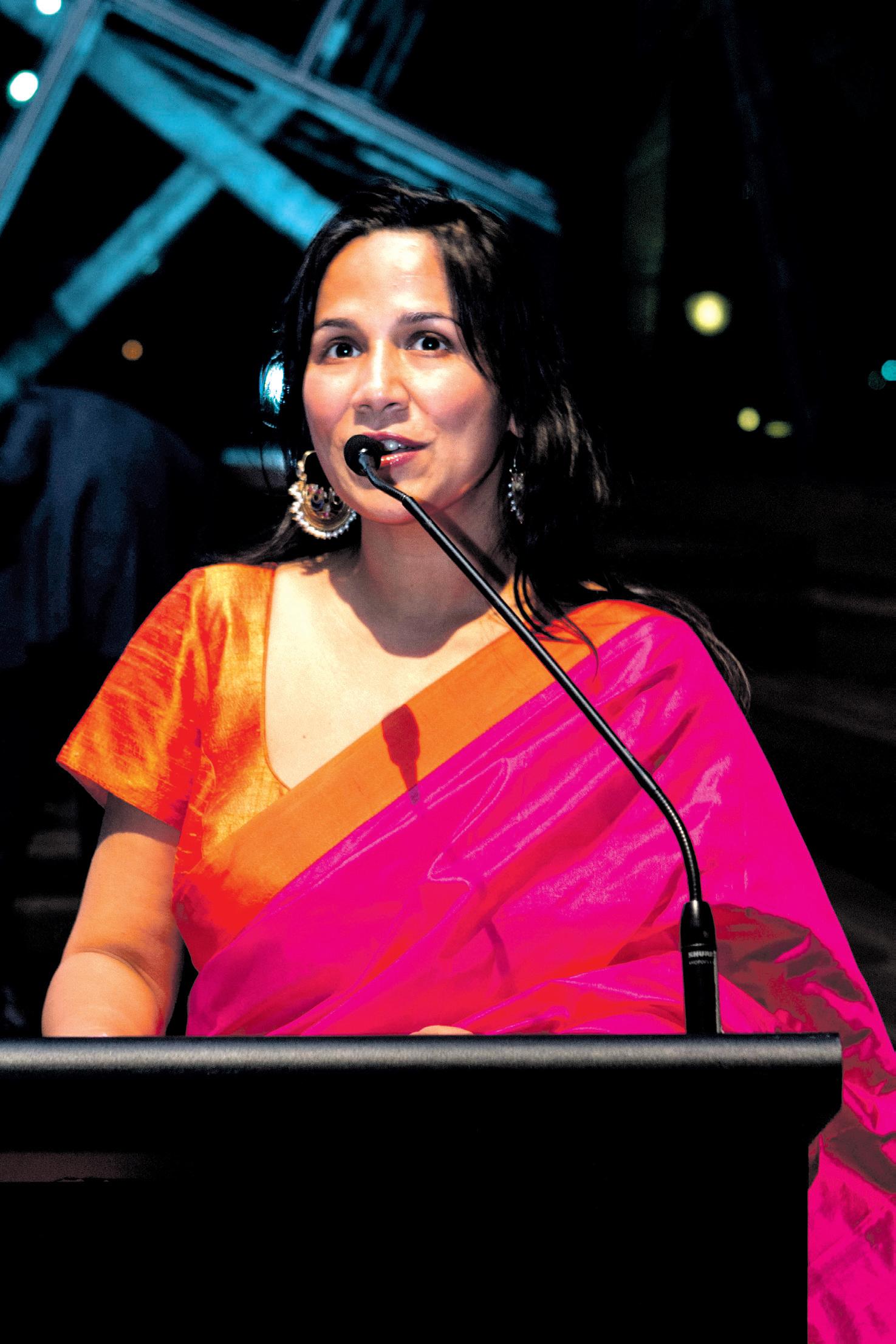
Buoyed by the success of IIFA awards that he hosted recently in Singapore, Shahid had a humorous comeback for every question posed to him, whether it was good, bad or dumb.

JUNE 2012 9
Photos: Ravinder Singh Jabbal
The Kahani

This winter, I got converted! I don’t know if it was the endearing laugh lines around his eyes or his devious smile, or the fact that he had a great sense of humour - whatever it was, I am now officially a Shahid Kapoor fan. Maybe not the screaming, swooning variety that came to see him in Hoyts Melbourne Central, but definitely someone who will take an interest in the trajectory of this young man’s career. Sporting very casual clothes, an unkempt look, a sinister stubble and floppy fringe, Shahid was boyishly affable and a delight to interview.
Equally, if not more charming, was Shahid’s ex ‘Piggy Chops’ (what an awful nickname for someone so gorgeous) who accompanied him to promote their upcoming release Teri Meri Kahani at the opening night of the Indian Film Festival (IFF) in Melbourne. There was nothing laidback about actress Priyanka Chopra, from her choice of somewhat inappropriate-for-winter clothes to her carefully applied make-up, to her wellthought-out answers. With a svelte figure to die, for she is hip and happening and she knows it!


Leading the promotional team of TMK was Writer/Director Kunal Kohli accompanied by Producer/Director Vicky Bahri. Obviously the press conference and interviews were predominantly about Teri Meri Kahani and the IFF; however, in what can only be termed as a crazily hectic day, I managed to get some insight into the creative people behind the movie whose tagline is, ‘Thrice upon a love story’.
I started the interview with Shahid who thankfully took his eyes away from his phone to answer my questions, the first one of which related to his penchant for comedy, despite his past roles as a dancer, romantic hero, among others. So what’s stopping Shahid from exploring comedy as his forte? “This has been on my mind for some time now. Earlier I did not realize I was funny, but a lot of people have told me I am. So maybe I should become a ‘funnyman’,” replied the star with a mischievous grin. “It will be an interesting transition to move from grey (roles like Kaminey and Badmash Company) to funny,” he added. “I am more than happy to do something that will make people laugh because that is why we make films - to entertain people and to make them forget the drudgeries of life.”
I took time to delve into Shahid’s lineage, as the maternal side of his family include some renowned literary figures. (His maternal grandfather was Anwar Azeem, a noted Marxist journalist and author. His great great grandfather was the film director, screenwriter, Urdu novelist and journalist Khwaja Ahmad Abbas more popularly known as K. A. Abbas. His mother Neelima is the daughter of Anwar Azeem, one of the greatest Urdu writers. K.A. Abbas in turn was the grandson of Hali, the chief protégé of Urdu poet, Ghalib). Does Shahid feel the urge to write, perhaps share a story in his mind? The talented actor was convincing in his response. “At the moment I do not have the time or inclination to think of writing. There is so much to learn, and I have just begun to discover myself as an actor and as an artist. Unlike acting, writing needs a lot more time and thought. As an actor I have the support of my writers and directors and for now I am happy to speak lines written by others,” Shahid stated candidly.
So why has he been quoted recently as ready to take on more roles and films, rather than being picky about his choice? Why the compromise of quantity over quality? Shahid shared a secretive smile with Kunal Kohli, sitting besides him. “It’s not like that at all,” he explained. “When I said that I had just finished filming for my dad Pankaj Kapoor’s film Mausam, which took about a year and a half to complete. Another project I was to work on got postponed, and I was bored doing nothing. Since the past 8 years I have worked 90% of the time and have been very busy, so I am not used to not working. When Mausam ended, I was happy to consider more work.”
I moved on to Vicky Bahri, the producer of TMK, known for his distinctive visual style. He has helmed over 45 commercials, 6 major tourism films as well as fiction and non-fiction TV. I asked Vicky how he defines a successful film, and how it is different from a hit film.
“A successful film has both box office appeal and critical acclaim. Ideally that’s the kind of film anyone would like to make, whereas hit films may not have critical acclaim and appeal purely to the masses,” Vicky replied.
My next question was for awardwinning director Kunal Kohli, who won deserving accolades for films like Fanaa and Hum Tum. How did Kunal feel about the new type of cinema originating from India, which has critical acclaim and also appeals to an Indian and international audience, for example, Anurag Kashyap’s Gangs of Wasseypur. Would he consider this emerging genre of films, or stick to safe commercial movies, I asked. “There
COVER STORY
It was a delight interviewing the stars and crew of Teri Meri Kahani, as they rocked Melbourne with their verve and panache
PREETI JABBAL
continues...
is nothing like a safe genre, no film is safe to make. If that was the case Mujhse Dosti Karoge would have been a blockbuster: it had all the safe ingredients,” replied Kunal.
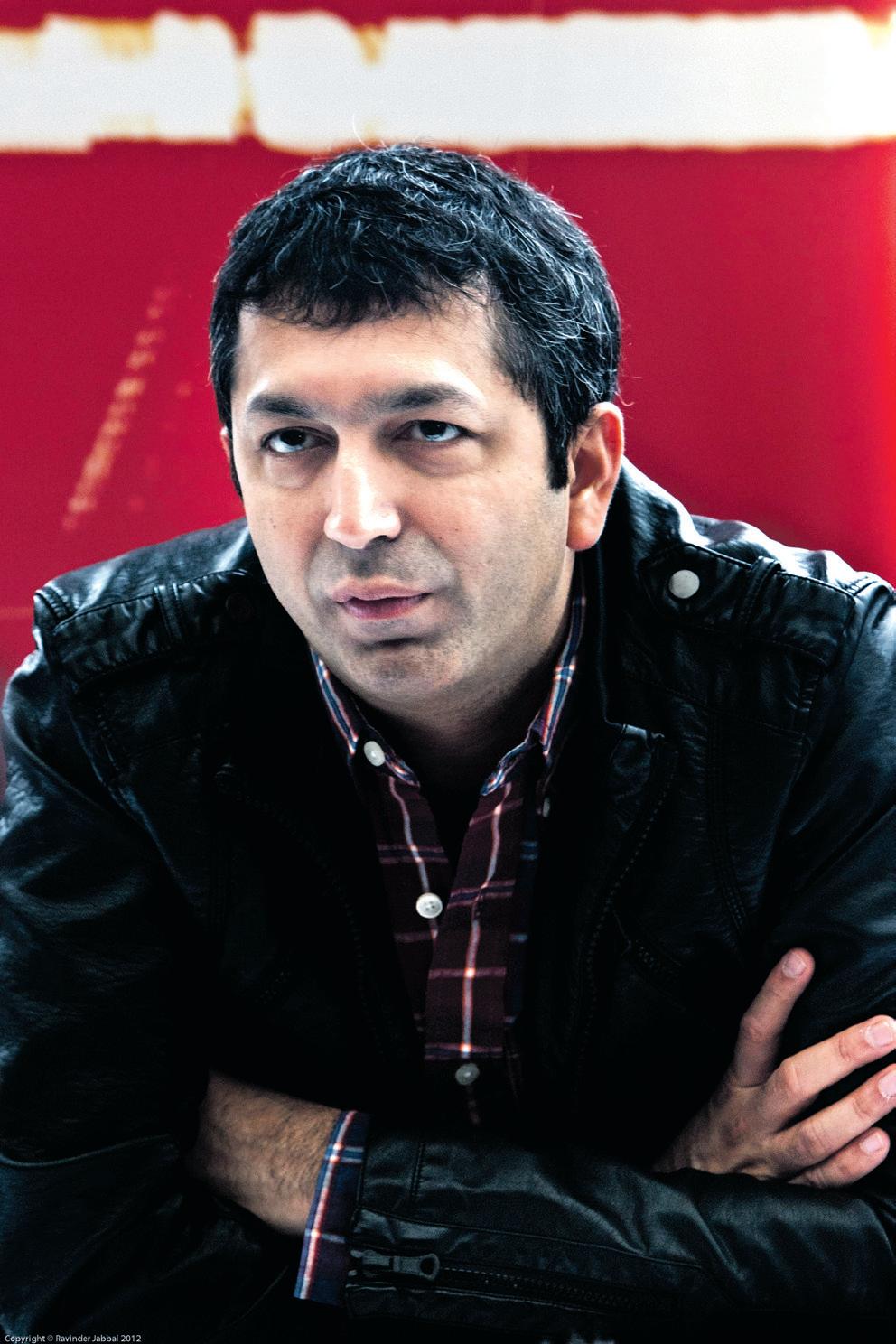
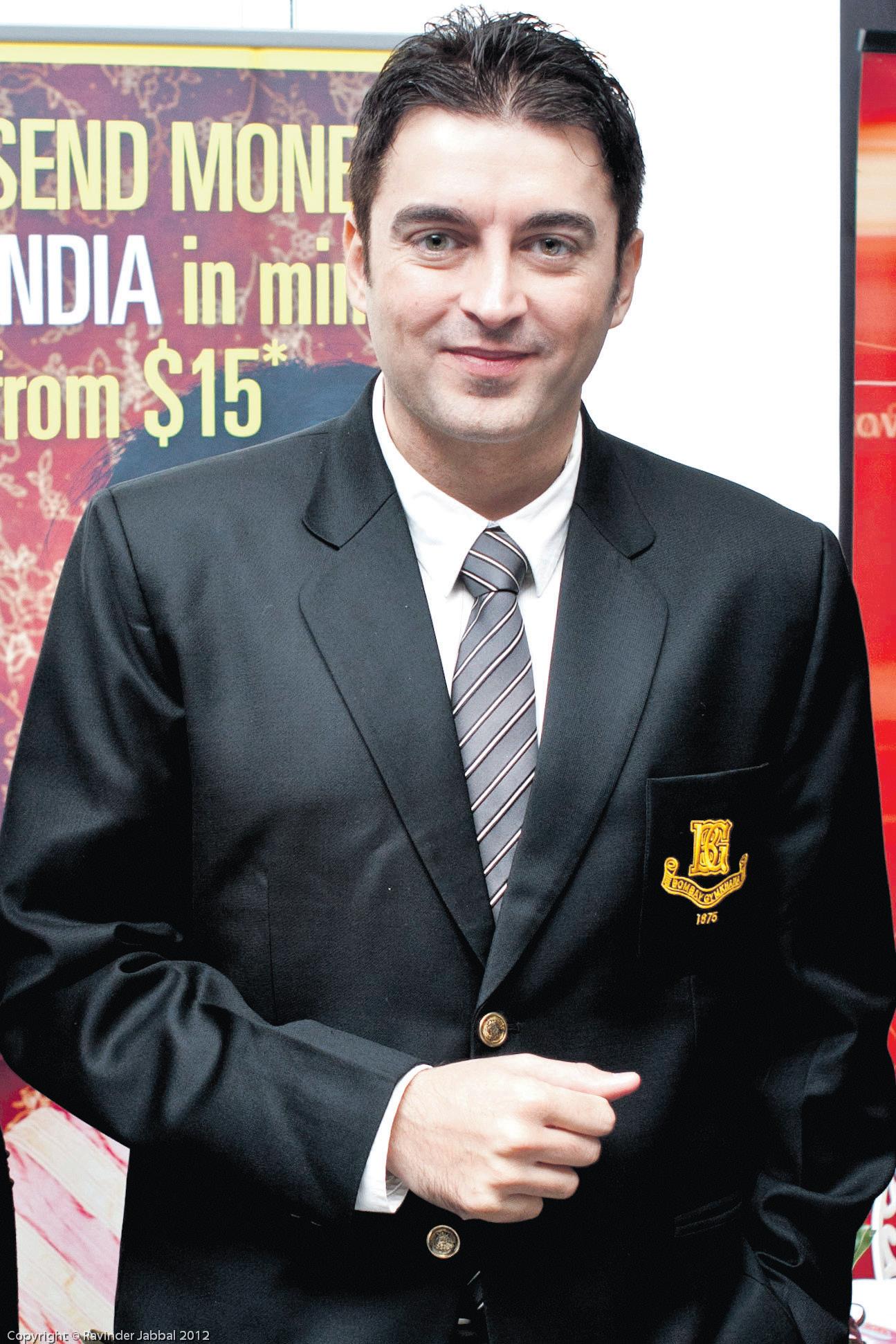
“In the past I have dabbled with different films, including a children’s film, but it was not successful. I like to stick to what I believe in. I am versatile and I can make all types of films, but for now I am happy to stick to the ones that are commercially viable. If my belief changes tomorrow, so be it,” he added with disarming candidness.
And finally, it was time to speak to the gorgeous Priyanka Chopra, having saved the best for the last. This talented actress will feature on an upcoming album, so I asked her what songs she would be singing. “Yes, I have recorded a pop album to be launched soon,” admitted Priyanka. “India is a huge community and music is an integral part of our culture; however currently there is a lack of international pop acts from India. This album presented an interesting concept for me and initially I was not sure about it, but I have always wanted to sing and this seemed like the right time to try something different. I am very clear that my music should be reminiscent of where I come from. I want people across the globe say, ‘Hey, that is Indian’. We have so much potential and talent, I am hoping this will encourage
more people to bring out their talent in pop culture”.
Priyanka will soon play a challenging role of an autistic person in upcoming release, Barfi. How did she prepare for this role?
“Barfi is a comic/thriller caper about an autistic girl. Autism has a huge variant, people suffer from various forms of autism. My role is that of a severely autistic girl and that came with its challenges. I did a lot of research for Barfi, I met a lot of parents and went to many schools. It’s almost tragic that the shooting has ended as I loved the role a lot. It is not a serious film with a serious message; it is about hope and love of real people who live with a disability. I think Barfi will be a very different take on people with special needs”.
And what about the additional Chopras making a foray into Bollywood, like her cousin Parineeti Chopra? Do they come to you for guidance? “I am delighted to see youngsters from my family joining the industry in various capacities. We are trying to create the ‘other’ Chopras like the Yash Chopra clan and the Kapoor family,” said Priyanka with a disarming grin.
“I am always there to guide my family if they want to create their niche in the film industry. Eventually, nothing can happen without destiny and they all have their own destinies to follow. It means a lot to me
to be able to be in a position to help and guide them, and I always will,” she added on a more serious note.
So which role would this multi-faceted actress really want to play? “A courtesan movie has everything - music, dance, beauty, glamour, sexiness. I think every actress would like to play the role of a courtesan and I certainly would love to do so,” said Priyanka with a faraway look in her eyes. “I would also like to do a fullon action movie. They are two extremely different roles that I would really want to play, given the opportunity”.
Priyanka and Shahid may deny their relationship; however they had an easy camaraderie that only comes from familiarity. Shahid jumped at any opportunity to pull Priyanka’s leg, and they laughed and joked with each other throughout the interview. Speaking to them made me realize just how mediasavvy these young stars have become. They seemed unfazed by the hours of grilling from various media representatives, but they visibly relaxed when I concluded our chat and they left to get ready for the opening night of the festival. It is admirable how they manage to pack in so much on a tight schedule and still manage to smile. I guess that’s what makes them true stars!


Priyanka and Shahid may deny their relationship; however they had an easy camaraderie that only comes from familiarity. Shahid jumped at any opportunity to pull Priyanka’s leg, and they laughed and joked with each other throughout the interview.
Main pic: Priyanka and Shahid brave the cold to meet Melb fans
At a meet-the-press at the start of the Festival are (clockwise from top) Festival Director Mitu Bhowmick Lange with celebrity designer Sabyasachi Mukherjee; Teri Meri Kahani director Kunal Kohli; Jugal Hansraj, and Priyanka and Shahid
 Main photo: News pics Photos: Ravinder Singh Jabbal
Main photo: News pics Photos: Ravinder Singh Jabbal
BUSINESS OPPORTUNITIES
Want to be in business for yourself but not by yourself? How about being in business with a company that has a solid 23 year history and revolutionary products that is changing the face of communications and energy. You can be part of it, work full-time or part-time – the time is now.
Call: 0413205455 or email hirend2006@yahoo.com.au for more info.


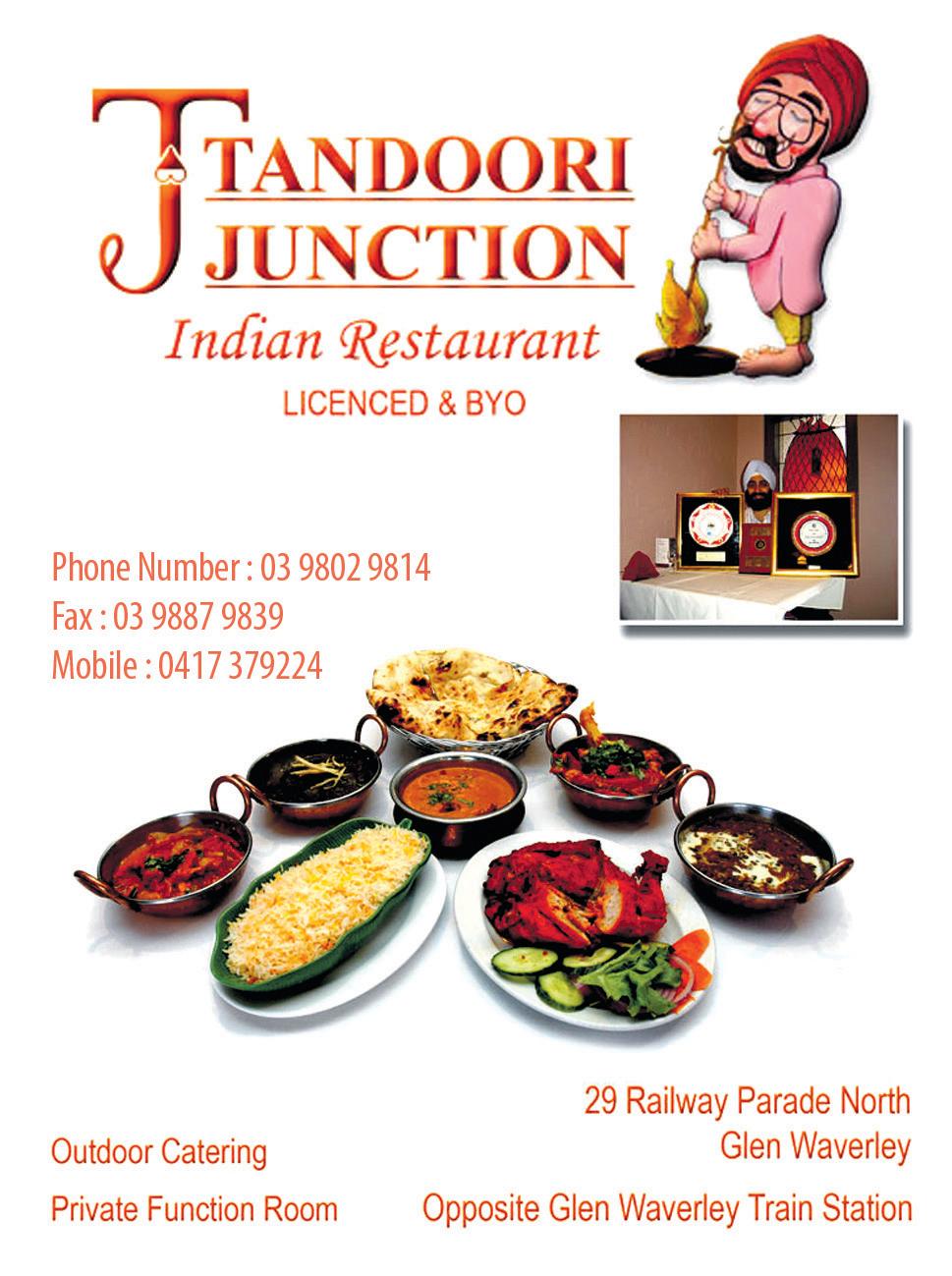

12 JUNE 2012 www.indianlink.com.au
(Indian, Srilankan and Fijian Groceries)
Running for Red
A large group of enthusiastic desis get together in support of fundraising for a good cause
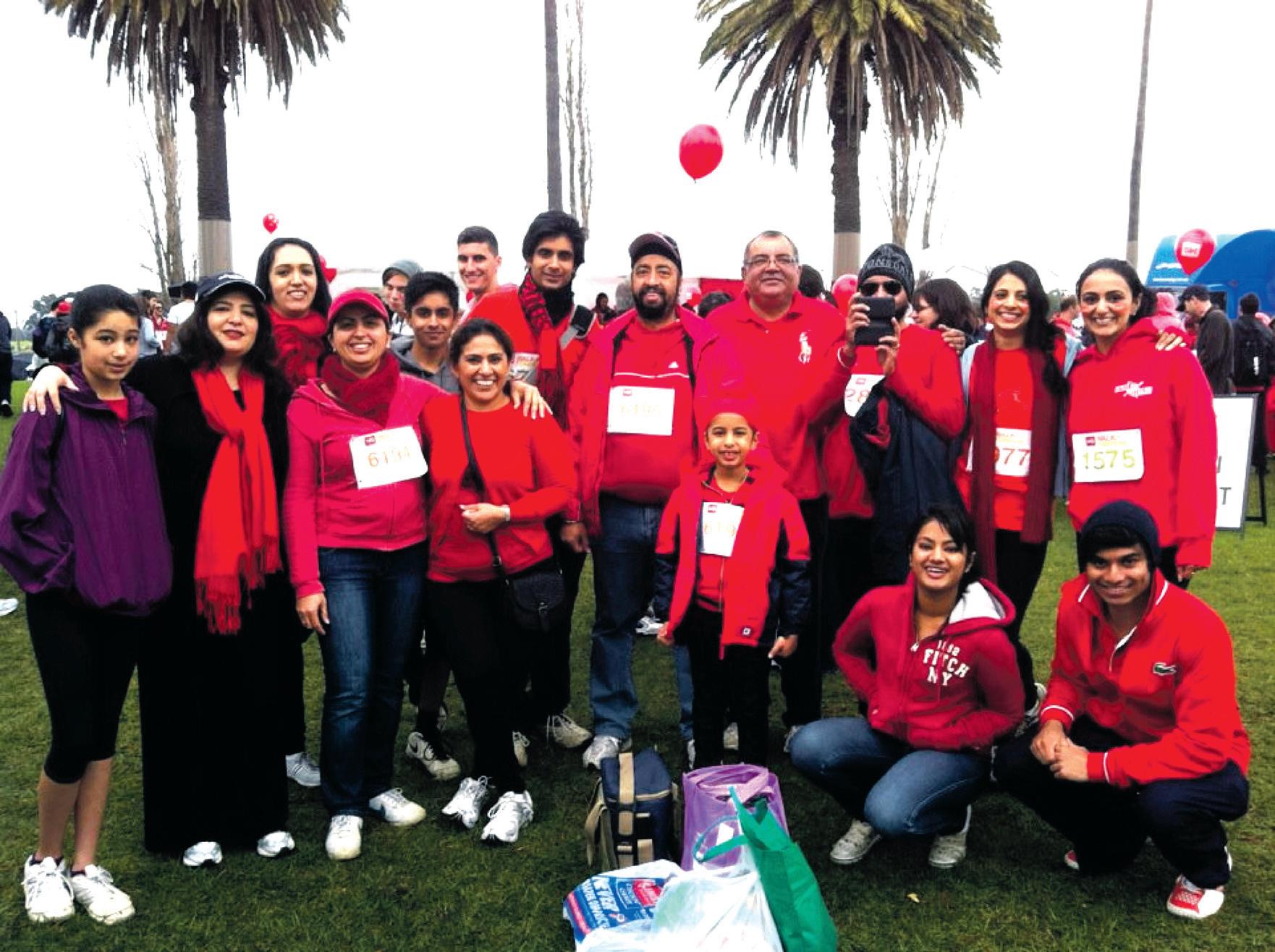
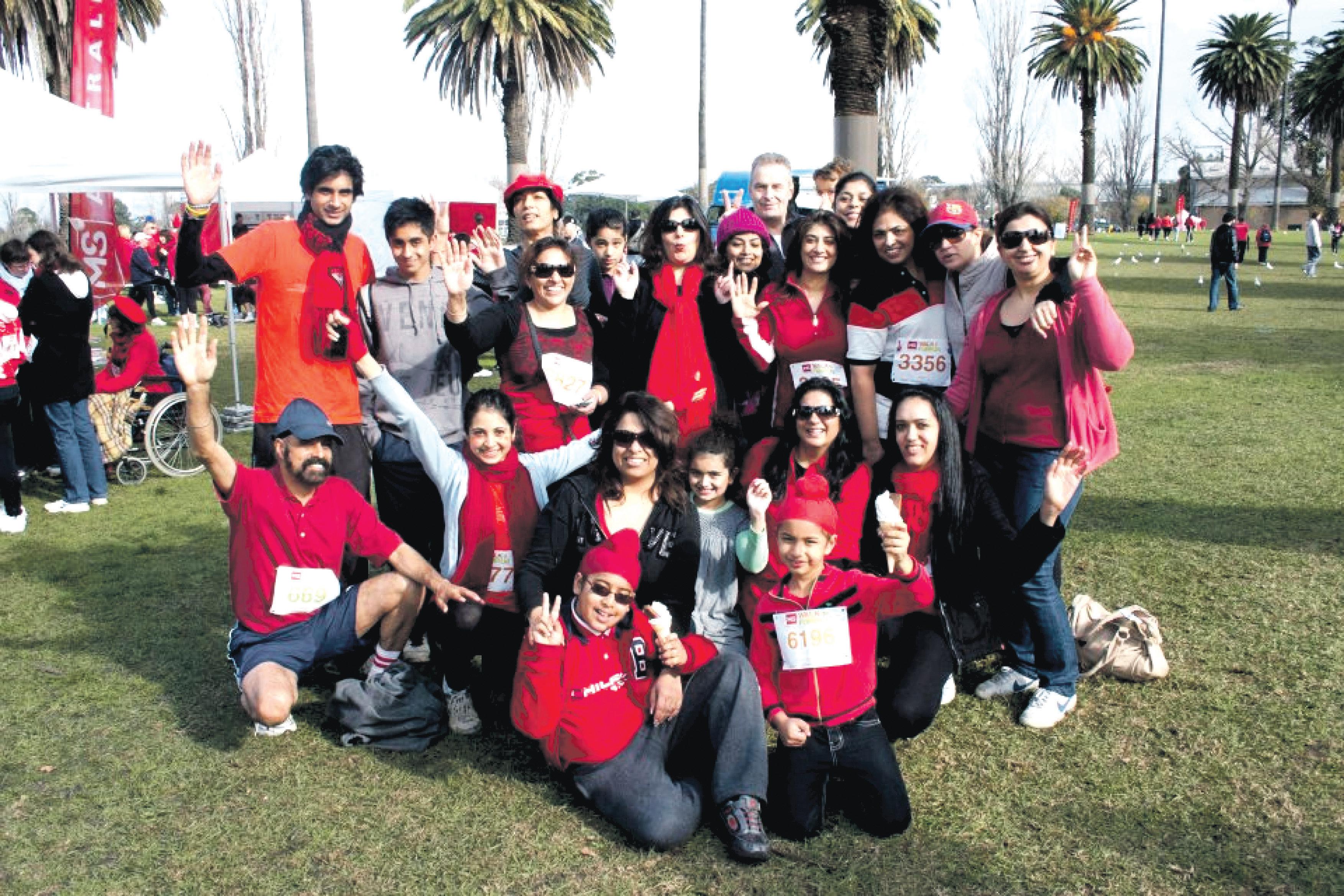
Atypical winter morning with blustery wind, intermittent showers and limited visibility did not deter Melbournians from participating in the MS Fun Run 2012 held recently, to raise funds for sufferers of multiple sclerosis. In fact this year the turnout was more than that in 2011, as nearly 6000 people wearing red pounded the pavement in Albert Park on June 3.
The atmosphere was buzzing like a carnival as the Fun Run lived up to its name, generating great enthusiasm amongst the participants. The aroma of sizzling sausages and freshly brewed coffee promised a warm welcome after the run. Some of my better-organized friends had even managed to pack some food and drinks with the intention of having a picnic later.
Humankind in all its variety flocked to the event. There were the imaginative ones with interesting team slogans, the fun-loving ones in red costumes and red hair, the motivated ones who did the 10km run or the 10km walk, and the social ones who made friends and influenced people even as they walked. There were families with kids in strollers and grandparents, or MS sufferers in wheelchairs.
As part of the MS (More Smiles team) I arrived at Albert Park with camera, runners, red T, banner et al. Simply watching the sea of red from far warmed up the adrenaline. By the time I caught up with my team and pinned my registration number on, the adrenaline was revved up to tango to my steps.
Accompanied by friends and
family, I joined the crowd as it started walking en masse, around the scenic track near Albert Lake. The swans seemed unperturbed with all the human interference as they went about their daily routine without flapping a wing. Along with the breathtaking views of Melbourne’s city skyline, some roving entertainers kept the walkers engaged.
Only fifteen minutes into the walk and I warmed up not just with the exercise, but with the warm feeling associated with being able to contribute in a small way towards a great cause. Others in my team echoed my sentiments.
The More Smiles team managed to surpass its team goal to contribute over $2000 towards the fundraiser.
The MS Fun Run is an annual event held by MS Australia in Sydney, Melbourne and Canberra.
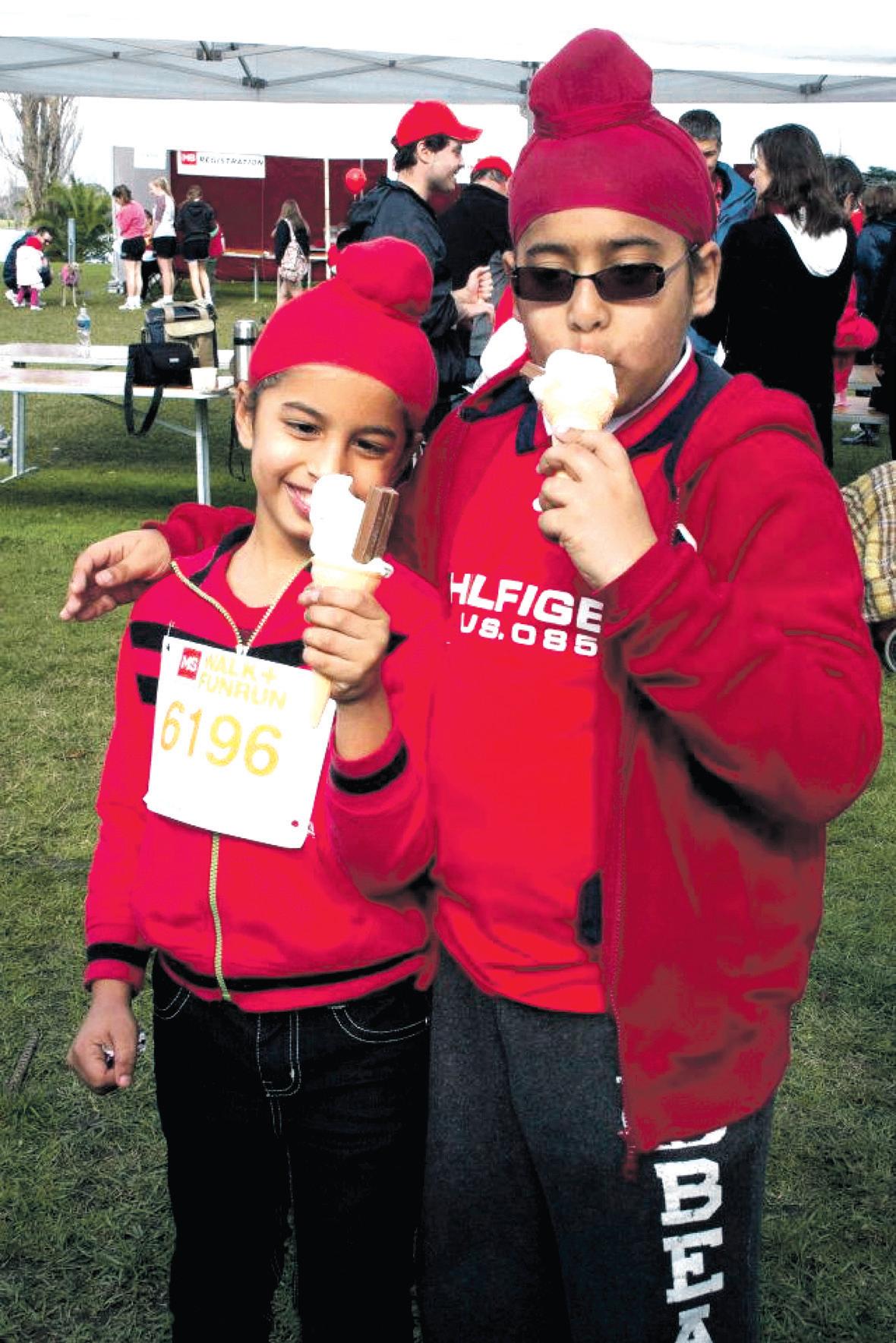
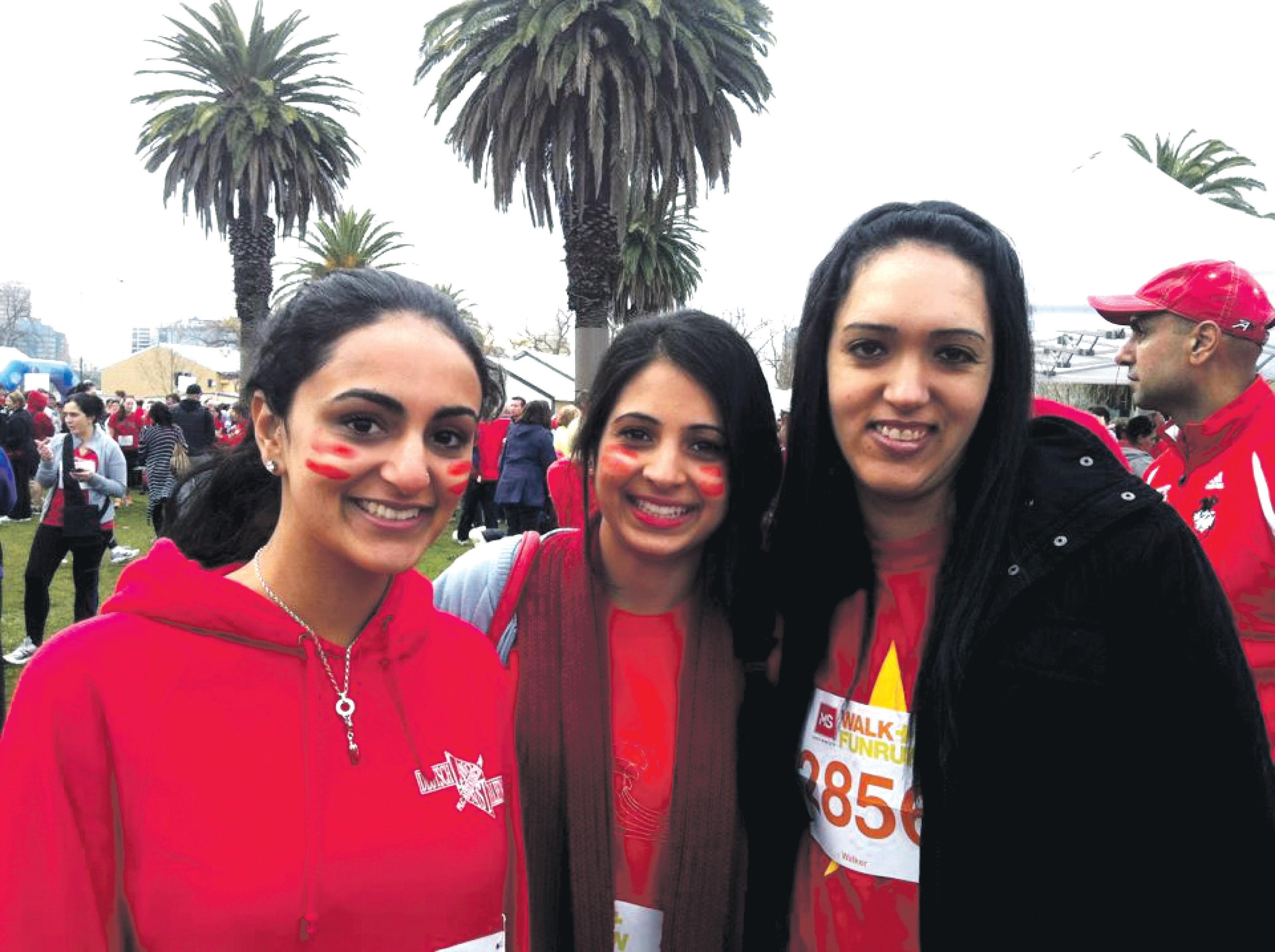
Multiple Sclerosis is a neurological condition that affects the central nervous system of young adults. A cure is yet to be found; however the funds raised are utilized to provide facilities and support to people suffering from this debilitating disease.
This year the aim was to be able to raise $1.1 million for people affected by MS. At last count, the event had already raised $1,206,316. I believe that increasing our capacity to give, be it time, money or effort, is the most worthwhile practice in our personal development. Research shows that being generous makes us happy. It also helps others and builds great communities.
I have long forgotten the aches and pains that I experienced after the walk, but I still remember the warmth of red and the joy of giving.
Preeti Jabbal
INDIAN LINK CO mmu NITYS CENE
Brains, bhangra and beauty
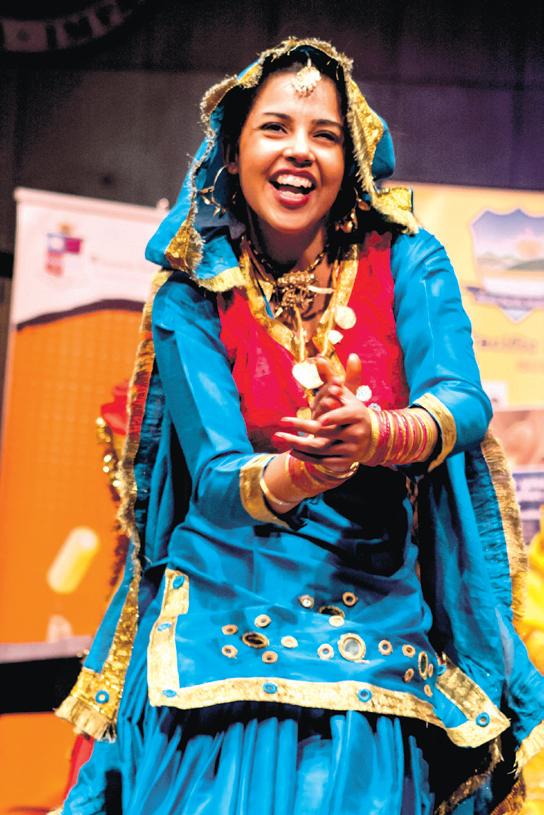
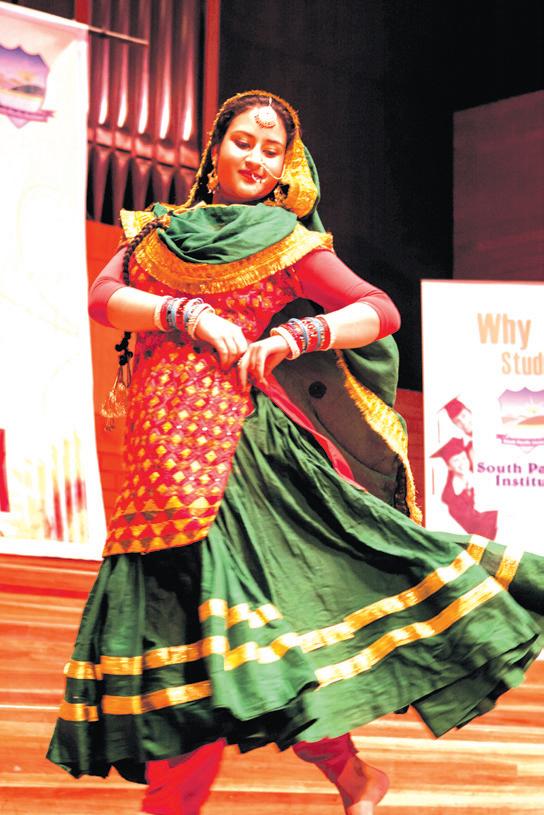
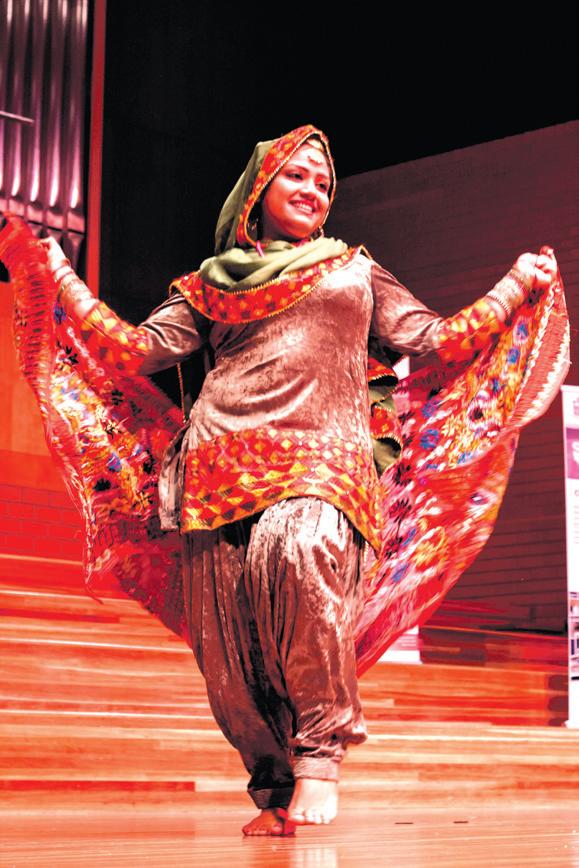
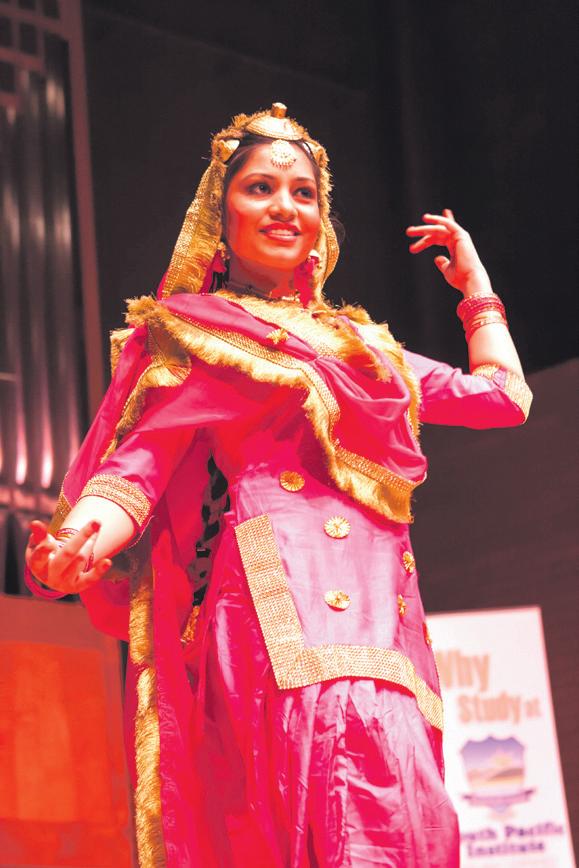
Talented young women display their knowledge of authentic Punjabi heritage and culture in an unusual beauty pageant

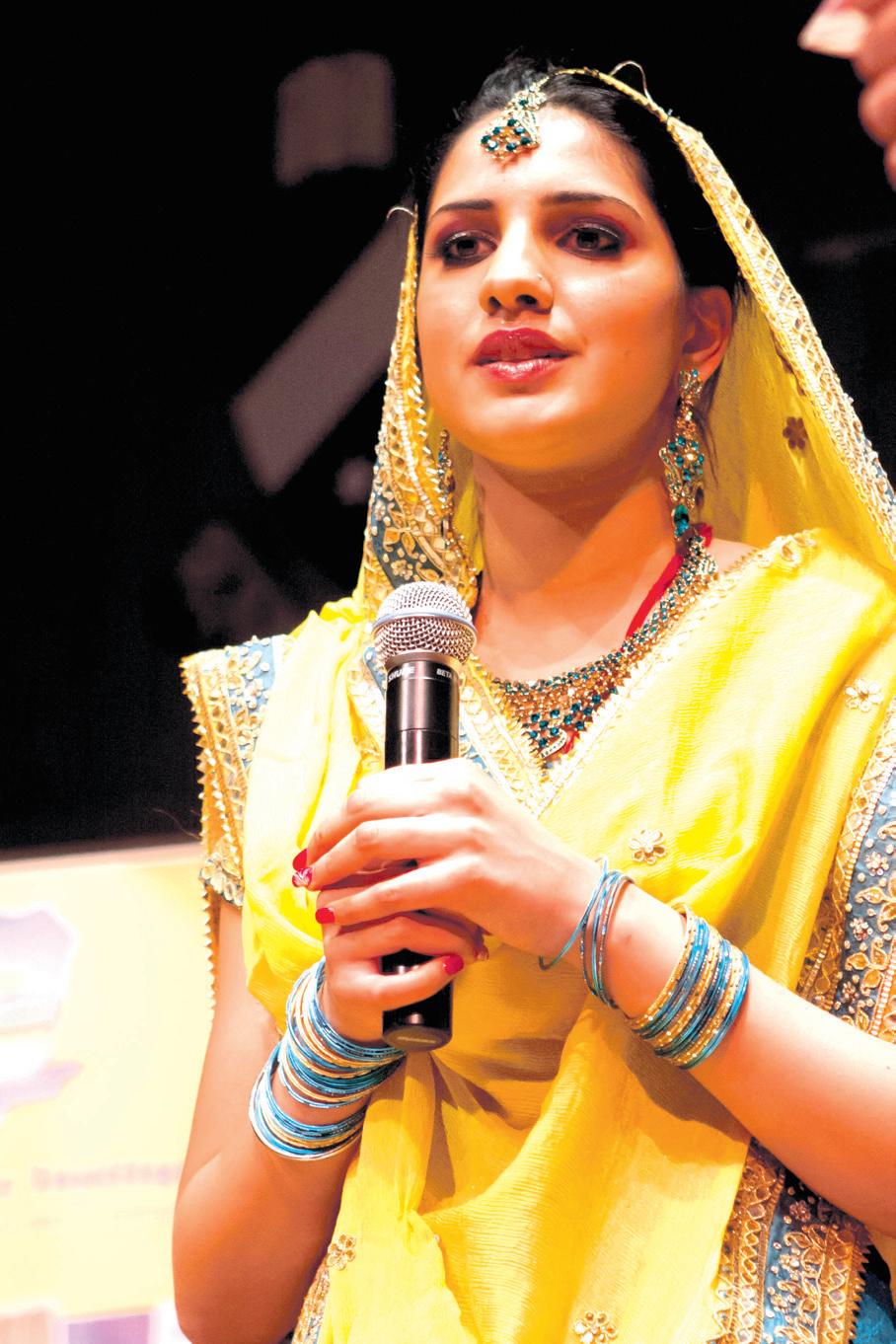
any lack of beauty among the ten gorgeous participants. While a majority of the young ladies were from Melbourne, a few also travelled from Brisbane and Canberra to display revelatory knowledge of Punjabi heritage. The event was organized under the aegis of Jasmer Singh Dhatt, chairman of Sabhyacharak Satth Punjab, with the support of The South Pacific Institute, Melbourne.
The first segment of the Miss Punjaban Australia 2012 was a solo dance round, followed by an individual talent round, heritage round and group dance (teamwork) round. Music is an integral part of Punjabi culture whether it is a celebration, contemplation or sorrow, and not surprisingly, all the contestants chose to perform to Punjabi music for nearly every segment. The bhangra and gidda quotient was dominant throughout the very long evening.
Dr. Preetinder Grewal was responsible for anchoring the event accompanied by Mrs. Harleen Sohana. While Grewal added some robust humour to the evening, Sohana resorted to endless poetry. Black Saturday survivor Charnamat Singh from Kinglake was also invited to share his views and homilies with the audience. All the sponsors and supporters of the event were officially acknowledged with a memento.
Manpreet Grewal, an 18-year old accounting student from Deakin University took away the title of Miss Punjaban Australia 2012 at a unique pageant held in Robert Blackwood Hall in Monash University recently. There was not a single skimpy outfit to be sighted at this event, nor any trite statement heard on the need to save the world and help the underprivileged. Instead, the contestants were seen in traditional Punjabi outfits with their heads covered with a dupatta (traditional scarf) at all times. Instead of mouthing stereotypical platitudes on how to save the world, the participants focused on celebrating and sharing their culture with the world.
The scope, history, sophistication and complexity of Punjabi culture is vast, and the Punjabi diaspora plays a big part in rejuvenation of its culture. Having settled in different parts of the globe, the contributions of Punjabis reflect their personal experiences in foreign lands. By expanding tradition and incorporating the influences from their new contexts, Punjabis are mostly happy and willing to share their heritage. It was this confluence of Punjabi philosophy: via music, education, poetry and values, that was witnessed at the Miss Punjaban Australia 2012 event. It was a pageant that celebrated heritage and culture over beauty and glamour. Not that there was
It was a tough decision to make for the three judges – Manpreet Kaur from SBS Punjabi radio; Dr. Satish Verma, professor, writer and poet from Patiala; and Bhangra expert Varinder Saran. Almost everyone who participated turned out to be a winner as Jagpreet Kaur won the best folk dancer, (solo performance) Ramandeep Kaur won Gunwanti Punjaban (talent round), Baljit Kaur won Sughar Syani Punjaban (knowledge/ heritage round) and Rajdip Kaur won Giddiyan di Rani (winner group dancing category).

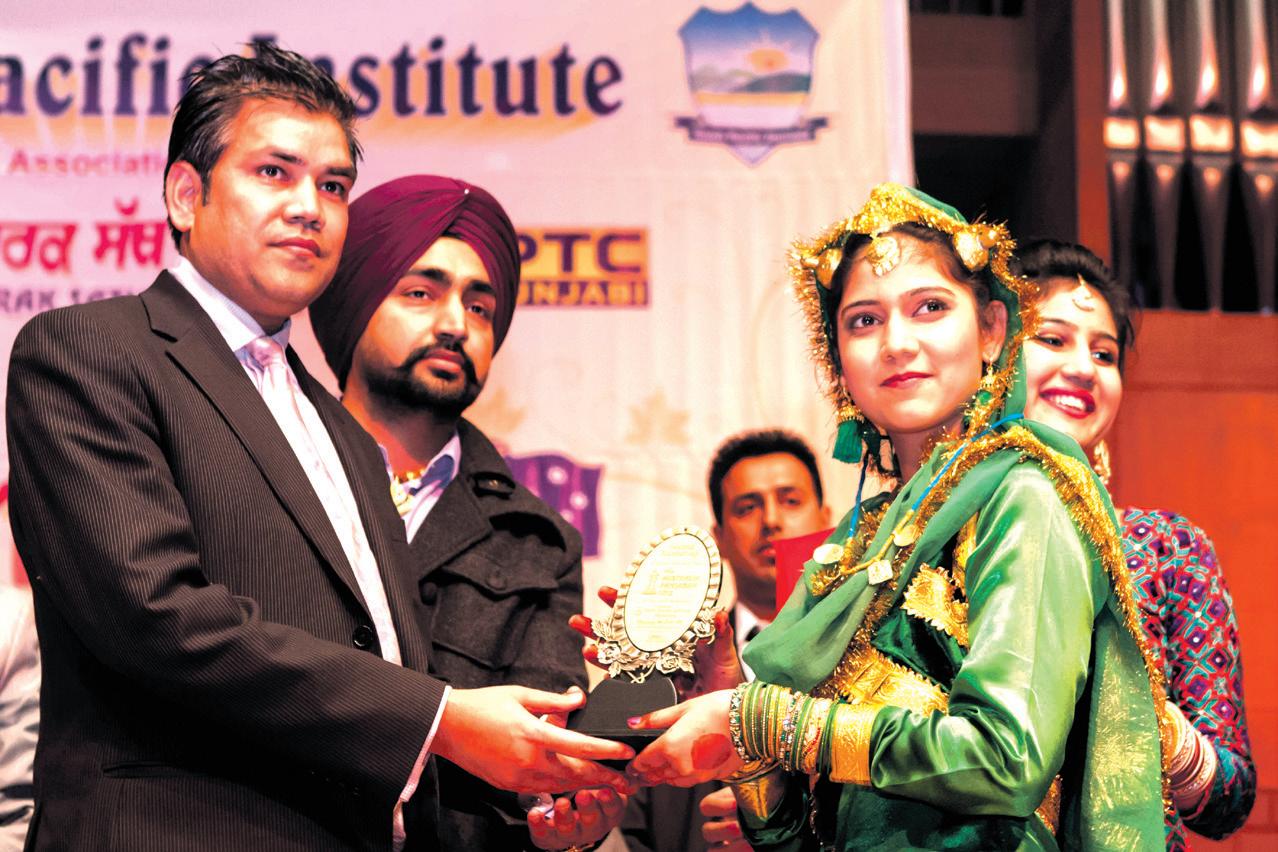
In a contest that claimed to explore both the soorat (outer beauty) and seerat (internal beauty) of the contestants, Parminderjit Waraich from Brisbane was declared the first runner up and Gagandeep Kaur from Melbourne took away the second runner up title. The Miss Punjaban Beauty pageants are multi-tiered, and local competition feeds into the larger competition. Australian winner Manpreet will go on to participate in the semi finals to be held in Chandigarh, India and if successful will attend the finale to be held in Ludhiana in November this year.
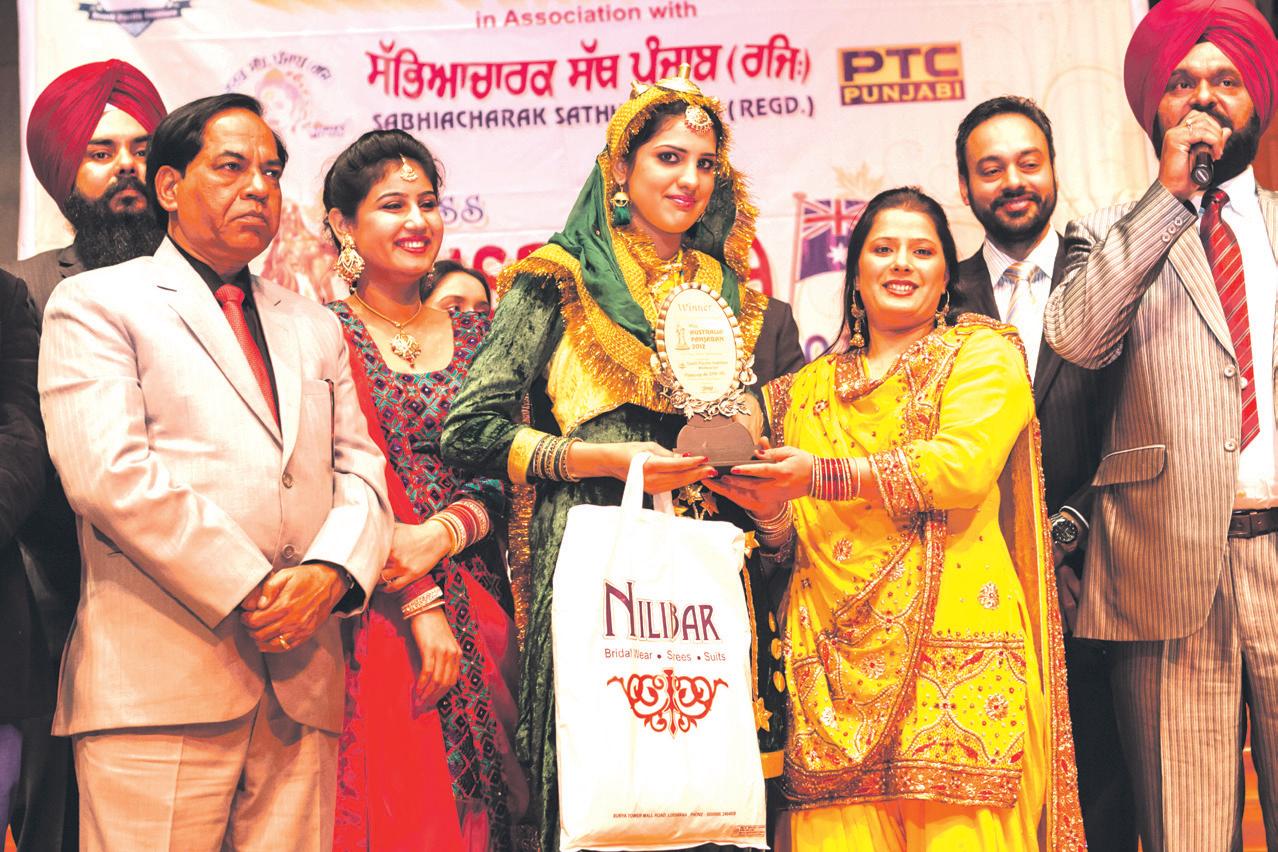
Preeti Jabbal
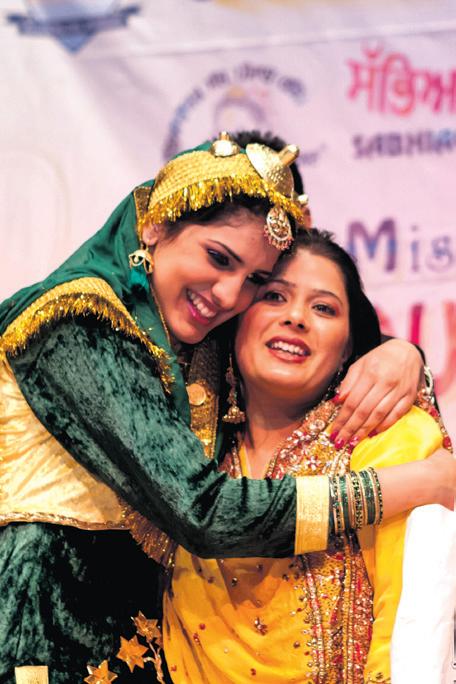
14 JUNE 2012 CO mmu NITYS CENE
Photos: Ravinder Singh Jabbal

JUNE 2012 15 INDIAN LINK
Powerful vocals mark classical festival
The annual prestigious and popular carnatic musical event of Melbourne, the Mom Moorthigal Jayanthi & Tyagaraja festival, was held this year on May 5 – 6, at the Kel Watsons Theatre and the Hindu Society’s Shiva Vishnu Cultural & Heritage Centre in Carrum Downs respectively. Incidentally, the cultural centre was inaugurated on May 5, and this year’s Mom Moorthigal festival is the first large scale musical event held at this venue.

On the first day of the festival, there was a unique opportunity to showcase the talent of about 40 TYME (Talented Young Musicians Ensemble) under the leadership of Smt
Jayshree Ramachandran and Sri Ravi M Ravichandhira, OAM. It consisted of vocal, veena, violin, mridangam and ghatam segments, impeccably performed by the TYME group artistes. Segments of the TYME video were also telecast and received wide acclaim on Theepam TV in London on May 23, during a live interview of Sri Ravi M Ravichandhira.

As the festival progressed, local carnatic music artists like Rama Rao, Uthra Vijay, Ahilan Sivanathan, Jayshree Ramachandran, AGA Gnanasundaram visiting from overseas and Sridhar Chari, Balasri Rasiah and Ravi M Ravichandhira performed.
The second day of the festival began with
rendering of kritis of the Trinities of Carnatic music, namely Shyama Shastri, Muthuswamy Dikshitar and Saint Thyagaraja. The highlight of this was the rendering of Pancharatna kritis of Saint Thyagaraja. A lecture demonstration on philosophical import in Thyagaraja’s compositions was ably delivered by Prof G Narimhan. In addition, local artists like the Iyer brothers – Ramnath and Gopinath, Narmatha Ravichandhira, Murali Kumar and Shobha Sekar performed. The festival fittingly concluded with a special concert by visiting overseas artists Seetha Narayanan on vocals and AGA Gnanasundaram, a Lalgudi Bhani exponent on violin from the UK, performing
with our very own Sridhar Chari on mridangam
A special mention must be given of Seetha Narayanan’s concert which was brilliant, and given her age, her elaborate singing and diction was unique, in particular the kritis of Kalyani and Karaharapriya. Her visit was arranged through the Kala Kruthi School of Melbourne in collaboration with the Music Academy Chennai.
The Mom Moorthigal festival concluded its 24th year on a grand scale, and was organized by the Academy of Indian Music and Sruthi Laya Kendra, with assistance from the City of Monash Council.
Sri Balachandran
CO mmu NITYS CENE
AGA Gnanasundaram, Sai Nivaeithan and Sai Sarangan Ravichandhira
16 JUNE 2012 www.indianlink.com.au
Winter funk moves warm up audience
with movement.
If there is any Bollywood dance show in Melbourne that is guaranteed to get the audience hollering and hooting with cheers of appreciation, it has to be a Shiamak Funk. The sheer energy and raw power demonstrated by students and instructors in Shiamak’s fun, electrifying show is quite entertaining. This rather stimulating show has it allecstatic dancing, music that lifts the spirits and a stage that is alive
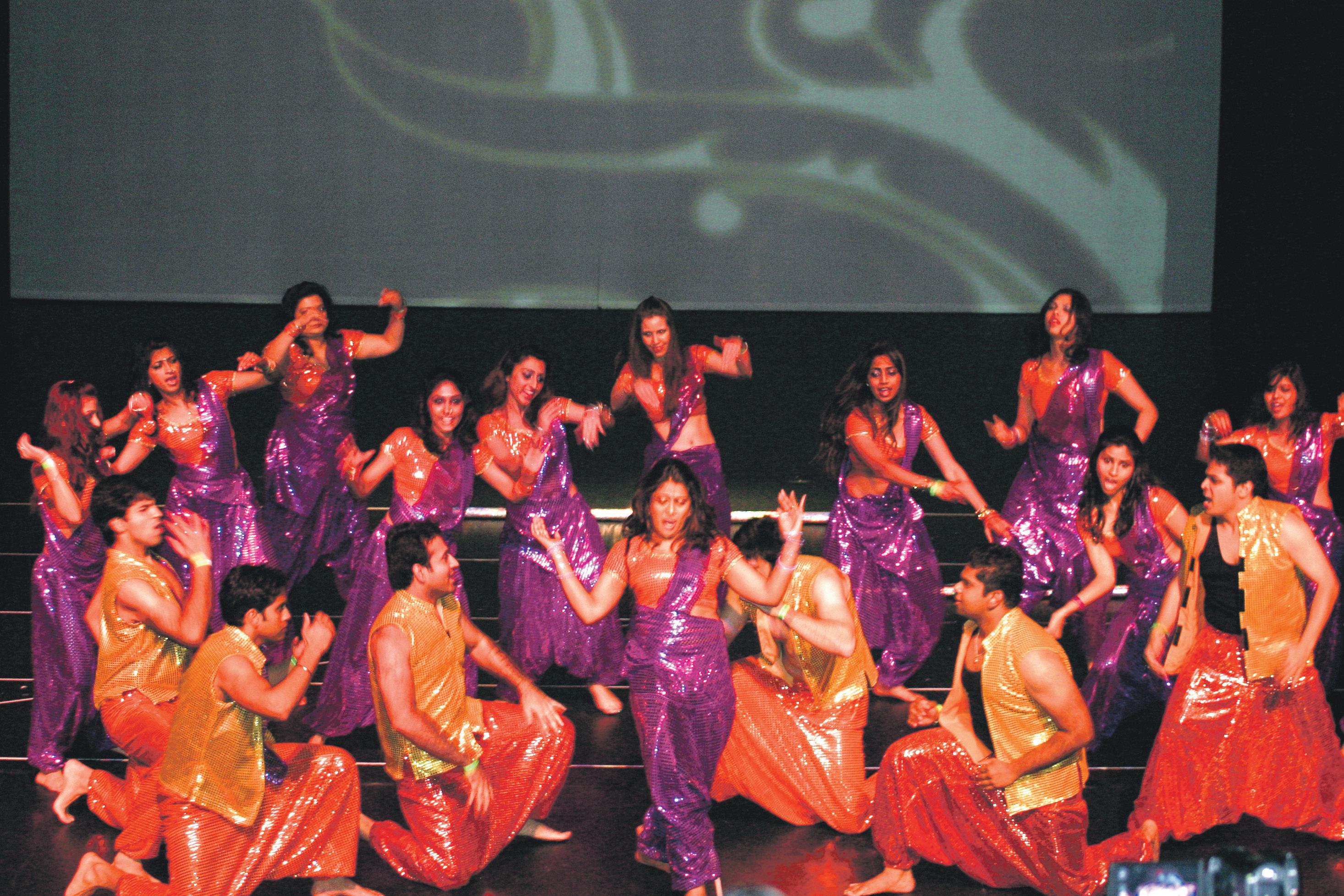

With a marathon of 46 dances performed by students from seven locations across Melbourne, Shiamak’s sixth annual Winter Funk, held recently at the National Theatre in St. Kilda, certainly lived up to the hype. The show was a culmination of the efforts of students from two batches of SIJDM. The end of term performance was a highlight for every student and the audience filled with family and friends was a fantastic catalyst for them. They were all there, the camera wielding proud parents, the noisy shrieking teenagers, the supportive friends and the totally gobsmacked toddlers, each one enthusiastically applauding for their own.
Stand out performances were executed on popular Indian film songs like Saiyaan (Agneepath), Ishq Sufiana (The Dirty Picture) and Chikni Chameli (Agneepath). A pure jazz performance by the Special Potential Dance Group (selected by Shiamak Davar for their dancing skills) was very well received. The colourful festivals
of India offered a great visual experience, while the exuberance of the finale by the show kids on the song Deva Sri Ganesha sent the audience into catharsis The entire performance was one beautiful spectacle after another, all quite entertaining, as witnessed by the enthusiastic responses from the audience.
The dancing melded hip-hop, jazz to Indian classical and the participants wore everything from saris to hot pants. Inspired by the work of renowned choreographer Shiamak Davar, the SIJDM instructors successfully negotiated the balance between tradition and eclecticism of dance genres. It turned out to be a rather long concert; however for anyone that follows dance and appreciates the art form, the show was enjoyable in many ways. For anyone who didn’t particularly know anything about dance, the Shiamak Winter Funk 2012 proved to be an opportunity to find out what talented people can do in Melbourne
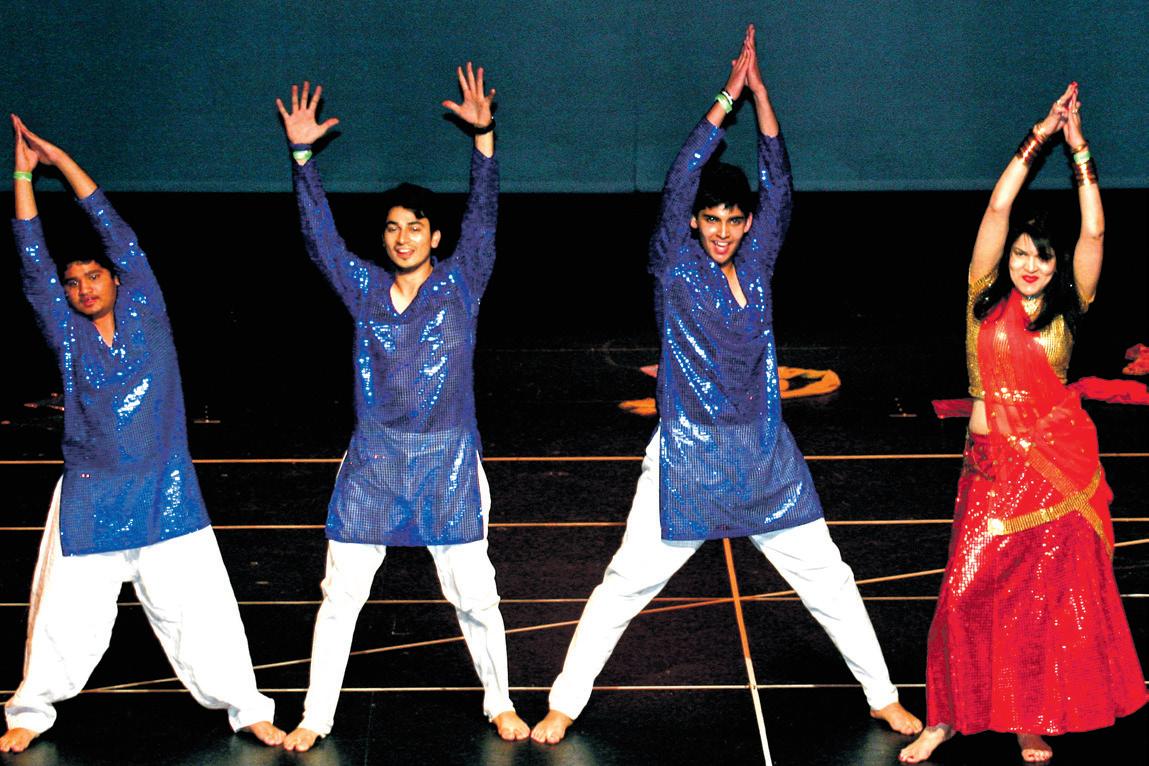 Preeti Jabbal
Preeti Jabbal
JUNE 2012 17 INDIAN LINK CO mmu NITYS CENE
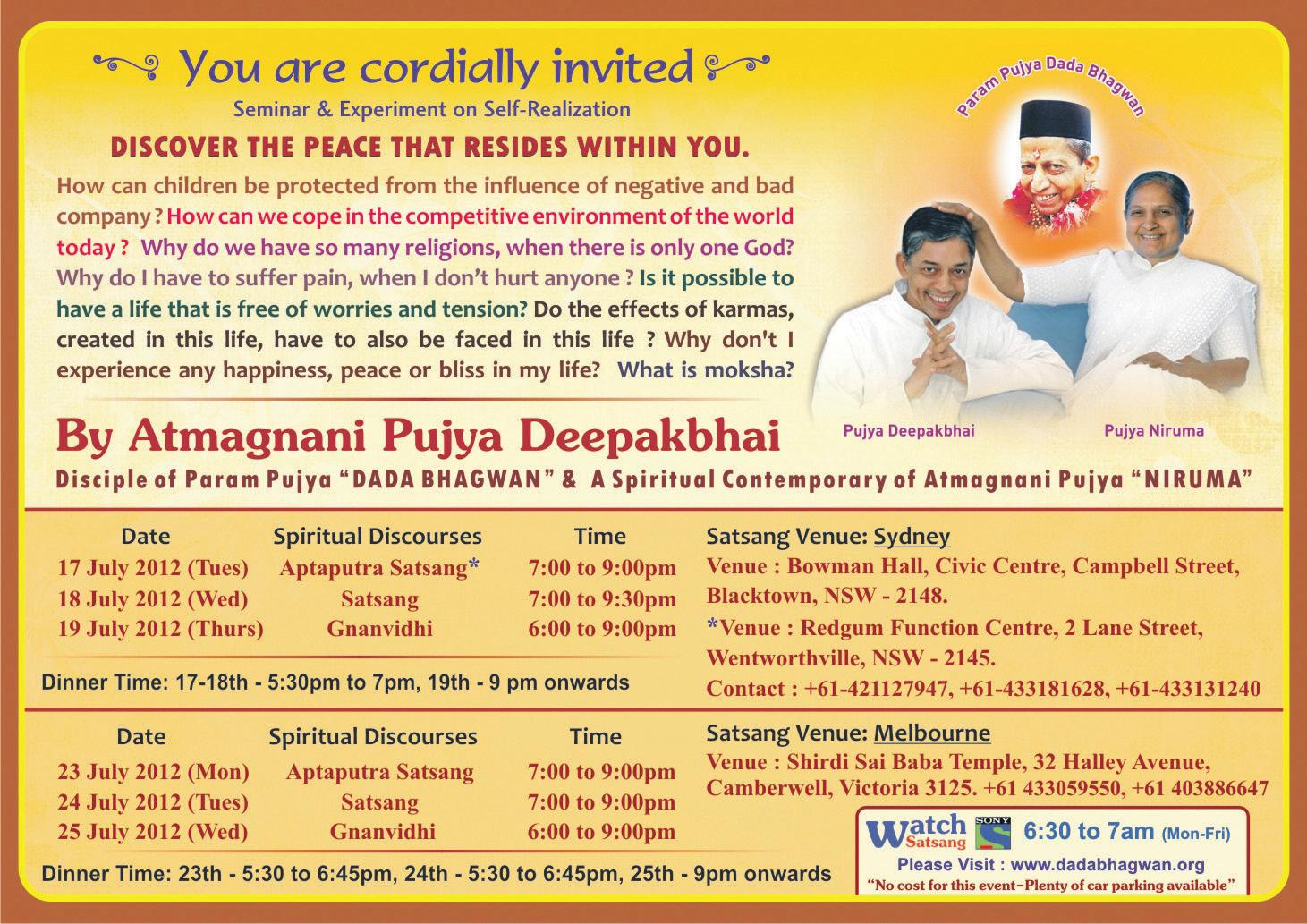

18 JUNE 2012 www.indianlink.com.au



JUNE 2012 19 INDIAN LINK
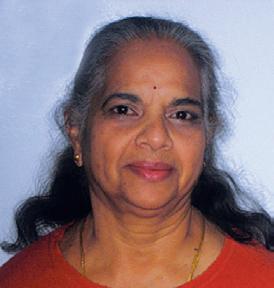
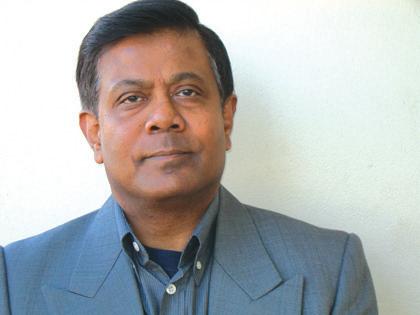
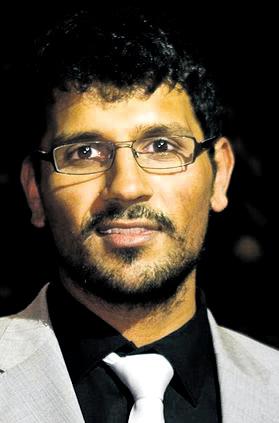
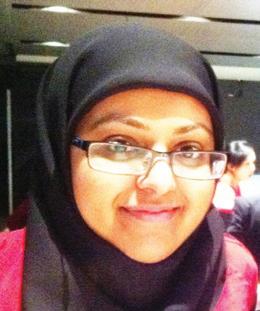
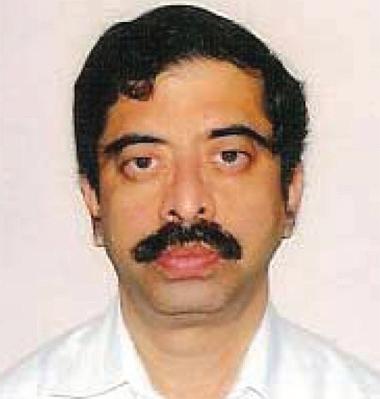
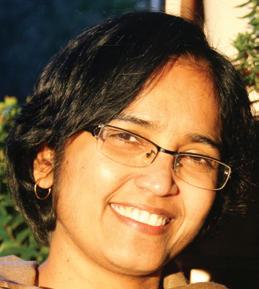
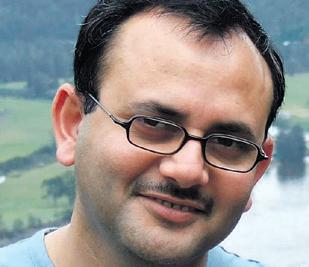
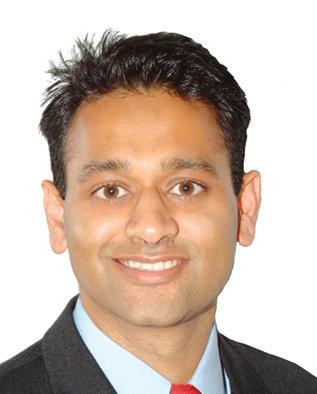
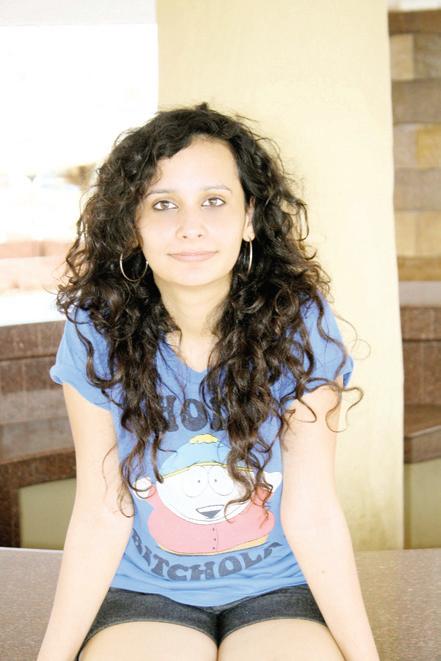

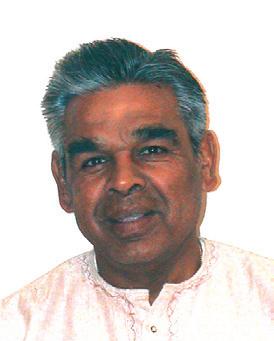
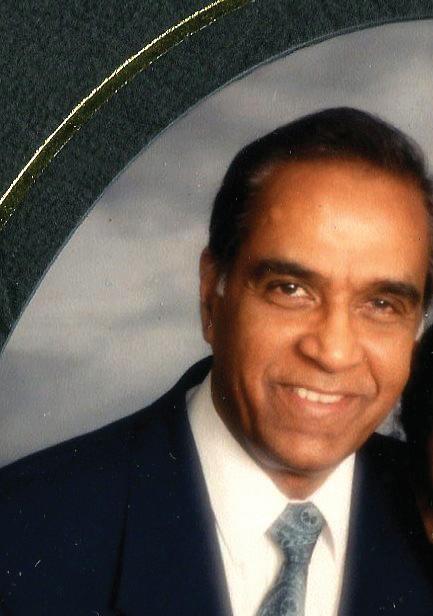
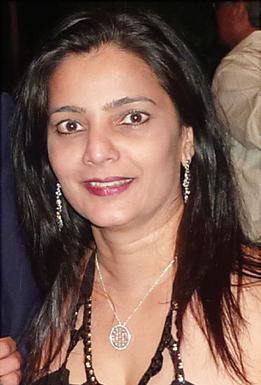
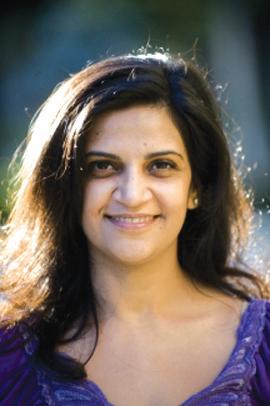
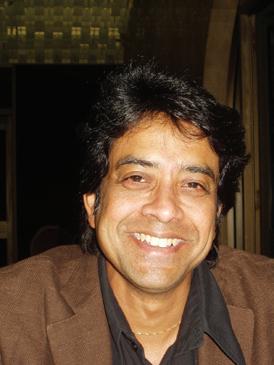
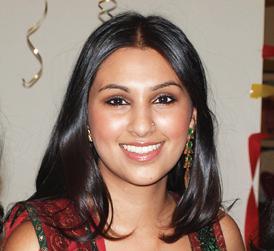
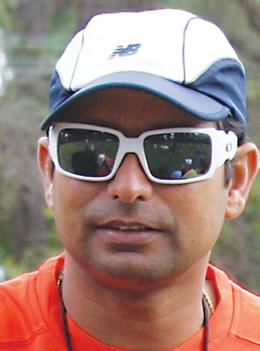

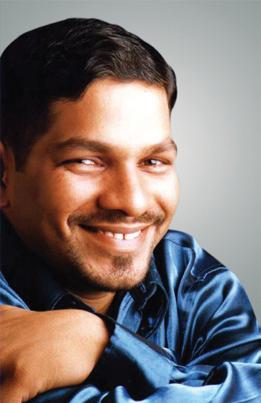
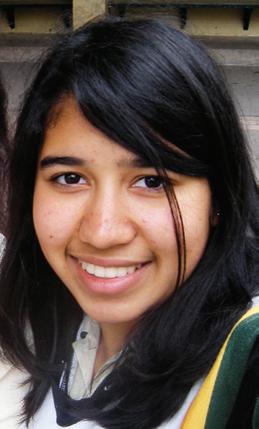
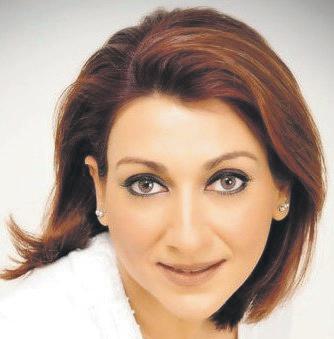
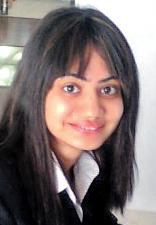
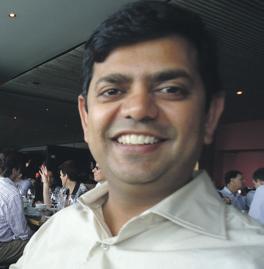
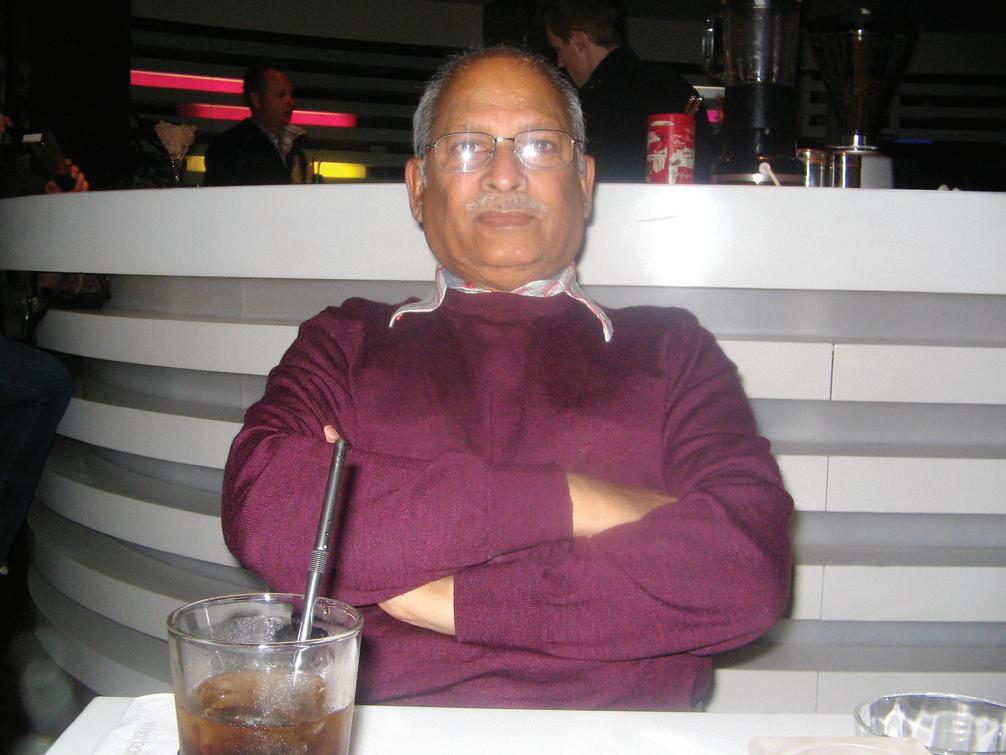



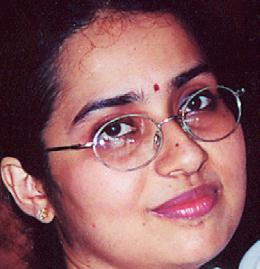
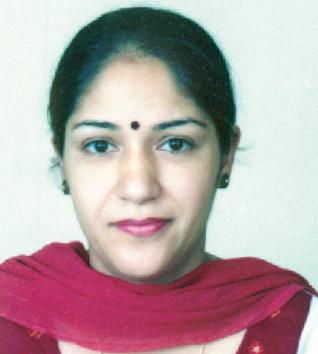
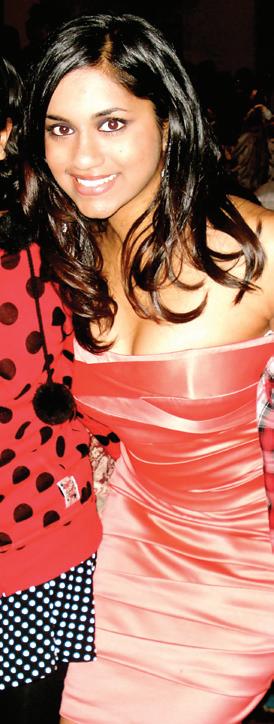

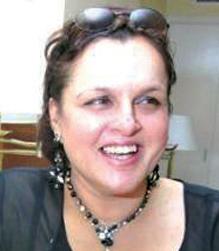
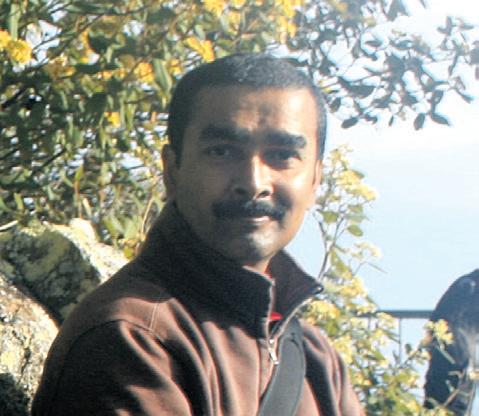
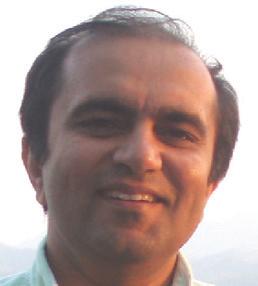
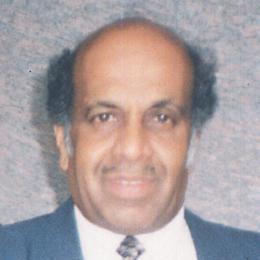
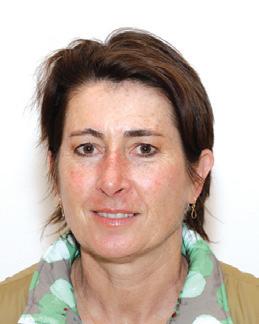
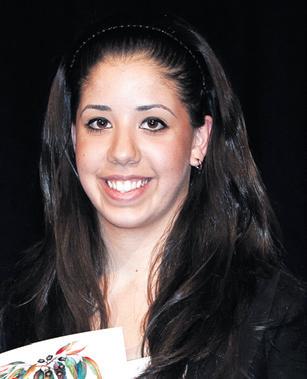
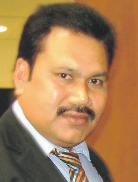
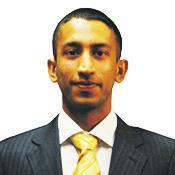

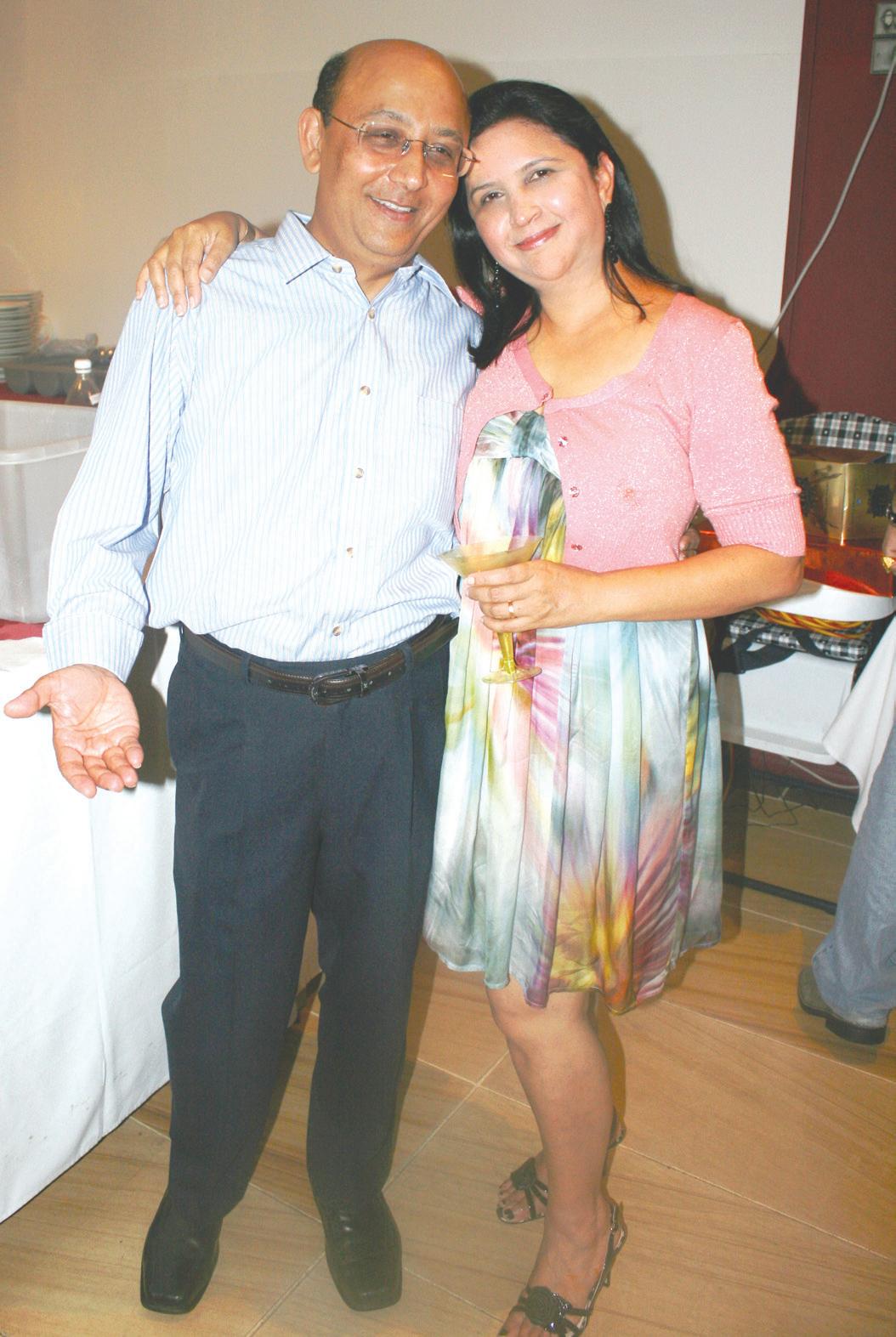
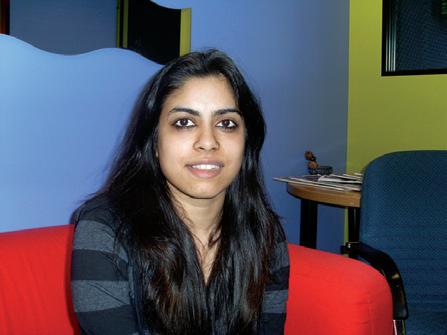
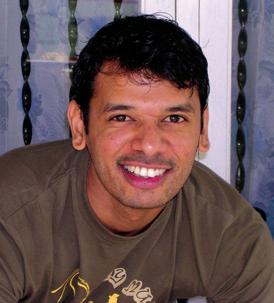
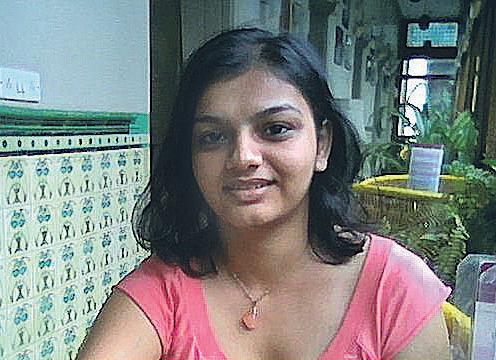
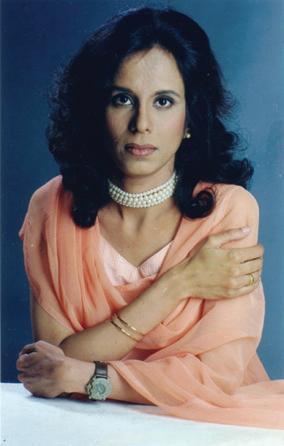
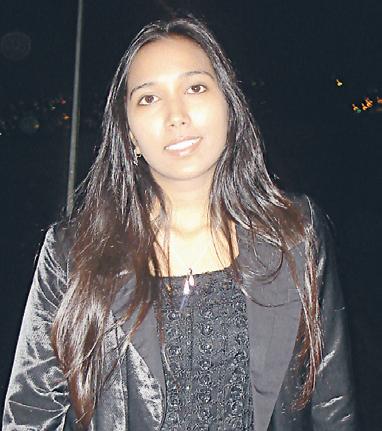
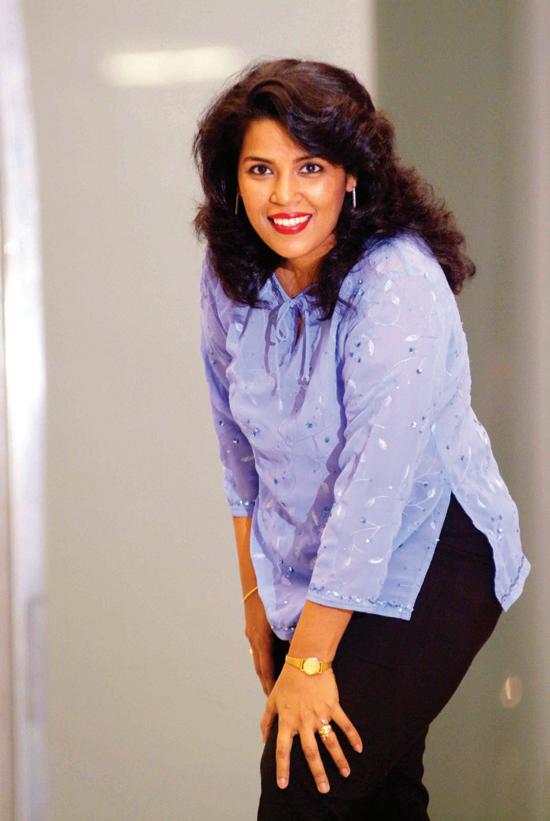
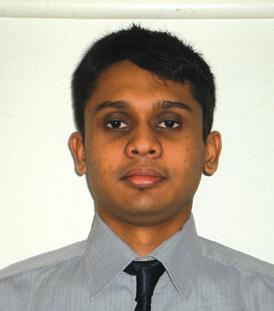

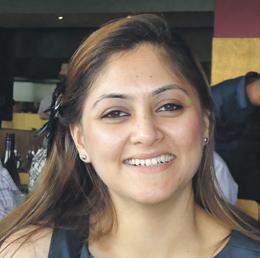


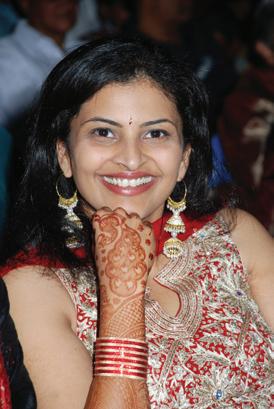
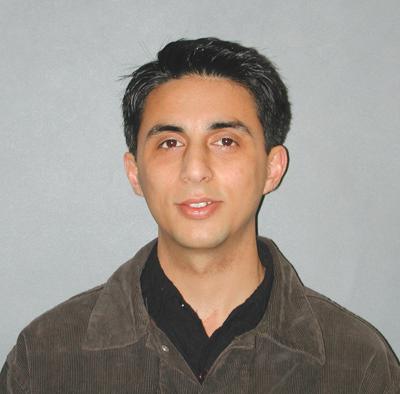
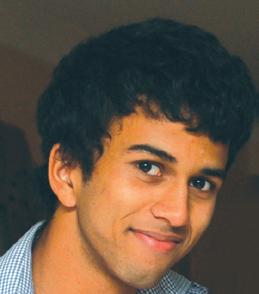
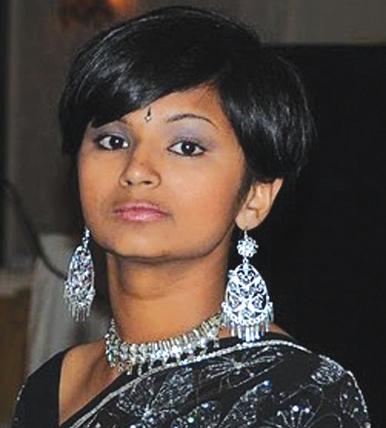
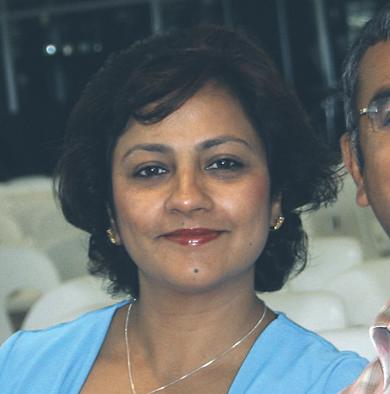

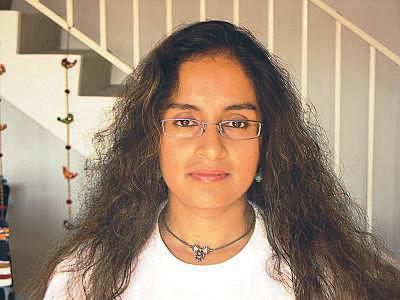

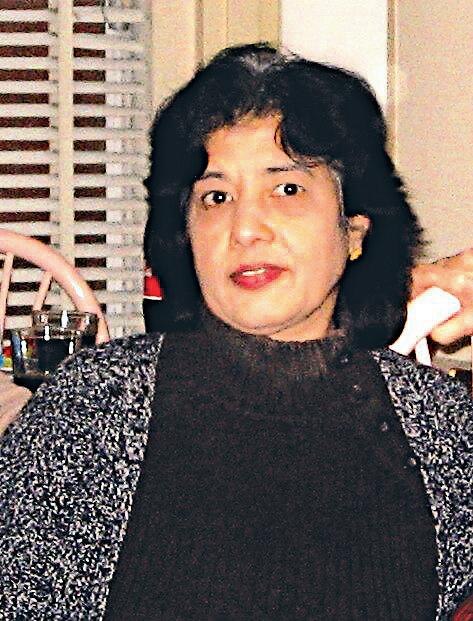

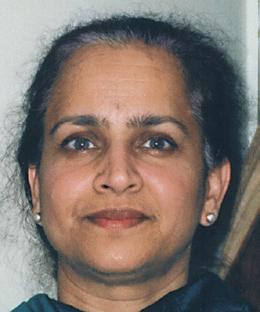
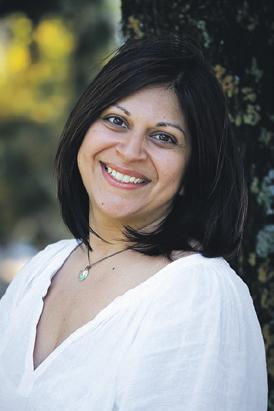

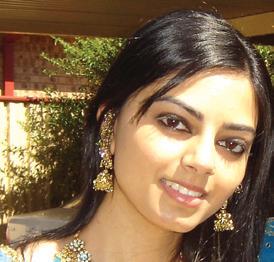
20 JUNE 2012 www.indianlink.com.au MAY 2012 20 INDIAN LINK Indian Link Saroja Srinivasan Noel G de Souza Shafeen Mushtaq Dinesh Ramanan Jyoti Shankar Sandip Hor Sunil Ranadive Hasnain Zaheer Malavika Santhebennur Roy Lange Akriti Goel LP Ayer Tanveer Ahmed Malli Iyer Vidya Muthanna Minnal Khona Azal Khan Avijit Sarkar Noopur Singhal Ruchi Lamba Sanjiv Dubey Preeti Jabbal Pallavi Singhal Sreedhevi Iyer Komal Utsav Jagad Uzma Beg Rajni Anand Luthra Vivek Trivedi Priyanka Tater George Thakur Mark Sharma Gerard Fernandes Farzana Shakir Usha R Arvind Raka Mitra Anusha Menon Tanmayi Chari Nancy Sood Geeta Khurana Drishti Nanwani Uttam Mukherjee Darshak Mehta Talia Kaur Tim Blight Arveen Sharma Petra O’Neill Sukrit Sabhlok Dilip Jadeja Sai Narayan Shraddha Arjun Rani Jhala Sujith Krishnan Shivangi Ambani-Gandhi Neelam Vasudevan Gaurav Surati Priyanka Rao Sheryl Dixit Auntyji Nitika Sondhi Danielle Cairis Sanam Sharma Deepa Gopinath Ritam Mitra Sydney Srinivas Sudha Natrajan Thomas E King Chitra Sudarshan Ashita Vadher Wespendourtime TELLINGYOUR sTORIEs Pawan Luthra Farrha Khan The team at Indian Link

JUNE 2012 21 INDIAN LINK
BATTERY SALES AND FITMENT



22 JUNE 2012 www.indianlink.com.au Well Established Indian Grocery Shop Good Location & Ample Parking For details and enquiry please contact 042 303 6520 / 0402 75 95 45 FOR SALE IMMEDIATE START Call 0406678007 to apply. Full training will be provided. No experience required.
Opportunity to work with the biggest road side assistance company in Australia. Road side car Battery sales and fitting. Duties may include but are not limited to jump-starting, fitting accessories, and installing batteries. Must have excellent spoken English and communication skills to be eligible for the role. Must have manual driving license and ABN No.


JUNE 2012 23 INDIAN LINK

24 JUNE 2012 www.indianlink.com.au
Finding the perfect balance
Iremember my school teacher once said to me, “Character is beauty. Be ever beautiful”. For some reason this line has always stuck in my mind. It tides me through days of bad hair, chipped nails, sleep deprivation… in fact it is a self-esteem mantra that tides me through pretty much all my life. In a society where there is tremendous pressure on women to conform to conventional beauty standards by spending time and money on fashion, cosmetics, hairstyling and cosmetic surgery, a balance is desired by spending equal if not more time on the arts, reading, communicating and contributing to society. There are many women out there who have this balance down pat. Some of these went on to compete in the Ms India Quest that was held at Thornbury Theatre in Melbourne recently.
The stated goal of this beauty pageant was to promote self-esteem and public speaking abilities of the contestants, along with their fashion sense and appearance. Some of the above were tested through various segments including Q&A, fitness, western and ethnic wear rounds. The contest started with a barrage of well-rehearsed introductions from the contestants. While some kept it simple and genuine, others resorted to trite lines on their aspirations to give back to the community. The common theme that came out of the introductions was that most contestants chose to participate in the Ms India Quest as it offered them a platform to celebrate the essence of being a woman. Most contestants were married with children and enjoyed successful careers. Their real lives are not a whirl of hairsprays and sequins but a juggling act of work, chores, kid’s homework and other commitments. Being part of this contest gave them an added sense of accomplishment and boosted
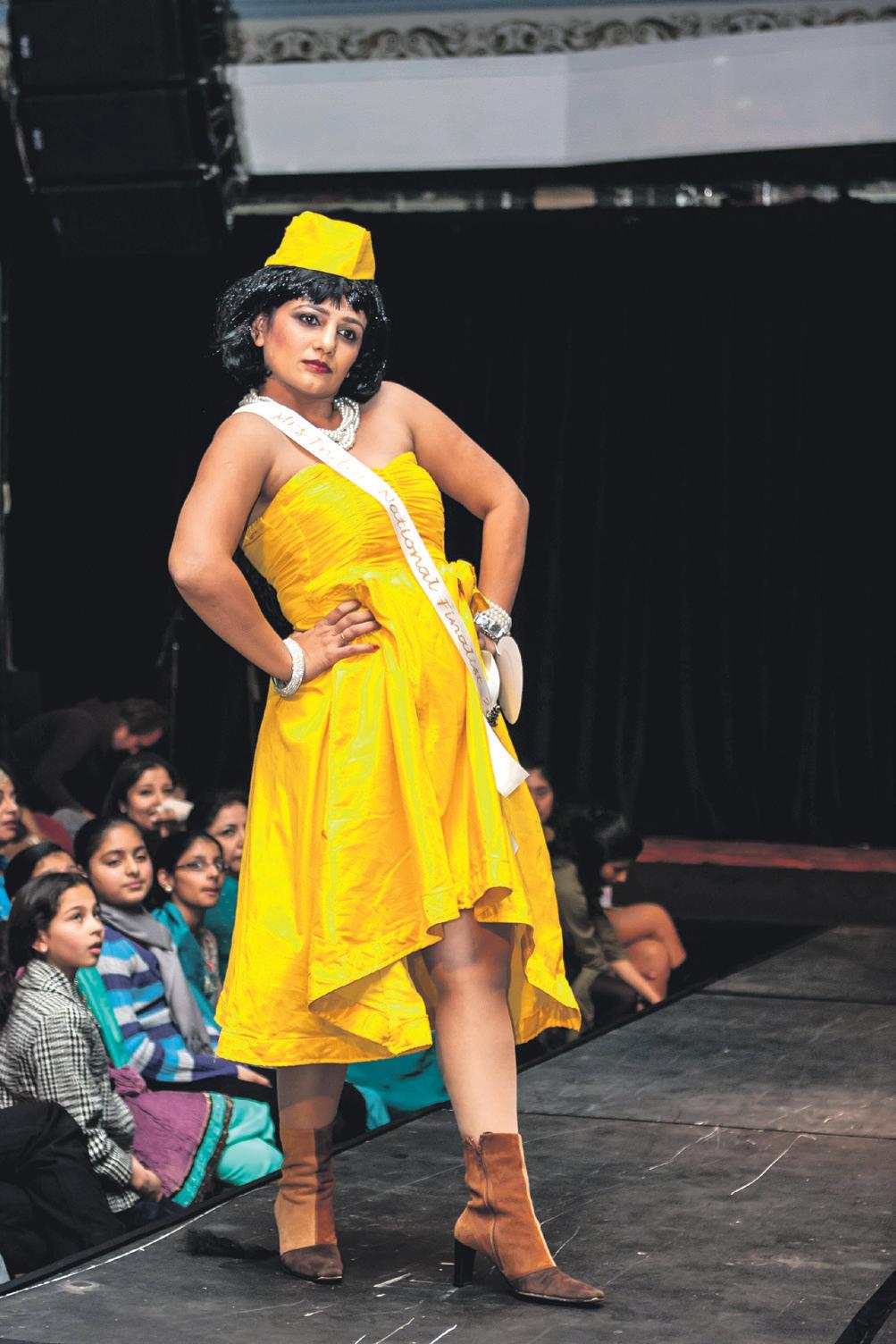
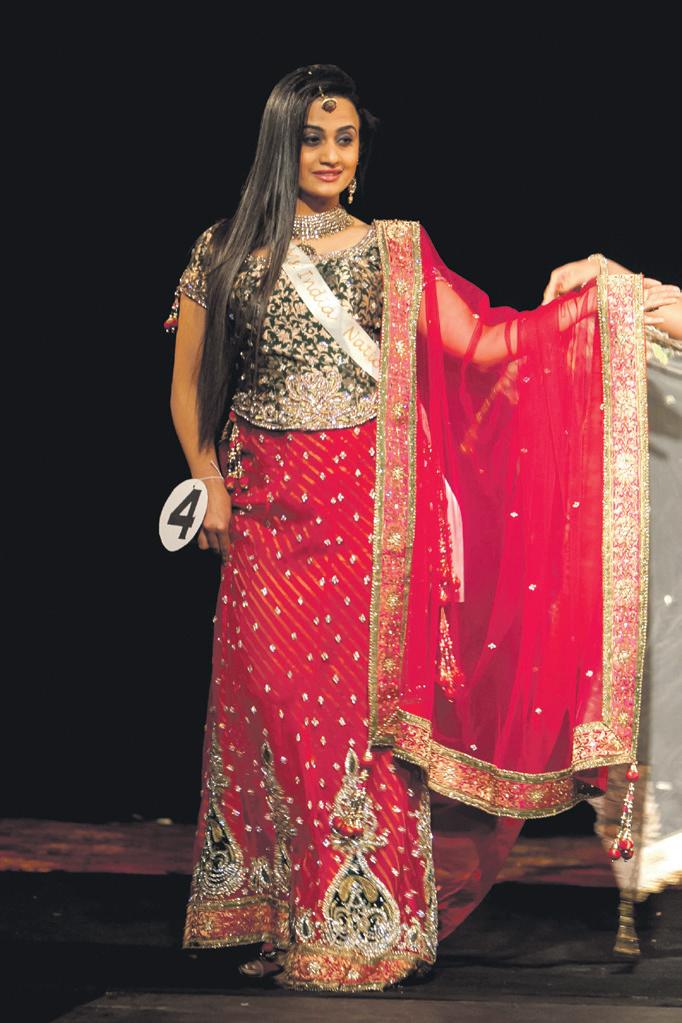
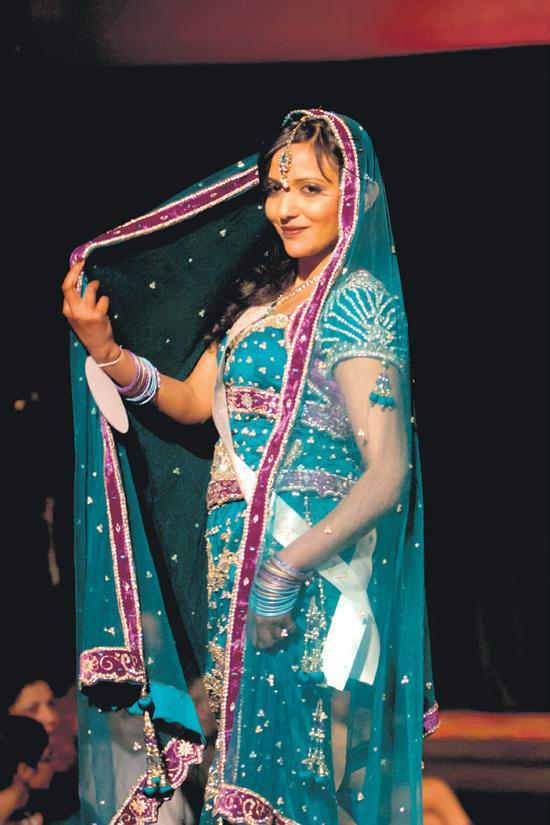
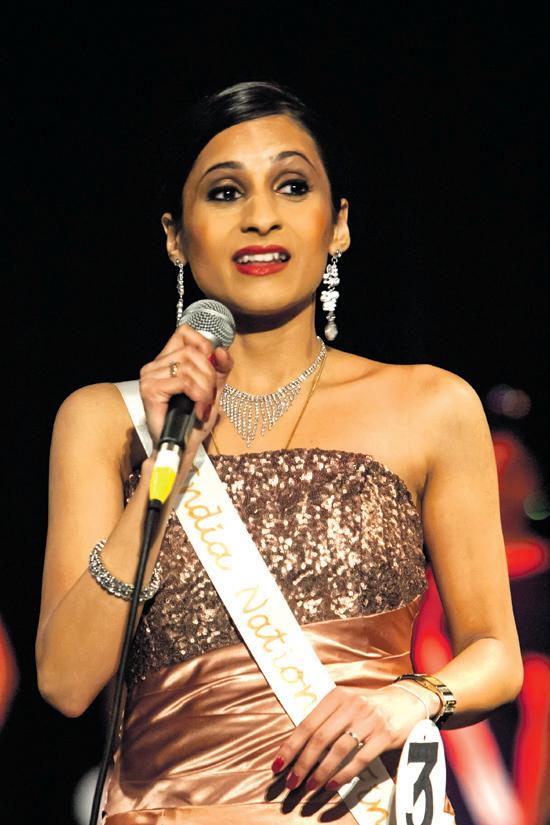
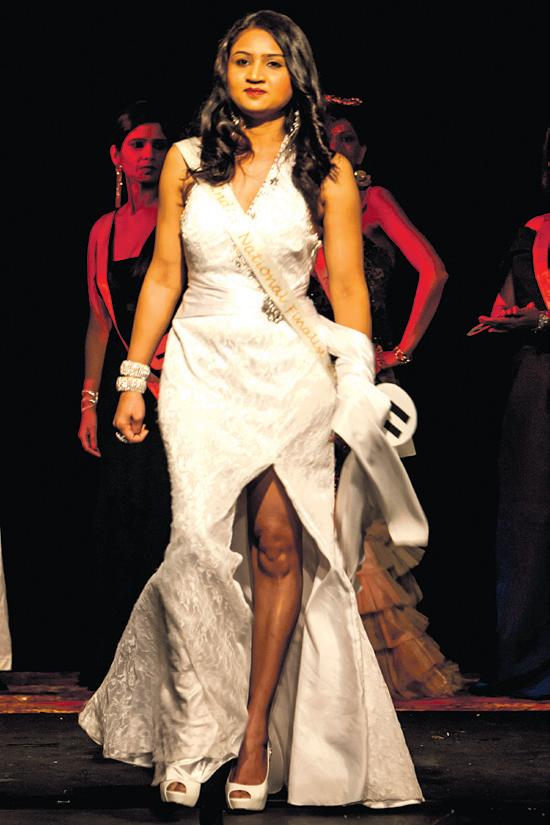
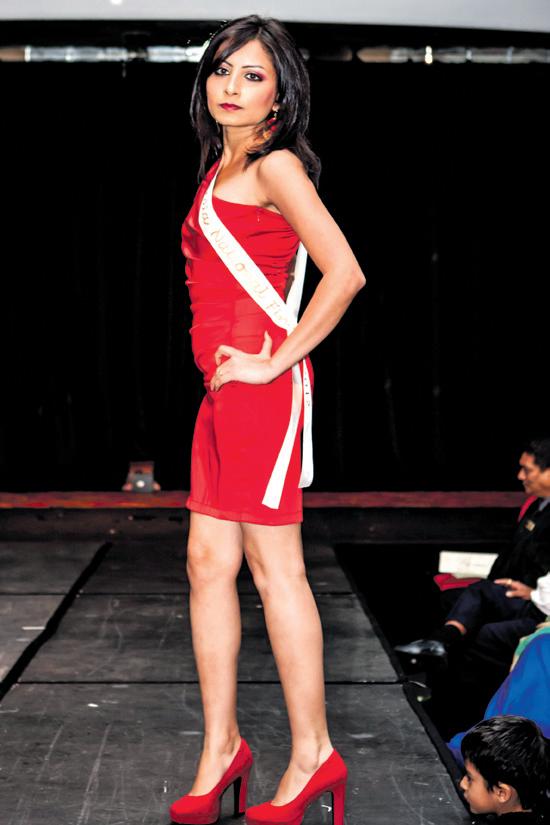
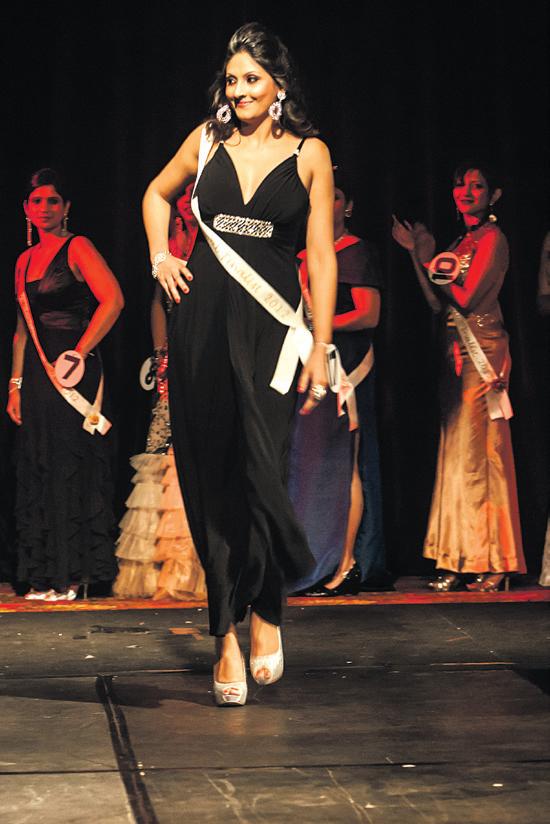
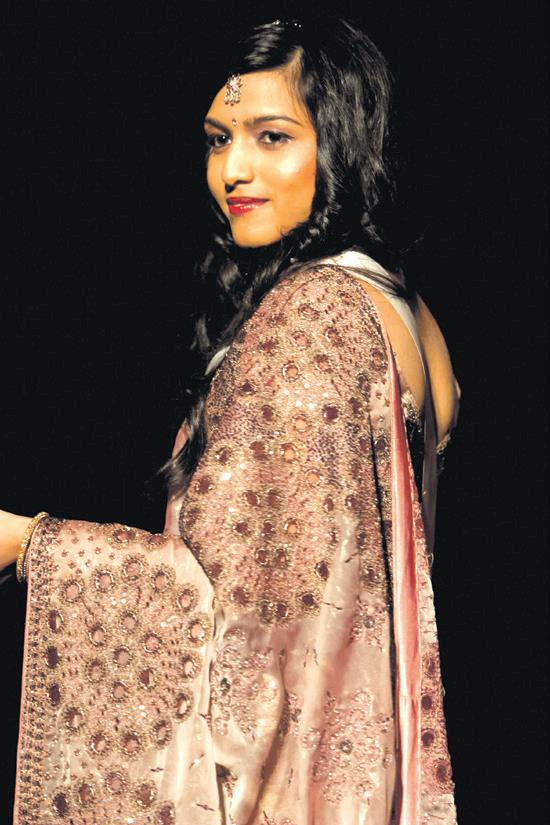
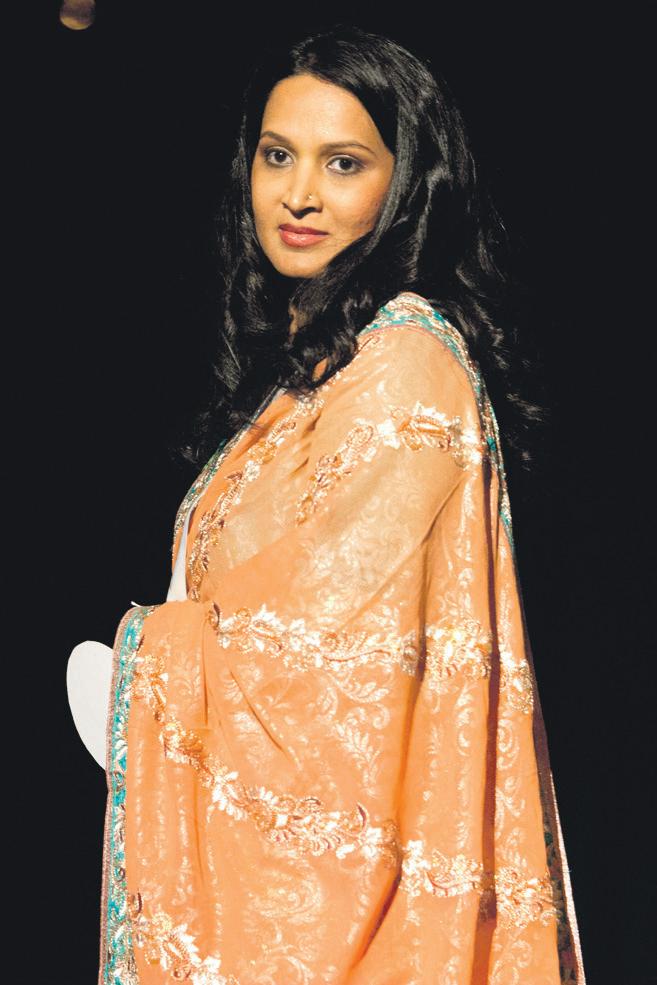
their morale.
Morale was boosted considerably on the night from the enthusiastic applause every contestant received from an appreciative audience. What the event lacked in professionalism was made up with the abundance of support as spouses, friends and families were present to support their own in this sell-out event. All the sponsors of the event got substantial exposure from the organisers thanks to the slide show in the background, an opportunity to catwalk on stage during the event and ongoing mention from the MC Siddharth aka Sid. The vivacious anchor pieced all the elements of the contest together with chutzpah and managed to engage the audience as well as the participants.
Individual personalities of the 17 contestants shone through as they smiled, sashayed, swayed and charmed with confidence, making it tough to decide who would take the crown. The judging panel comprised of Dr Subhakanta Behera, Consul General of India in Melbourne; renowned senior Mrs Krishna Arora; and Melanie, a model associated with the fashion industry for 7 years. Melanie who works for a law firm was the second runner up at the Mrs Australia contest held in 2011.There were some interesting answers to the questions put forward by the judges. A participant claimed that her role model was no star or celebrity; it was her mother-in-law who had inspired her and supported her every step of the way. Another was asked which magazine cover she would like to feature on and she chose The National Geographic as she was an environmentalist and given a chance, she chose to be on the cover of a magazine dedicated to ‘Mother Earth’.
The MIQ crown finally went to IT professional Priyanka Dewan, with Business Analyst Deepti
and Ms India Earth contests to be held later in the year. Said organizer Mrs Anamika Srivastava, “The most beautiful woman in any beauty pageant is the one who has all the conditions to be a real representative. I believe in beauty as an integral concept that includes the development of specific qualities to allow a beautiful woman to stand out among other beautiful women.” Considering this was Anamika’s debut effort at organizing a major pageant the few creases during the course of event could well be ignored. MIQ was understood to be an event that celebrates the ideal woman prototype that includes physical beauty, kindness, charisma, and social sensibility; however the opportunity to explore the latter seemed rather limited on the main evening. It was fun to watch, nevertheless.
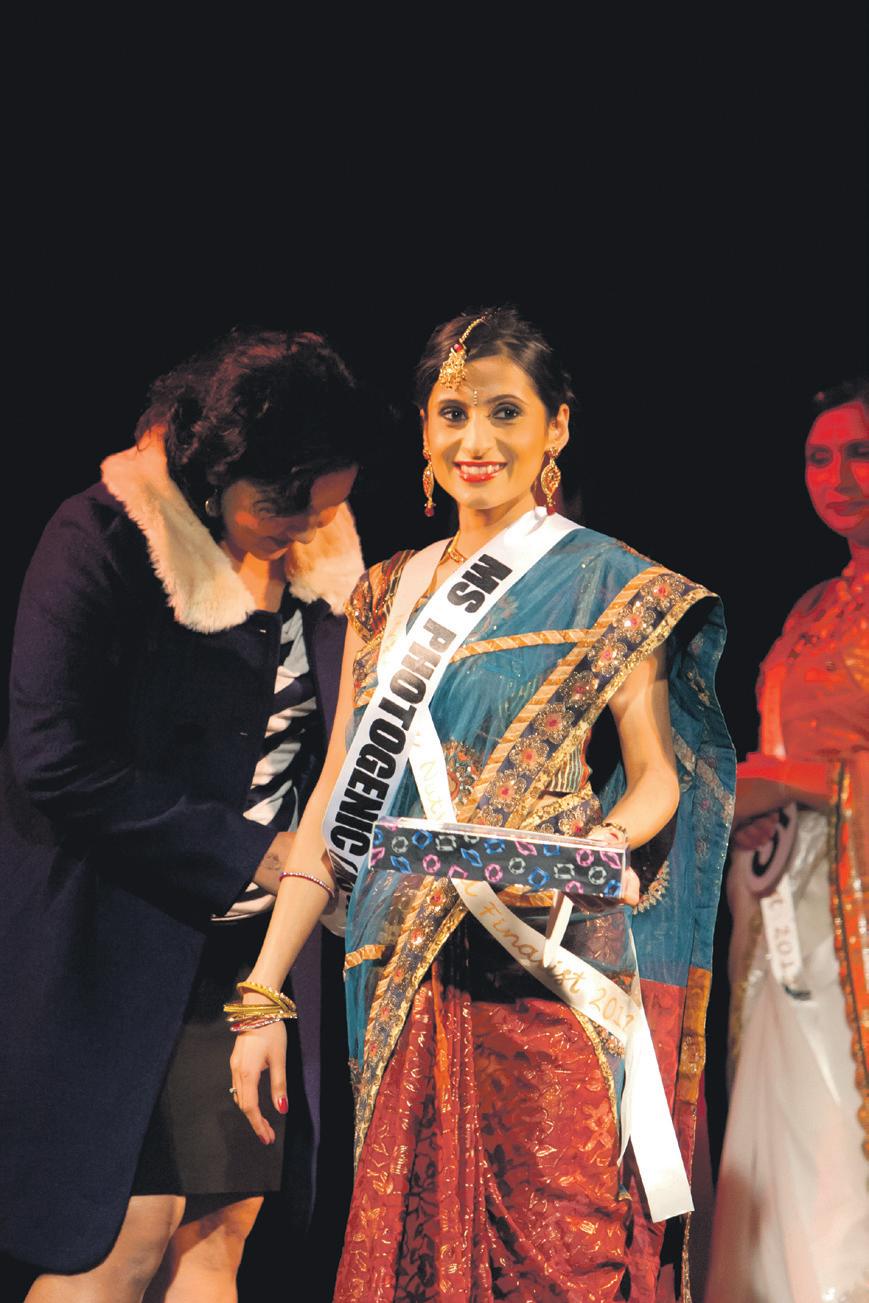
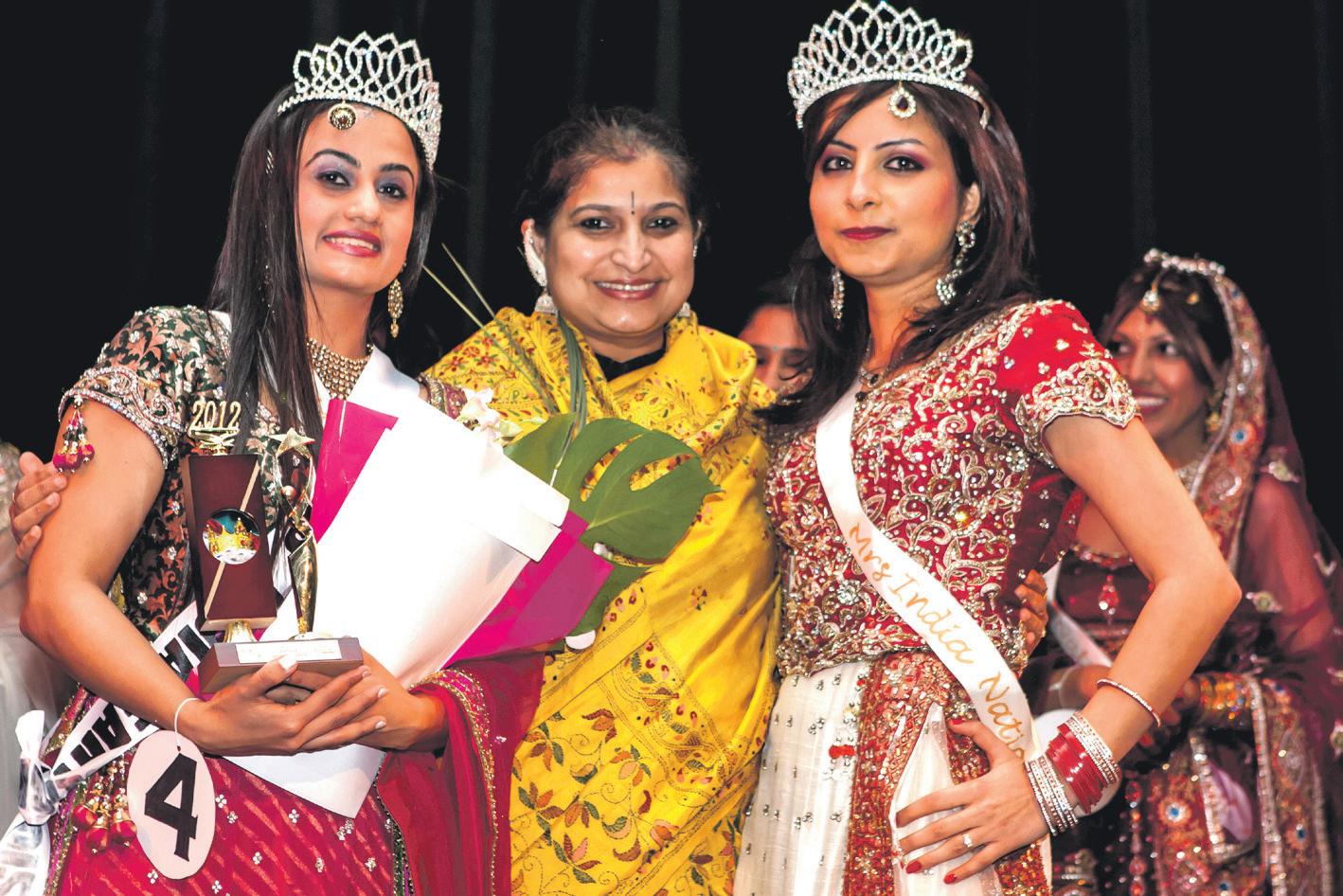
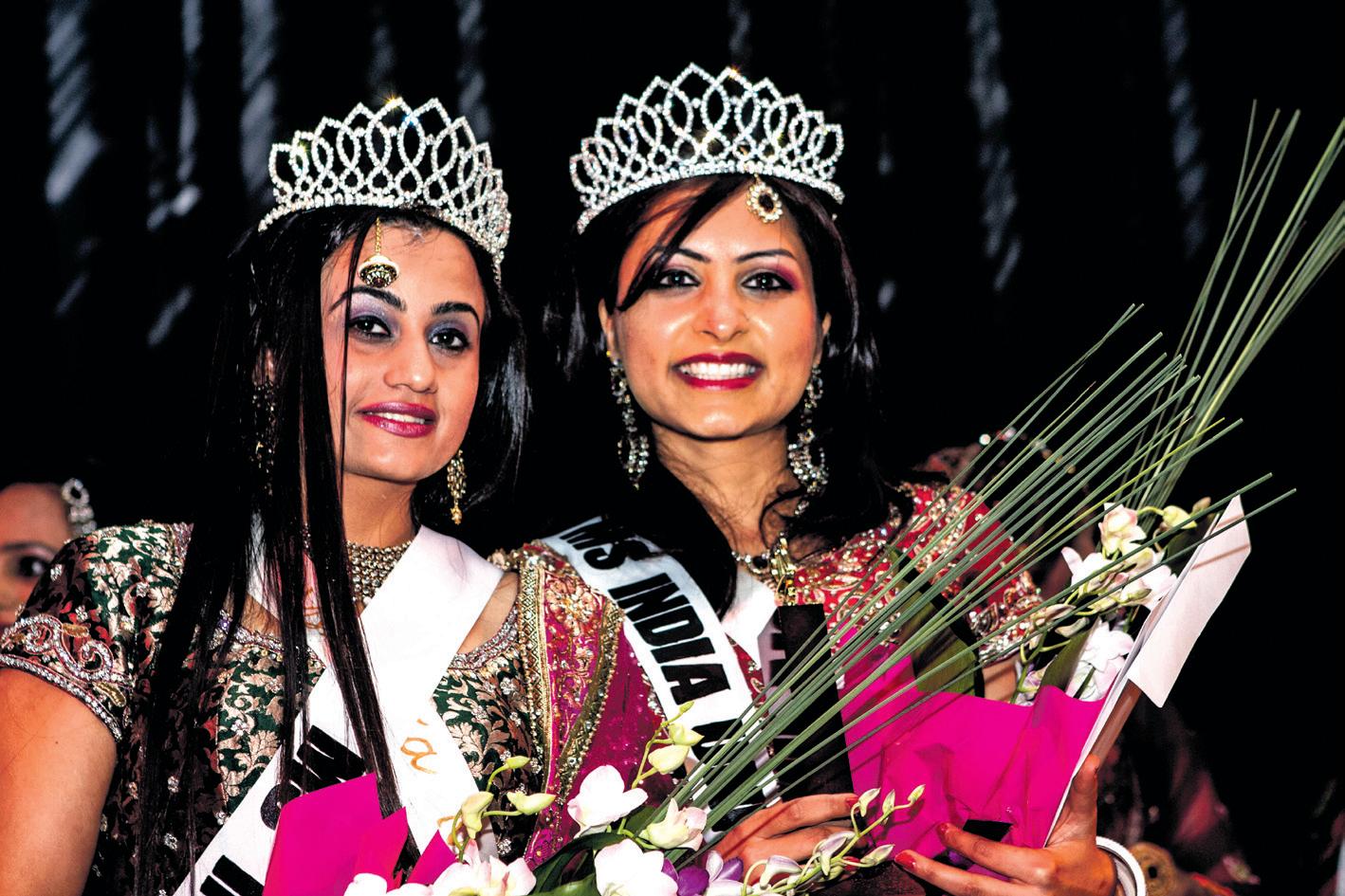 Preeti Jabbal
Preeti Jabbal
INDIAN LINK CommunityS C ene
Several enterprising women showcase their skills at multi-tasking between family, home and themselves in this unique beauty pageant
Photos: Ravinder Singh Jabbal

26 JUNE 2012 www.indianlink.com.au
M.B.B.S, FRANZCOG Obstetrician & Gynaecologist

Nita has worked recently as a Consultant in Obstetrics and Gynaecology at Gippsland Healthcare Group. She has vast experience in Gynaecology and Obstetrics. She worked as obstetrician and Gynaecologist in various Hospital in QLD and Melbourne as well as at Overseas.
Nita gained her specialist Post Graduate degree in Obstetrics and Gynaecology in India and worked as a consultant in New Delhi for 4 yrs. After Moving to Australia she underwent further training to gain her FRANZCOG– Specialist Degree in Obstetrics and Gynaecology. She is fluent in Hindi, Punjabi and English.
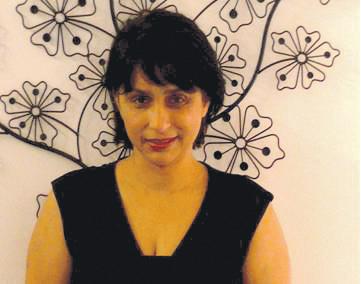
She has started private practice at Melbourne Eastern & South Eastern private Hospital apart from Casey Superclinic and have a operative and delivery at Warragul hospital with consulting session at both Berwick, Pakenham.
After moving to Australia she underwent further training to include FRANZCOG and gained her specialist degree in Obstetrics and Gynaecology in 2010. Nita has worked recently as a consultant at Warragul (W.G.Health) Hospital.
Nita has set up Private Practice in Dandenong with consulting sessions at both Pakenham & Warragul

Obstetrics
• Pre-pregnancy assessment & counselling
• Antenatal, pregnancy management,


• Confinement & Complications
• Management of recurrent pregnancy loss
• Vaginal birth after previous Caesarean delivery (VBAC), RPL & High Risk
• Caesarean delivery
Gynaecological
• Menopause; post-menopausal bleeding
• Vaginal prolapse & Fibroid
• Genital tract infections & CPP
• Abnormal Pap smear; colposcopy
• Pelvic pain & Endometriosis
• Infertility: Diagnosis & assisted treatment
• Family planning, permanent or reversible

• Contraception

JUNE 2012 27 INDIAN LINK
For All Correspondence and Appointments Please Contact: Silk Medical Suites Telephone: 9792-1191 or Fax: 9792-1180 Silk Medical Suites Unit 4, 118– 120 David Street, Dandenong , Vic 3175 Now ALSo CoNSuLTING IN: Eastcare Medical Centre, 1/125 Main Street, Pakenham Private Consulting Suites, Lansdborough St, West Gippsland Healthcare FEE STRuCTuRE Standard fees apply / Pensioners will be at a reduced fee / “No Gap” billing for Private Hospital Admissions OVERSEAS VISITORS/STUDENTS — upfront payments preferred Your Bank will not tell you that their competitor has a better package than them...we will! Suite 7a, 82 Keilor Rd, Essendon VIC 3040 email: enquiries@monopolyfinance.com.au Australian Credit Licence No: 387784 “you could save thousands of $ but you need to pick the right Bank / Lender, let us help you.” Call 1300 763 630 now Our company has been assisting people save money for many years! for a no obligation assessment
The Raaga Sudha School of Carnatic Music held its ninth annual students concert on May 12 and 13 at the Chandler Community Centre, Keysborough, Victoria. The school was started in 2002 with a view to fostering the art of carnatic music, specifically violin and vocal music in the south Indian carnatic music style. Raaga Sudha has since grown in stature rapidly to become a premier institution, having already produced some fine local talent in Melbourne. The founder, guru
and artistic director of the school, Mr Murali Kumar, is a celebrated violinist of Indian classical music, a violin virtuoso who needs little introduction to Indian music and dance circles in Australia.
The two-day event featured several solo vocal, solo violin and group items, all performed with skill and enthusiasm by the students. Students at all levels, whether junior, intermediate or advanced/senior, performed capably and with great confidence and enjoyment. The trademark
of Raaga Sudha students amply stood out in this concert; that is, adherence to classicism, spontaneous innovation or ‘manodharma’ and clarity of musical notes, ‘shruti’ and tonal quality.
The chief guest for the event was the renowned carnatic musician and teacher Dr Rama Rao. In her address she noted that in just a decade’s time the Raaga Sudha school has gained an enviable reputation as a school dedicated to the promotion of new musical talent in the most authentic, yet
innovative, brand of carnatic music. She congratulated Mr Murali Kumar on the development of the school, in particular praising his committed service to promote and foster the classical violin and vocal music forms in Australia through the school. She also expressed admiration for the enthusiasm of the students for this complex music form, and the high quality of the performances.
Dr Rama Rao presented the annual awards to deserving students on day two of the event.
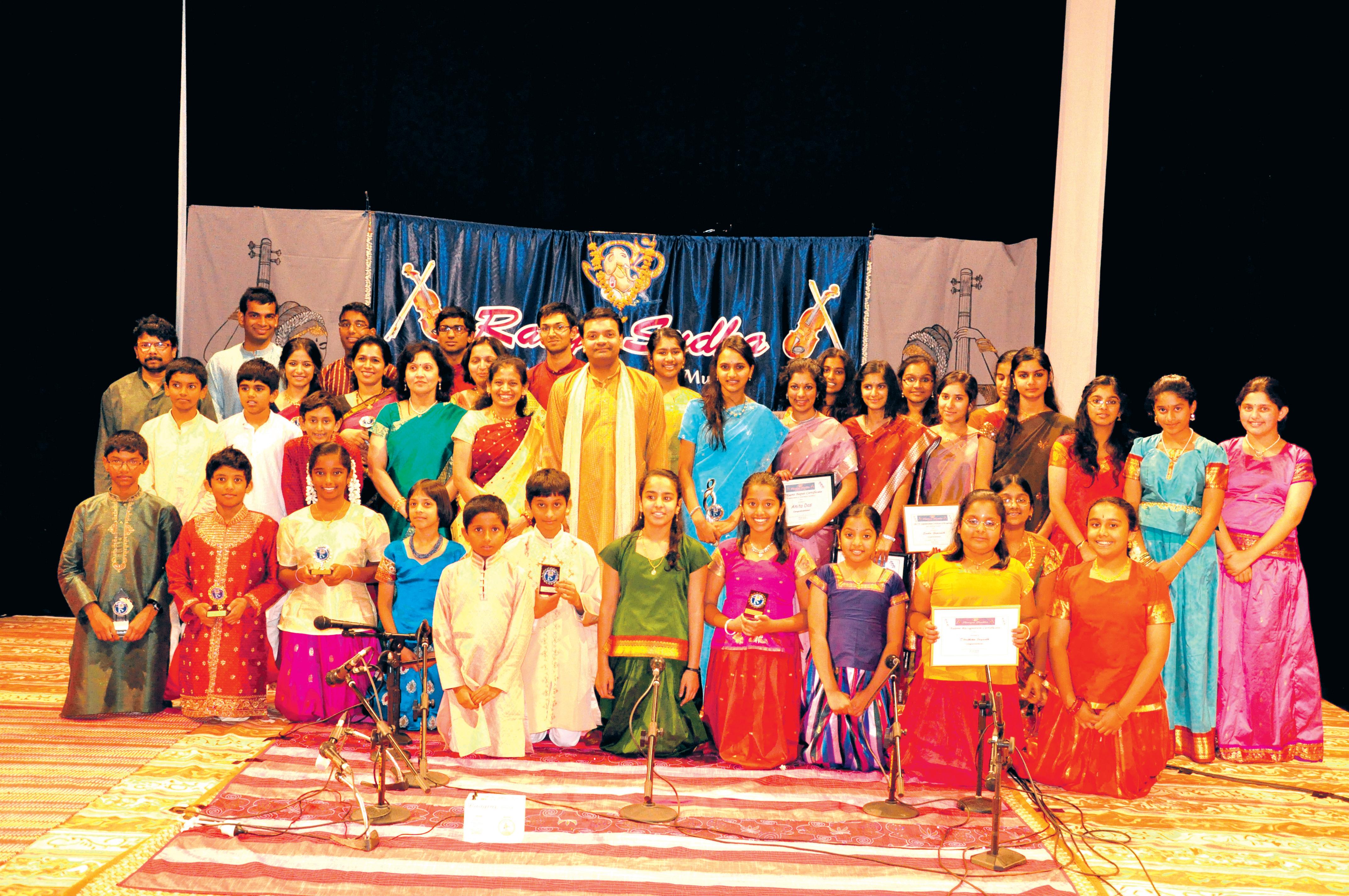
The winners in the beginner, junior and intermediate categories were selected by renowned vocalist Mrs Uthra Vijay, who was the external examiner for these categories. Dr Rama Rao also had deserving words of recognition for Mrs Vandana Kumar’s efficient management and organisation of the school’s activities.
All in all, a wonderful two-day event was successfully completed, and marked another milestone in the growth of Raaga Sudha School of Carnatic Music.
Neeraj’s appeal leads to revised drivers’ licence legislature
In India, it is virtually inconceivable making an attempt to get our message across to politicians unlike here in Australia, where there is a presumably enhanced relationship between the common man and the government. And no one would attest to this fact more than Neeraj Kesarwani of Melbourne, who claims that his action resulted in an amendment to a procedure.
Earlier, a permanent resident with an overseas driver’s licence had a time frame of just three months upon attaining residency status, to convert his/her licence to a Victorian permit. But today, a resident is allowed up to six months to obtain their Victorian driver’s permit and for this, we must be thankful to Neeraj for his determination to enforce an amendment in the licence rule.
Neeraj arrived in Australia in May 2007, and was granted permanent residency in February 2009. With the constant impediment of having to wait for over a month to book in for a driving test, he wrote a letter to former Premier Mr John Brumby explaining the issue, while requesting for a change in the rule of extending the three-month time limit for all migrants. To his surprise, Mr Brumby was not
What’s on
Bharata Natyam performance
Friday, June 15, 7:30pm onwards, at Darebin Arts & Entertainment Centre. Nisha Rajamani & Nithya Iyer will perform Bharata Natyam under the auspices of the Chandrabhanu Bharatalya Academy School of Indian Classical Dance and Music. Enquiries: darpana2012@ gmail.com
Multicultural concert
Saturday, June 16, 11am – 4pm at Box Hill Town Hall, 1022, Whitehorse Road, Box Hill, Vic 3128. Multicultural event sponsored and supported by VMC through Migration Information Centre at which the Chinese, Indian, Indonesian and Vietnamese communities
will demonstrate their culture. Indian Senior Citizens Forum will represent the Indian community and demonstrate dandiya ras, mehndi and yoga. Free event with vegetarian lunch. To attend, contact Siri Krishan Auplish on 9543 6615 / 0424 742 200.
Trivia night
Saturday, June 16, 6pm onwards at Ashwood Hall 12A Electra Avenue, Ashwood. Melways Reference-61 A11. VSA organized Trivia fun night to enjoy with family and friends. Have a drink, eat some pizza, chat, enjoy the music and have a go at the Trivia. Cost: VSA
Members: adults: $10; children: $5. Non-members: adults: $15; children: $7. Includes pizza, snacks and trivia. Drinks
can be purchased at the bar. Register your team by emailing sharon.l.dhillon@gmail.com
MKS Quiz Programme
Sunday, 17 June, 2 - 5pm (registration at 1:45pm) at Fregon Hall, Fregon Rd, Clayton. Melway Ref :70 D12. Essay writing and general knowledge quiz programme. Children can exhibit their essay writing talents and adults can test their GK and IQ, to win attractive prizes. Visit www.mks.org.au for essay topics, word limit and other details. Coffee /tea, biscuits/snacks will be served. Free entry, gold coin donation only.
Sunidhi Chauhan concert
Saturday, June 23, 7pm onwards at The Palais Theatre,
Lower Esplanade, next to Luna Park, St Kilda. Through her career, Sunidhi Chauhan of the Sheila Ki Jawani fame has sung over 3000+ songs for over 600 hit movies and has received over 20 international awards. Tickets are $59, $79, $99, $129, $199, available online from www.ticketmaster.com.au or call Anita on 03 9846 2595
Chandrabhanu –the dream weaver
Saturday, June 23, 7:30 onwards at Alexander Theatre, Monash University Clayton campus. A Grand Bharata Natyam Indian Classical Dance Recital. Phone bookings 9905 1111 or online bookings www.monash.edu/mapa
only quick to respond, but also acknowledged his concern and immediately advised Vic Roads to modify the “Migration Act of 1958” and allow migrants a period of six months to obtain the Victorian driver’s permit. Not one to take things lying down, Neeraj has shown us that it’s always good to give something a go before settling for denial.
Sujith Krishnan
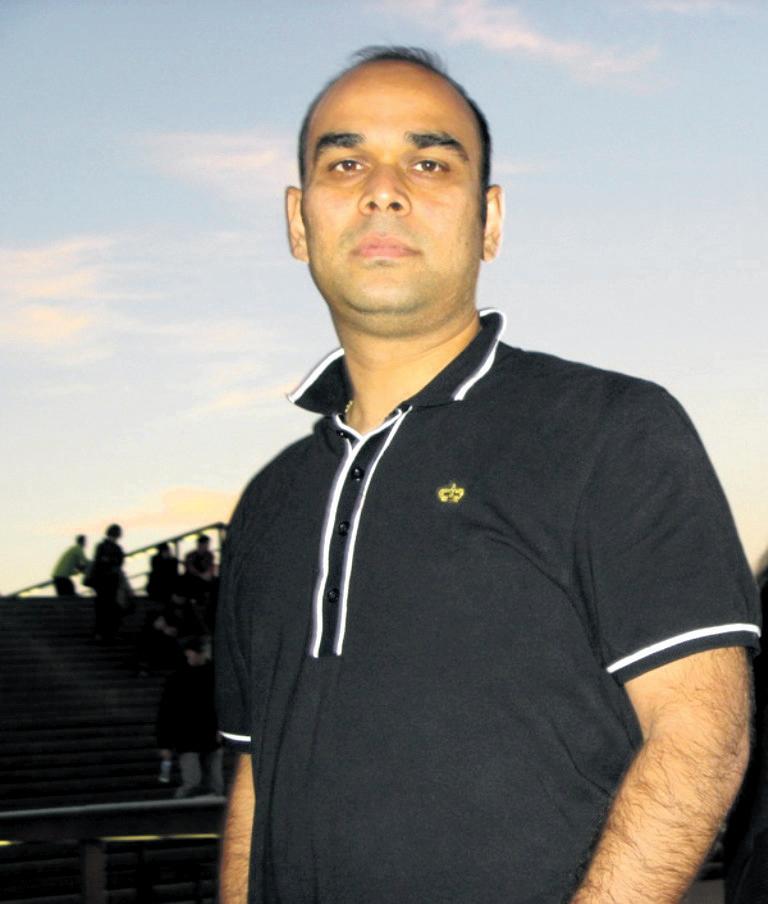
Voyages Multicultural Arts
Concert Sunday, June 24, 3pm onwards (doors open at 2pm) at St Kilda Town Hall, 99A Carlisle Street St Kilda. Directed by international guitar virtuoso Mathew Fagan, the show will feature world musicians from India, China, Europe, The Far East, Africa, Brazil and Indigenous Australia. Tickets: $20/ $15 Concession + BF $40 (Family- 2 Adults + 2 Children). A proportion of ticket sales will be donated to the Port Phillip Community Group towards their food parcel program. Tickets available at www.moshtix.com. au,1300 GET TIX (438 849). For further information contact Kellie Grattidge 95107720 / 0438881985 mjb2fagan@ gmail.com


JUNE 2012 29 INDIAN LINK Baggage30Kg Baggage30Kg From$855* $855* Departure Till 17th Nov Email: info@worldtravelhub.com.au Call Us On: Mel: 03 9005 0956
effort aimed at fostering transparency and enhanced citizen engagement by making government data, documents, tools and processes publicly available.
The event was part of the US-India joint commission meeting on science and technology Cooperation held in Washington DC recently.
India’s Science, Technology and Earth Sciences Minister Vilasrao Deshmukh and Dr. John P. Holdren, Assistant to the President for Science and Technology and Director of the White House Office of Science and Technology Policy, and Minister co-chaired the event.
“The Open Government Platform is a new kind of collaboration and it can benefit the entire world of communities through greater government transparency and better customer service for all our citizens,” said Holdren.
“It leverages out technological skills and our strong commitment to produce more transparent and open government.”
OPGL is built on open source code and will be available to any government around the world, for free, officials said.
The launch “marks a very important milestone” in government collaboration and transparency, said Robert Blake, assistant secretary of state for South and Central Asia.
The two sides also pledged to step up their bilateral collaboration in the field of science and technology to boost innovation in key areas of clean energy, environment and high technology to spur economic growth.
Noting that bilateral relations in science and technology research and development have been strengthened, Deshmukh
relations have increased measurably in the areas of maritime, agriculture and bio diversity, basic and applied sciences, advance telecommunications, energy and commercialisation of new technologies,” Holdren said.
“We find an emerging Indo-US eco system based on co-investment and co-development. Basic research has got a boost by expanding collaboration between the National Science Foundation and Department of Science and Technology in India”, the Indian Ambassador to the US, Nirupama Rao, said.
Obama names IndianAmerican as federal judge Chandigarh-born Indian-American legal luminary Srikanth ‘Sri’ Srinivasan was recently nominated by President Barack Obama to what is “often called the nation’s second-highest court”, the US court of appeals for the American capital.
Srinivasan, 45, who in August last year was named principal deputy solicitor general of the US, succeeding another Indian American, Neal Kumar Katyal, creates history in becoming the first South Asian to be ever nominated to the circuit court. If confirmed, he will be just the third South Asian named to any federal judgeship.
Along with Srinivasan, the president also nominated Caitlin Halligan, to also serve on the same court.
“Caitlin Halligan and Sri Srinivasan are dedicated public servants who will bring their tremendous experience, intellect, and integrity to the US Court of Appeals for the District of Columbia Circuit,” Obama said.
Noting that “This important court is often
called the Nation’s second-highest court,” he said: “Srinivasan will be a trailblazer and, like Halligan, will serve the court with distinction and excellence.”
A White House statement said Srinivasan is a highly-respected appellate advocate who has spent a distinguished career litigating before the US Supreme Court and the US Courts of Appeals, both on behalf of the US and in private practice.
Srinivasan was born in Chandigarh and grew up in Lawrence, Kansas. He received his BA with honours and distinction in 1989 from Stanford University and his JD with distinction in 1995 from Stanford Law School, where he was elected to Order of the Coif and served as an editor of the Stanford Law Review.
He also holds an MBA from the Stanford Graduate School of Business, which he received along with his JD in 1995.
Srinivasan began his legal career by serving as a law clerk for Judge J. Harvie Wilkinson on the US Court of Appeals for the DC Circuit from 1995 to 1996.
He received the Attorney General’s Award for Excellence in Furthering US National Security in 2003 and the Office of the Secretary of Defence Award for Excellence in 2005.
In 2007, Srinivasan became a partner with O’Melveny & Myers LLP. In 2011, he was named the chair of the firm’s appellate practice group. He was named as the Principal Deputy Solicitor General in August 2011.
US exempts India from Iran oil sanctions
The US recently exempted India and six other nations from its tough Iran oil sanctions for significantly reducing their oil purchases from Tehran.
Besides India, Malaysia, South Korea, South Africa, Sri Lanka, Turkey and Taiwan too have been added to the exemption list, leaving China and Singapore, the top two buyers of Iranian crude, still exposed to possible penalties by the end of June.
They “have all significantly reduced their volume of crude oil purchases from Iran,” Secretary of State Hillary Clinton said of the countries added to the exemption list.
“By reducing Iran’s oil sales, we are sending a decisive message to Iran’s leaders: Until they take concrete actions to satisfy the concerns of the international community, they will continue to face increasing isolation and pressure,” Clinton said.
“We have implemented these sanctions to support our efforts to prevent Iran from acquiring a nuclear weapon and to encourage Iran to comply with its international obligations,” she said.
“The US remains committed to a dualtrack policy that offers Iran the chance to engage seriously with the international community to resolve our concerns over its nuclear programme through negotiations with the P5+1,” she said.
“Iran has the ability to address these concerns by taking concrete steps during the next round of talks in Moscow. I urge its leaders to do so,” Clinton said.
Clinton announced in March that an “initial group” of countries - Japan and 10 European Union nations - had “significantly reduced” their Iranian oil purchases and thus qualified for an exemption under a sanctions law for a renewable period of 180 days.
India and South Korea, recently exempted, were the third- and fourth-largest buyers
of Iranian oil in the first half of last year, according to the US Department of Energy.
Under the US law enacted Dec 31, nations have until June 30 to demonstrate they have “significantly reduced” the volume of their Iranian crude purchases -- or their banks that settle oil trades with Iran may be cut off from the US financial system.
In Rajya Sabha, Tendulkar to help other sports too
Cricket legend Sachin Tendulkar, who took oath as a Rajya Sabha member recently, vowed to help other sports as well and said he would be liked to remembered as one who contributed to the country and not just cricket statistics.
Speaking after taking oath as a nominated member, Tendulkar told reporters that he might face obstacles but hoped to carry on with help from fellow parliamentarians. He and his wife Anjali met Minister of State for Parliamentary Affairs Rajeev Shukla in the chamber of Rajya Sabha chairman Hamid Ansari.
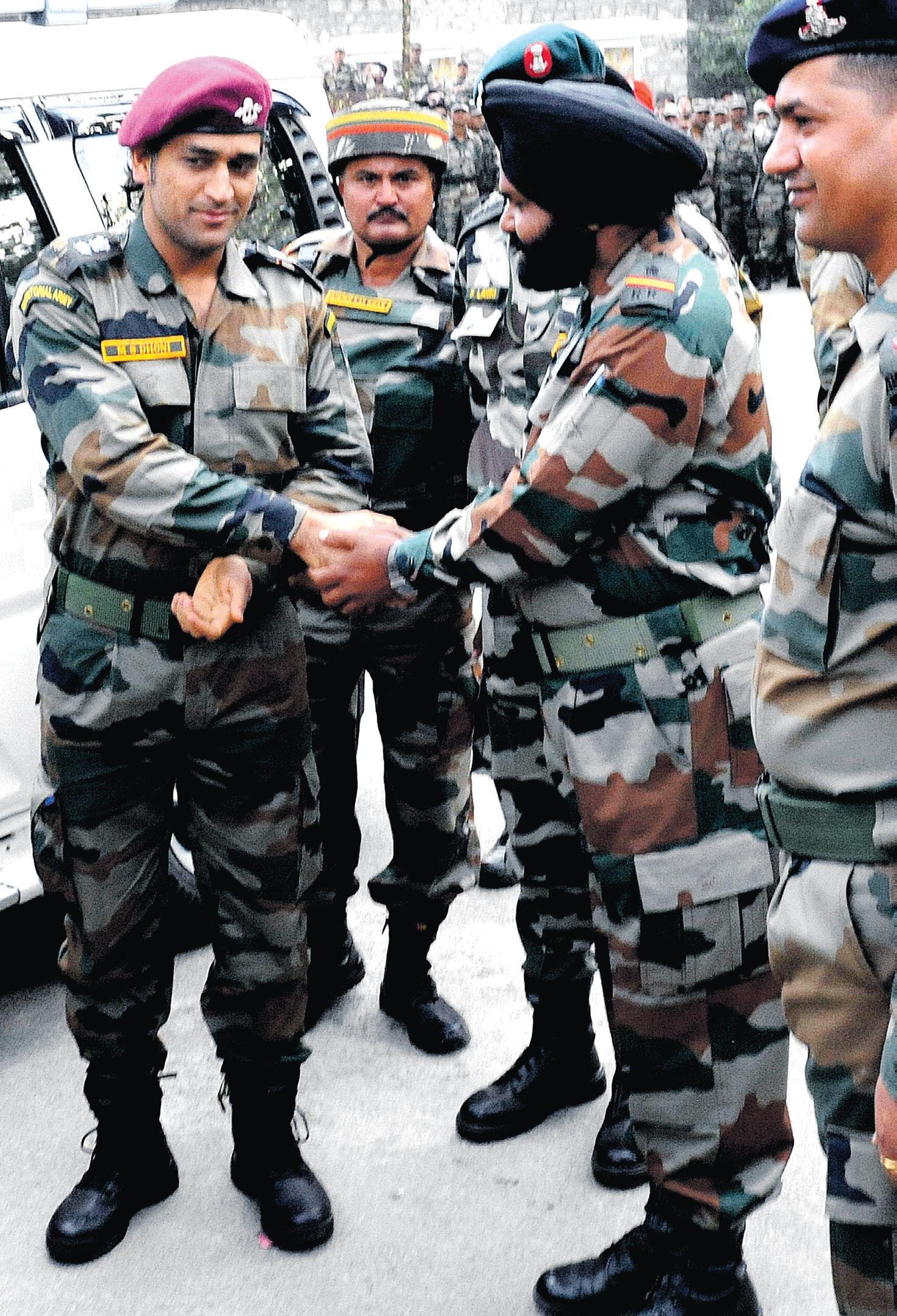
“In the last 22 years of my international career, cricket has given me so much. I also wanted to give something back to cricket in the latter half of my life,” Tendulkar said.
“Today with the nomination, I am in a better position not only to help cricket but also other sports. It means a lot to me.
“I believe there will be a few obstacles along the way, and I will need (help) from my fellow parliamentarians, the administrators, media and our countrymen. Together we can make a lot of changes,” he added.
The batting maestro said he would like to be remembered as somebody who contributed to all sports in India “rather than just cricket statistics. That would be fantastic”.
Asked if he will find enough time for parliament, Tendulkar made it clear that his first priority would be cricket.
“I did not go to anyone asking to be a Rajya Sabha member. It’s an honour and I accept that with respect.
“But I am here because of my cricket. I can’t take my focus away from cricket because that is where it all started for me.”
Tendulkar also said that he will focus on his game, and as and when he gets time he would contribute not just for cricket but for other sports as well.
“At this moment my focus will be on cricket, and as and when, there is time in between, I will look at other things, and see how I can help and bring in whatever changes.... not only cricket but all other sports.”
A battle won for girls’ education in male bastion
It has been a tough battle for Faiza Nisar Ali who helped steer the entry of girls into the erstwhile male bastion of the historic AngloArabic School.
Fazia and the struggle of many other Muslim women created history when the school admitted girls for the first time in its over 300-year-old existence.
Faiza’s fight began in March when she was appointed to prepare a feasibility report on why Muslim boys and girls should study under the same roof.
She had to contend with numerous pitfalls along the way, including frantic phone calls from community hardliners trying to dissuade her, being blamed for scripting something “un-Islamic”, countless sleepless nights and also the trauma of a miscarriage.
30 JUNE 2012 www.indianlink.com.au
in D i A n ne WS
Photo: AP
Indian cricket team captain and honorary Lieutenant Colonel in Indian Territorial Army, Mahendra Singh Dhoni makes a two-day visit to the IndiaPakistan Line of Control at Bhimbher Gali forward post about 200 km from Jammu, the winter capital of Kashmir, 02 June 2012. Dhoni was commissioned in the Territorial Army and became honorary Lieutenant Colonel in 2011. This is his first official visit to forward posts of the Kashmir region.
with educationists, psychologists and parents, I concluded in my report that co-education among Muslims would result in greater progress and help them in the later stages of life,” said Faiza, who is in her thirties and is the business studies teacher at the same school for over six years.
She recounted the events with moist eyes.
“After the report was done, the staff became very resistant. The teachers went against me and I was held liable for being un-Islamic,” she said.
The report spoke on how co-education could boost academic performance of both the sexes, a feasibility into the structure of the Anglo-Arabic school and its importance and it also highlighted that Muslim parents wanted their girls to go to a co-ed institution.
Despite facing internal resistance from the predominantly male school staff, the managing committee of the school in a meeting on March 26 decided to open its doors to girls.
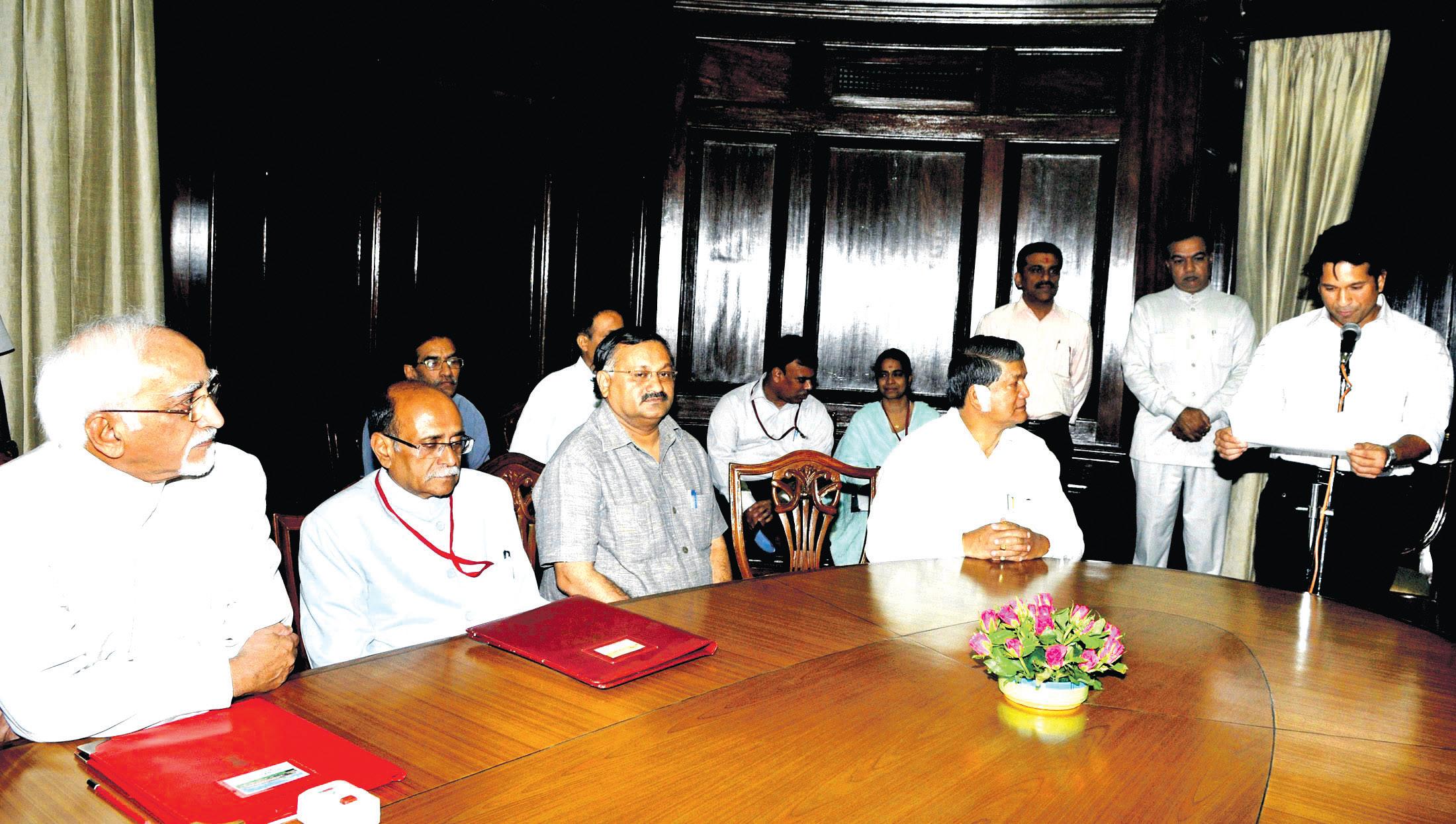
The decision was considered historic for the school, located at Ajmeri Gate, in the old quarters of Delhi.
However, the landmark decision did not end Faiza’s agony.
While her family was supportive about the step she had taken, the mental pressure due to the angry reactions brought her to hospital.
Then eight weeks pregnant, Faiza went through a miscarriage. But she was gutsy enough to pursue her dream.
“I had this invisible pressure about how to face colleagues in the school. I had gone through a lot, but I did not want to leave it in the middle,” the mother of a five-year old admits, adding that her “mother had even suggested her to distance herself from all the activities”.
Her cause got a stronger voice when more Muslim women joined the cause. A Jawaharlal Nehru University student, Fatima Alvi, filed a petition in the Delhi High Court.
On May 24, the court backed their cause. The school management swung into action and has so far admitted over 30 girls in Classes 6 to 11.
For many Muslim girls studying in nearby girls’ government schools, the move is a dream come true as they can switch to the Anglo-Arabic School that has produced the likes of Liaqat Ali Khan, the first prime minister of Pakistan, Sir Syed Ahmad Khan, founder of Aligarh Muslim University, J.N. Dixit, former national security adviser and
Burqa-clad petite Darakshna Fatima, 17, beams with joy for having made it to the school.
“I lost my father 6 years back, since then my mother has been the pillar of strength for me,” said Darakshna, who aspires to become a chartered accountant.
The Class 11 student added, “Our relatives had reservations, but I am proud that my mother fought for my education.”
Darakshna’s sister Gulafshan has also secured admission to the school that started off as Madrasa Ghaziuddin around 1692.
While the school management says the facilities for girls, such as girls’ common room and separate toilets, will be strengthened, the first target for the coming 32 girls is ‘equality’.
Jamia Millia Islamia Vice Chancellor Najeeb Jung, president of Delhi Education Society, under the aegis of which the school runs, recently felicitated the first batch of 15 girl students who were admitted to the Anglo-Arabic School.
“This is the girls’ first step towards better schooling. The change will come gradually. .. Modern education has started arriving for girls from the community,” Jung said.
“We are expecting more girl students in the coming days. There will be a female teacher to attend to the special needs of girls and we plan to recruit more female staff,” said Azra Razzak at Jamia Millia Islamia, who is also secretary, Delhi Education Society.
However, Faiza says the fight is not over yet. Though girls have been admitted, the resistance among many staff members remains.
“Let’s hope there is an attitudinal shift and changes begin to happen,” Faiza said. She had faced resistance when she was selected among three women teachers to join the 80-member strong male staff at Anglo-Arabic School. She remembers facing hostility from her male colleagues.
“Initially it was very suffocating, gradually came better understanding,” Faiza recounted, and hopes attitudes will change for the girl students too.
Artists, buyers fondly remember Husain a year after his death
Maqbool Fida Husain, the “Picasso” of Indian art, ended his run as an iconic artist at the age of 95 in London a year ago on June 9. But his work is still among the top grossers in the buyers’ and collectors’ market.
power of Husain’s works, which sell around the million-dollar mark in the international and domestic markets for he is one of the few Indian artists with a large non-Indian collectors’ base.
Among fans, friends and the artistic fraternity, Husain’s memory evokes “nostalgia sometimes bordering on anguish, emptiness for his salt-of-the earth warmth, endearing candour and zest for life”.
At a memorial service coinciding with his death anniversary, Remembering Husain, at the India International Centre recently, peer Krishen Khanna, a progressive modern master, art critic Prayag Shukla and writer KB Vaid read out from a book of English, Urdu and Hindi poetry and prose by Husain, “Harf Va Naksh”.
The trio recalled the time they had spent with the master of contemporary art and ferreted out one lesser known aspect of the artist - that of an accomplished writer.
The service was organised by Raza Foundation.
“We explored another facet of the artistwriting. It was another part of his painting. They are examples of great literature,” said artist Manish Pushkale.
“The book was published by Badrivishal Pitti, an old friend of the artist from Hyderabad in 1960. I found a copy of the book in KB Vaid’s collection and discussed it with several people. No one knew about the book and I realised it was important. I arranged the reading for the memorial service.”
Pushkale describes Husain’s life “as an example, who single-handedly steered the whole scene of international focus to Indian art”.
“Artist J. Swaminathan once described him as the Vishma Pitamaha of Indian art,” he said.
Husain’s memories are even echoing in faraway Darjeeling in West Bengal where the Indian Council of Cultural Relations is paying a tribute to his legacy with a lecture and slideshow of his works at an international residency of 25 artists from India and ASEAN countries.
Art critic and writer Sushma K Bahl, curator of the residency in Darjeeling, said: “We are talking about his contribution to Indian art - the controversies he courted in context of free expression and in playing a crucial role in bringing Indian art to the centrestage - both in the country and outside”.
Dubai and again later. I asked him what should I get for you from India. He said: ‘Hawa leti aana’ (Bring the air). I was touched by his longing for home,” Bahl said.

Collector and art promoter Ajay Seth of Copal Art said Indians should collect more of Husain’s art for people in the country to see.
“I’m collecting old masters like Raza and Husain to build my collection. If we see Indian art under-priced, we should buy it. In the next few years, Indian masters may be difficult to find in the market though it may not be case with Husain. He was prolific. I’m waiting for his Mahabharata series to come out. I’ll buy it,” said Seth.
Siddhartha Tagore, owner of Art Konsult Gallery in New Delhi, said: “Husain is still one of the hot-selling artists though prices of his works go haywire once in a while”.
Explaining price math of Husain’s works, Tagore said his art of the 1960s and 1970s is the most expensive in the international market, while those of the 1980s are affordable while his post-2000 work does not have net value.
“They do not fetch much in the auction market, though they are most innovative and grand in scope,” the gallerist said.
Tagore sold a Husain at a local record of Rs.1.45 crore in November last year.
“All my auctions bet high on Husain,” he said.
IANS
JUNE 2012 31 INDIAN LINK
Photo: AP
Cricketer Sachin Tendulkar being sworn in as a member of India’s Upper House of Parliament Rajya Sabha in New Delhi, 04 June 2012.
BY USHA RAMANUJAM ARVIND
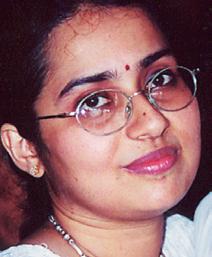
As the sun goes down and the temperature plummets, the iconic Sydney skyline lights up with an inspired display of sheer creative genius, creating an interactive nocturnal playground.
During the waning weeks of May, thousands turn up at various foreshore destinations for a sumptuous spread of ideas and creativity. In its fourth year, Vivid Sydney, the hugely popular son et lumiere show, is not only ‘the biggest ideas festival in the southern hemisphere’, but also voted among top ten worldwide.

The 2012 edition which concludes on June 11, is particularly special to visitors of South Asian backgrounds. An Indian Australian has been recognised for the first time, for his significant contribution to the winter festival.
Akil Lau, a talented architect and acoustics engineer who works for construction services company Aurecon, has created the sound effects for the Water Droplet, a 1.5 tonne installation at Campbell Cove.
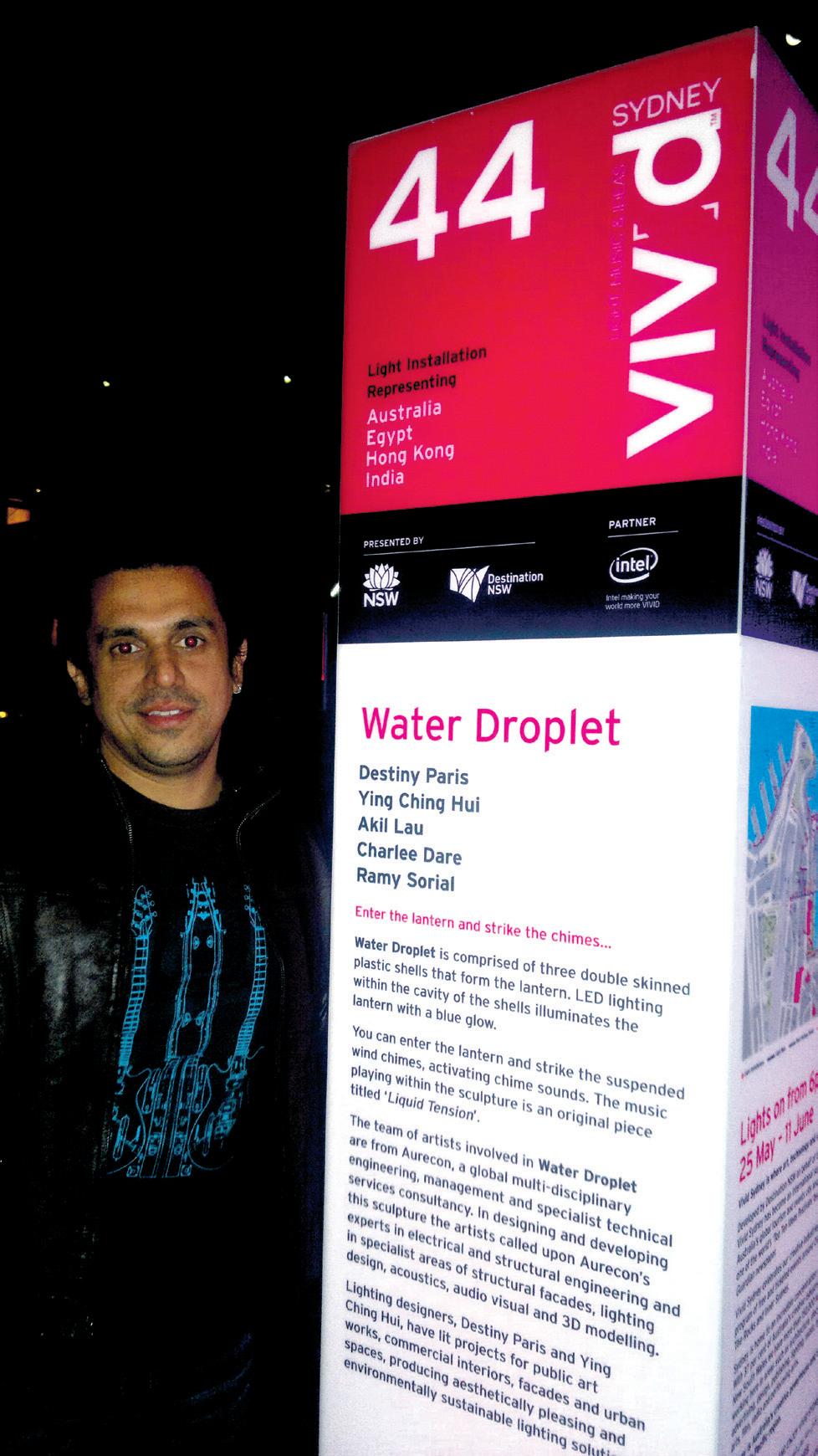
“Very rarely do we get a chance to represent our country of birth on such a large scale. Getting to do that in such a beautiful city, which is a favourite with many Indians, was priceless,” Lau told Indian Link. “Seeing the reaction of visitors and overhearing an Indian couple scream, ‘Ispe
water theme fitted in well with the waterscape that the festival walk weaves its way around, and the incorporation of sound had appeal for the judges.”
The creative team included electrical engineers Ying Ching Hui, Zac Dalleh and Brendan Fernandes, ICT consultant Charlee Dare, specialist façade engineer Ramy Sorial and REVIT modeller Barry Fauvel, besides Lau.
Lau, who holds a double Masters in Industrial Design and Audio & Acoustics from New Delhi and Sydney respectively, has composed the audio piece dubbed Liquid Tension, which was incorporated into the sculpture.
“Bringing each installation to life is possible only as a team effort from a wide variety of professionals like lighting professionals, sound engineers, designers, architects, music composers, dance directors, theatre artists, etc. I was proud to be a part of such a talented team and will remember this as an event which gave my talents a platform, but more importantly allowed me to represent India in such a global event,” stated Lau.
Interestingly, the young Punjabi’s involvement in this prestigious project was the outcome of a chance lunchtime discussion. Noting his creative inputs, he was roped into the project.
“Water Droplet is an experience for the two major senses, visual and aural. The blue light, known to calm the senses, aids the intent of the sound design. Since ages, the sound of water has been known to create a calming effect on the human mind. The combined effect creates a state
A talented architect’s contribution to Vivid Sydney results in a wondrous blend of sound and light with Indian overtones
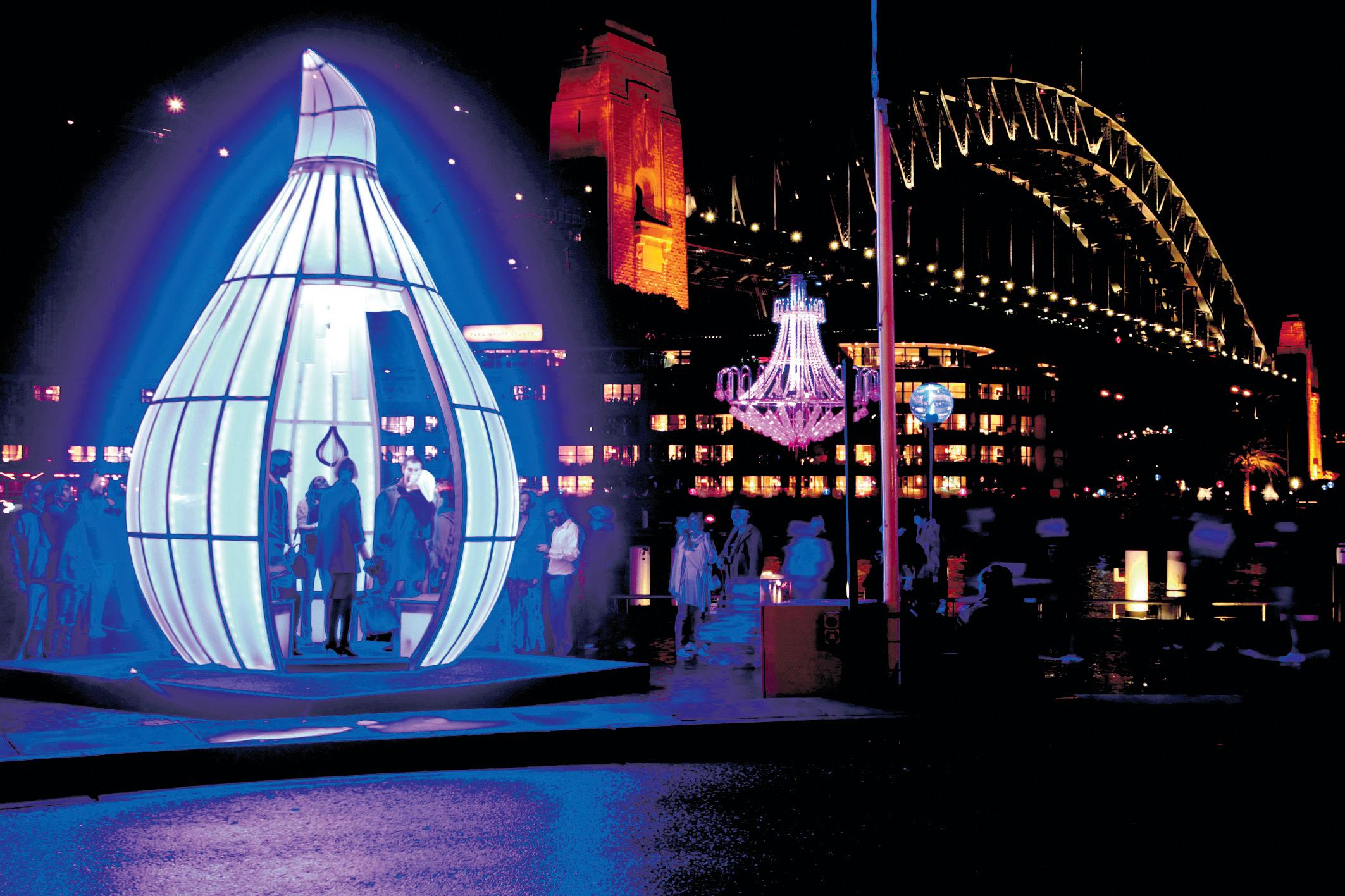

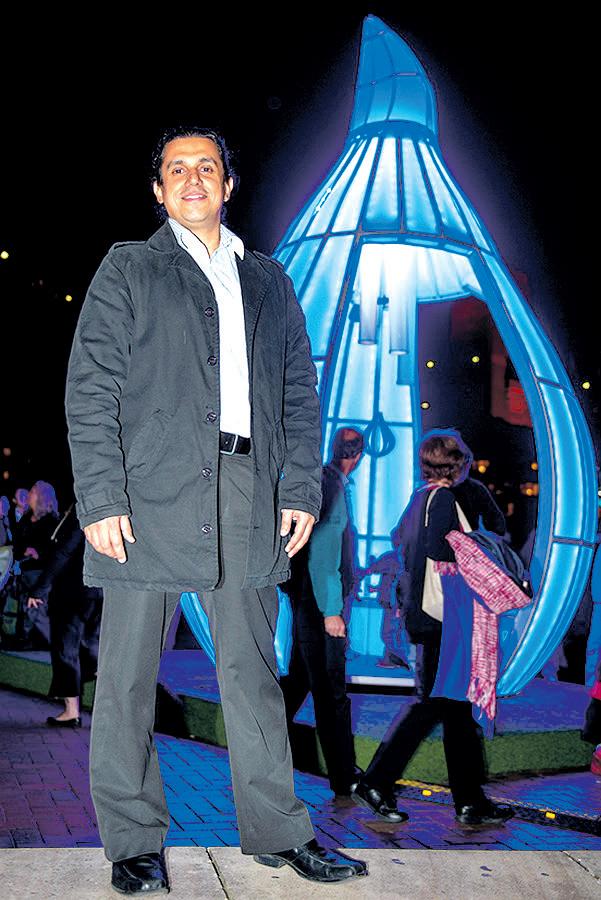
India ka naam hai!’, was the best compliment I ever received”.
“It is a thing of utmost pride for us, and we would love to share this moment with every proud Indian in Sydney and the rest of Australia,” Mahi Lau, Akil’s wife who is also an architect, added excitedly.
The project which was six months in the making, is the brainchild of Aurecon’s lighting designer Destiny Paris.
An Aurecon media release noted that the Water Droplet “was a desirable contender, as the

of mind which can be likened to a trance, when experienced at the optimum surroundings,” explained Lau.
“The storyline behind the 5-7 min long audio composition is that of a single water drop sound which starts off with random thunder. The water drop slowly catches momentum thus producing a rhythmic beat. Slowly the beats from the falling water drops, turn into a musical composition. After achieving a crescendo one can hear the dissolution of the composition
32 JUNE 2012 www.indianlink.com.au vivi D 2012
back into the sound of flowing water,” he added.

“The story symbolically depicts the ever-familiar human life pattern which starts randomly, slowly gets into a rhythm and finally dissolves into eternity, becoming one with the universe,” he concluded.
Elaborating on the technical aspects Lau indicated that the five chimes of different lengths hanging from the middle of the installation were fitted with sensors which were triggered with slight movement of the chimes. Each trigger on the chime was linked to a separate chime sound. 5 different chimes sounds were created using the sound of a single chime. This was done, simply by changing its pitch (frequency), based on the pentatonic scale (major). Pentatonic scale is a musical scale with five notes per octave in contrast to a heptatonic (seven) scale.
The loudspeakers are connected to a Digital Signal Processor (DSP) and the programming in the DSP was done so that the sound of chimes created an illusion of large space and the sound moving around the space. There were a few other techniques inserted in the DSP, which allowed the background track to reduce (ducking) in levels when the chimes were struck.
Interestingly, all the audio equipment has been stored in a cabinet away from the main structure except for the 3 speakers and an active subwoofer, which is placed inside the seat with holes on the front surface to let the sound out.
Lau believes that a solitary space with minimal encumbrances would have been ideal to bring out the best effects, visually and aurally. Though this might mean a visit to the installation late into the

night, he added.
Being part of such a largescale event has been an enriching experience for this music fanatic.
“I think Vivid Sydney brings out the best in the city’s landmarks. With many buildings along the harbour front participating in the festival this time, the look of the city from the Opera House podium is ethereal. It is a moment of truth for the city, which has all the vivid colours in all the residents’ day-to-day lives,” he said.

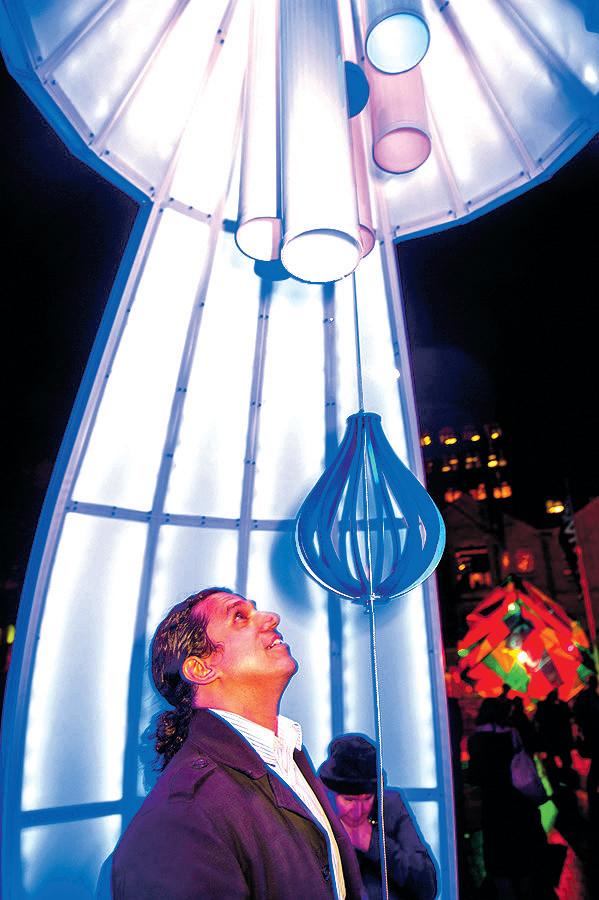


“Music has been an integral part of Akil’s growing years. While studying Architecture his design thesis was based on a School of Music – a school with the optimum spaces creating an environment conducive to learning and enjoying music. Since then, he has had an eventful journey through all aspects of music and sound,” recalled Mahi, who also shares his passion for music (albeit in a different genre).
Akil Lau has successfully blended visual design with acoustics for a perfect amalgam. He has worked on several landmark projects in Sydney including Sheraton Four Points and Telstra.
JUNE 2012 33 INDIAN LINK
ocean
The story symbolically depicts the everfamiliar human life pattern which starts randomly, slowly gets into a rhythm and finally dissolves into eternity, becoming one with the universe Akil Lau
Seeing the reaction of visitors and overhearing an Indian couple scream, ‘Ispe India ka naam hai!’, was the best compliment I ever received Akil Lau
A ‘kahaani’ of Indian bureaucracy, corruption, redemption
His surname inspired a key character in the hit Bollywood film Kahaani Now writer Amitabha Bagchi has knit a plot about Indian bureaucracy, corruption and redemption in his new work, The Householder.

Bagchi, who earlier penned the bestselling novel Above Average, notes: “I had started writing the book long before corruption had become public. Halfway through the book, the Niira Radia tapes came about and the 2G scam surfaced.”
Bagchi, who teaches at the Indian Institute of Technology (IIT) Delhi, was inspired by noted Hindi writer Shrilal Shukla’s novels and literary critiques.
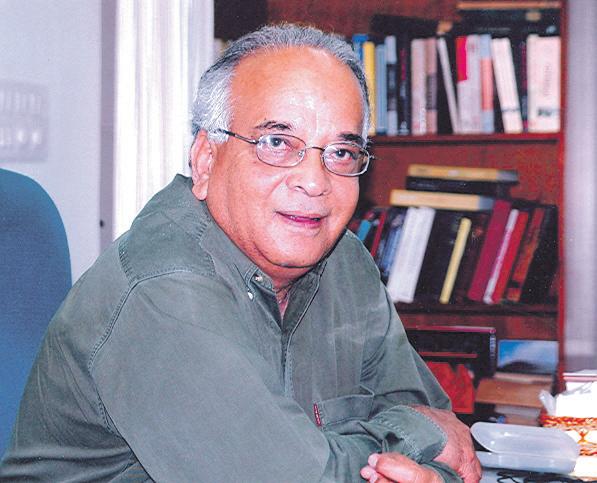
“I never had to deal with bureaucracy and I could not understand how the bureaucratic system works. The figure of a lower bureaucrat became important to me. Shrilal Shukla’s writing and my encounters with lower bureaucrats came together to become the genesis of this book,” Bagchi said.
The book exposes the government underdog - the lowly yet egoistic babu, who takes the beating on behalf of his bosses
for reasons beyond his doing. And survives the blows.
“I don’t think what ails the system is the lower bureaucracy. The lower bureaucracy is the symptom. In Shrilal Shukla’s novels, his heroes like Amrit Lal Nagar and Bhagwati Charan Varma talk about societies which are fundamentally corrupt, where people are exploited by whoever has a little bit of leverage over another,” Bagchi said.
He is the man who inspired Advaita Kala, the scriptwriter of Kahaani, to name a character in the film with the same surname.
“Advaita told me that she knew Vidya Balan would be playing the lead and Bagchi was the obvious choice.”
“There is a funny story about it which Advaita has not told anyone. When I met her, she told me that Bengali men make the best husbands. The surname was on the top of her head when she was creating Arnab Bagchi, Vidya’s husband,” Bagchi said.
In his new book The Householder (Harper Collins-India), Bagchi’s protagonist is a very familiar Naresh Kumar, personal assistant to R.K. Asthana, an IAS officer.
Naresh is a householder with a
wife, son and daughter. He is an indispensable cog in the wheel of bureaucratic corruption because a share of the largesse that flows through Asthana’s door trickles down to Naresh.
Like every “householder” on the babu’s payroll, Naresh is besieged by filial misfortune. His married daughter has trouble conceiving a child and his son’s call centre job is shady. To make matters worse, Pinki Kaur, an attractive widowed mother at work, is a distraction.
He is suspended from his job for a botched deal. But as the householder, Naresh has to fend for his family even when out of job. Redemption arrives at the end of the novel when the inquiry commission clears Naresh - the fall guy - and returns him the job in the ministry.
The writer pointed out that in The Householder, his hero was neither a Niira Radia, nor an A. Raja nor a Kanimozhi. “I am not talking about the high-fliers and neither about the wretched of the earth. I am talking about people who are in the middle and hold some power,” Bagchi said.
Bagchi’s father was in the postal service and had “many
beating on behalf of his bosses for reasons beyond his doing. And survives the blows.
subordinates”.
“There was a certain kind of relationship between them and my father. The subordinates instinctively know men in power by the body language,” Bagchi said, enumerating Naresh’s character.
Another aspect that Bagchi wanted to probe in the book was
“the concept of masculinity”. “I wanted to see how men are made and what are the pressures they face all over the world when they provide for their families. I think to provide and care for the family is a fundamental emotional requirement of a man,” Bagchi said. Madhusree Chaterjee
Reviving the Parsee Punch with new pickings
Humour has been the golden lining of India’s realpolitik for as long as one can remember. The early kings hired jesters; Mughal emperor Akbar had Birbal and, in the 19th century, quick-witted Indian writers picked up from the British bible of humour, Punch, to laugh like the white “babus”.
By the end of the 19th century, at least 70 Indian-style Punchlike papers and magazines had appeared in over a dozen cities of the country.
“Humour unfortunately is now on the decline in public life. The composition of political clans has changed so dramatically that their appreciation for humour is diminishing. Public life has become very combative and politics competitive. The ability to laugh is becoming more of a rarity,” historian and anthologist Mushirul Hasan, the director of the National Archives of India, says.
Hasan’s new humour compendium, Wit and Wisdom: Pickings from the Parsee Punch (Niyogi Books) published last month, has reproduced some of the best caricatures from the illustrated Parsee comic weekly
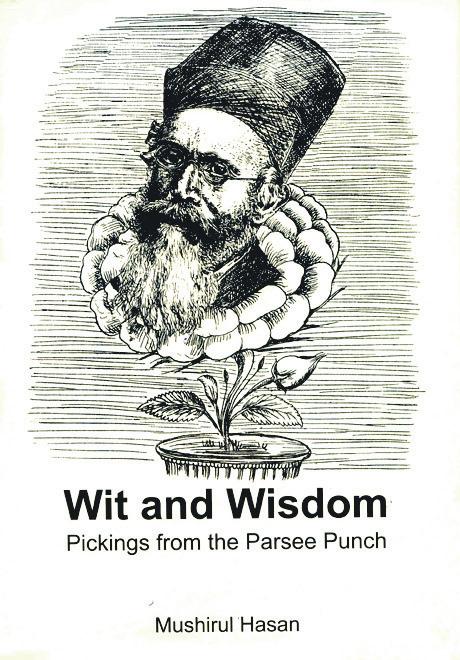
paper published for over seven decades from 1854.
The cartoons mirror the social and political situation of Bombay and the western provinces of the country in the light of world events
There are also academic accounts of the history of the Parsee community in India and how politics, religion, reforms, identity and foreign affairs affected their lives.
The Parsee Punch, like the London Punch, contained 20-36 pages of funny illustrations. The weekly’s name was later changed to Hindi Punch for a more panIndian identity and continued to be published till 1930.
“You can’t conceive a human society without humour. Modern India had several great humorists like Mahatma Gandhi, Sarojini Naidu and Jawaharlal Nehru.
Shankar was everybody’s favourite and with Laxman, the common man became a symbol. There was a lot of homour in Urdu writing before and after Independence,” Hasan said.
The cartoons have a nationalist colour. A late 19th century Parsee Punch illustration, “A Loving Pair”, makes a political comments about
a cross-cultural love.
It reads thus: Fergusson (to a native sari-clad lady, whom he hugs): “Yes, my dear, I shall always try to make you happy!”
Miss Poona Bai: “I am so happy, so joyful for your kind and sincere attention towards me, my dear Fergusson, that I am unable to express my feelings in words...”
(Sir James Fergusson had made an important concession for establishing a native girls’ high school at Poona.)
“The remarkable thing is that even though the Indian Punch writers were critical of the ruling British government and its policies, the British never proscribed any of the issues. There was a certain level of acceptance of the humour,” Hasan said.
The Indian avatars of Punch brought about an acknowledgement by the erstwhile British rulers that “Indians had a sense of humour”, Hasan said.
“They realised that humour will be appreciated by the educated elites. They would read, laugh and forget about it,” Hasan said.
The Parsee Punch is the second in the series of Punch anthology by Hasan.
The first volume consisted of
pickings from the Awadh Punch, published from Lucknow from January 1877 to 1936.
“The Awadh Punch, edited and published by Munshi Sajjad Husain, was a household name hosting writers like Akbar Allahabadi, Ratan Nath Sarshar and Mirza Began,” Hasan said.
The character sketches in the magazine were described by critics as the “precursor of the modern
Indian short story”.
The Awadh anthology caricatured the Raj, defended Indian tradition and wrote political satires of early 20th century India with sketches of comical stereotypes such as “the patwari, chawkidar, revenue agent, honorary magistrate, the Englandreturned and the title-hunting associations of noisy zee-huzoors”. Madhusree Chatterjee
34 JUNE 2012 www.indianlink.com.au
B oo KS
The cartoons mirror the social and political situation of Bombay and the western provinces of the country in the light of world events.
Mushirul Hasan


JUNE 2012 35 INDIAN LINK
2012: Why it’s not our last
Are you looking for a career in Family Day Care?
Come along to “Aussom Family Day Care ”
Aussom Family Day Care opened its doors in Jan 2008 and has offices in both Melbourne and Sydney, to provide quality early childhood education and care to children.
• We offer flexible contracts to genuine people interested in caring for and educating children aged between infants to 12years old in their own home,
• We would love to engage a diverse range of educators from many different cultures,
• A commitment to enrol into Certificate 3 in Children’s Services and other criteria apply,
• We have a team of dedicated professionals waiting to help you kick start your career in Family Day Care.
• We offer comprehensive support and guidanceall you need to do is pick up the phone and make an appointment.
Aussom Family Day Care NSw
4/1 Station Road
Auburn 2144
1300 164 794
Aussom Family Day Care Scheme


49 Hopkins Street
Footscray 3011
1300 556 043
BY RITAM MITRA
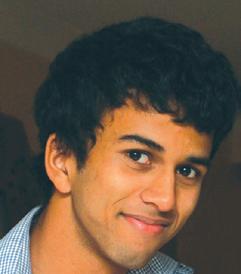
Social media has been rampant over the last year or two, perpetuating the belief that the world is going to meet a catastrophic end this year. It could be simply put aside as a bit of fun and games due to conjecture – if it wasn’t for the fact that there have now been several cases of people committing suicide so as to avoid living through the “end of the world”.
As is typical of stealth marketing, the campaign for 2012 made no mention of the movie itself, and as a result, many unknowing viewers went as far as to contact astronomers in panic.
The recent hype around 2012 began primarily with the release of the 2009 blockbuster film 2012. The movie was advertised using stealth marketing, which, while hugely successful, involved websites and TV advertisements from the fictional “Institute for Human Continuity”, calling on people to prepare for the end of the world. As is typical of stealth marketing, the campaign for 2012 made no mention of the movie itself, and as a result, many unknowing viewers went as far as to contact astronomers in panic.
The belief in the 2012 myth, however, has its roots in the ancient Mayan “Long Count” calendar, upon which the film was based. The Mayans called the current period the “Great Cycle”, a cycle which will end on the winter solstice this year – the longest night of the year. For the Northern Hemisphere, this falls on December 21. It is not, as many believe, the end of the Mayan calendar – it is simply the end of one of its cycles.
This will supposedly be the trigger for a series of catastrophic and unpredictable events – cities being thrown into the sea as a result of a sudden shift in the Earth’s mantle and crust; a reversal of the magnetisation of our poles, and even a collision with the planet ‘Nibiru’. It must be noted that Nibiru has never been seen or proven to exist – believers refer to it as an invisible planet.
However, the ancient Mayans actually believed it was a cause for huge celebration to have reached the end of a whole cycle. In the same way modern civilisations celebrate the end of the year and the ushering in of a new one on December 31, so too did Mayans believe reaching the end of a cycle was a great occasion – it is just that this cycle began on August 11, 3114 BC.
civilisation that believed the year 2012 would be a momentous one. In 1998, Kalki Bhagavan, the Indian guru, spoke about the year 2012 as a ‘deadline’ bringing about the end of ‘Kali Yuga’, or the last of the four stages (the previous three being Satya Yuga, Treta Yuga and Dvapara Yuga) that the world goes through, according to early Hindu texts. Kali Yuga is said to be a phase of spiritual degeneration in humanity, and is referred to as the “Dark Age”. However, even here there is conjecture – some religious figures believe Kali Yuga is already over, while others believe it is yet to begin.
Scientists have been inundated with queries on the subject for the last five years. Since 2007, NASA’s ‘Ask an Astrobiologist’ public outreach website has been asked over 5000 questions on the subject, including some from people asking whether they should kill themselves, their children or their pets. Sales of underground blast shelters have grown rapidly since 2009, and the mayor of the Brazilian city São Francisco de Paula mobilised his city to prepare for the date by stocking up on food and water. Similarly, in Corguinho, another Brazilian city, a colony is supposedly being built for survivors of the apocalypse.
Closer to home, one in ten Australians believe the world will end this year, with believers said to fall into two camps – one camp is full of catastrophists, who believe comets will rain down on the Earth in a brutal end to humanity. However, it is interesting that the larger group of Australian believers see it as the end of the world “as we know it” – the ushering in of a new age of enlightenment, a shift in human consciousness and perhaps a more tolerant, peaceful society. The poll was commissioned by Reuters, and involved 16,000 people in 21 countries. 20% of the Chinese and Turkish respondents believed the world would end, but only 4% of Indonesian respondents agreed.
Closer to home, one in ten Australians believe the world will end this year, with believers said to fall into two camps – one camp is full of catastrophists, who believe comets will rain down on the Earth in a brutal end to humanity.
Humanity has been perennially fascinated by the concept of predictions and prophecies. There were 42 failed doomsday predictions regarding the year 2000 alone, and Harold Camping recently made headlines for his several failed predictions regarding the end of the world, through which he generated massive revenue for his radio station in California. The only thing that has been proven certain is that we are uncertain about the future.
It was not just the ancient Mayan
So what will happen on December 21, 2012? Probably not much!
36 JUNE 2012 www.indianlink.com.au
v ie W point
Once again, worriers across the globe garner their forces to find out whether this year will be the world’s last
Social media exposes Syria
BY RITAM MITRA

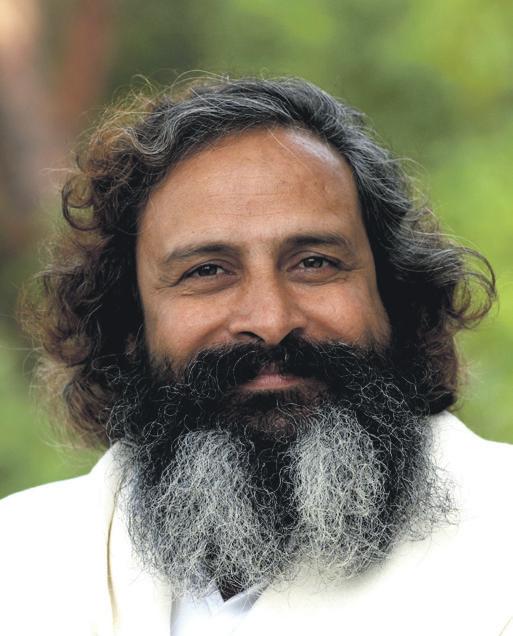
The brutality of the Syrian regime has come to the forefront of global media in the past month, as Bashar al-Assad refuses to loosen his stranglehold on the country. Social media is awash with opinion and outrage over the blatant disregard for human life that has transpired in Syria, and it is purely misinformation that seems to be the primary defence for the Syrian government.
The background of the terror is crucial to establishing the violent context in which this regime operates. The Syrian uprising is part of the Arab Spring, a series of revolutionary protests and demonstrations that have engulfed the Arab world, beginning on 18 December 2010. Rulers have been forced from power in Tunisia, Egypt, Libya and Yemen, and the civil unrest in Syria is but one of several in the region.

Public demonstrations against the Assad regime began at the start of 2011, as protestors sought an end to nearly five decades of Ba’ath Party rule. The Syrian government reportedly deployed military units to quell the uprising, and it is clear that the problem merely escalated further. The situation now is dire. There have been up to 18,700 casualties, as well as tens of thousands of imprisoned protestors. Many of the victims were children.
Although the dangerous situation in Syria has been escalating for over a year now, affairs reached a climax late last month when on May 26, two days
before Kofi Annan, the UN-Arab League envoy to Syria flew in for scheduled peace talks with Assad. On this day 108 civilians were massacred in the town of Houla, through mainly execution-style killings, but also with the use of heavy artillery.
Many survivors and witnesses claim the attacks were conducted using tanks, to which only the government’s military have access. Scarcely believable stories have emerged in the media, such as those of a boy, 11, smearing himself in his brother’s blood and playing dead so as to escape pro-Assad gunmen who, minutes before, shot dead his mother and two siblings. As the boy faked being dead, the gunmen took three televisions and a computer from the home, before shooting dead his uncle and father outside.

The Syrian media, however, reportedly refutes the 108 civilian count as a mere UN exaggeration, while asserting that the killings were a fabrication by terrorist groups affiliated with Al-Qaeda. A common theme, however, of all the conflicts that have made up the Arab Spring, seems to be the use of social media – as a means of communication between both civilians and the terrorist groups themselves.
Social media widely considers the poor standard of life many countries in the Middle East are forced to accept. However, what is often overlooked is how purely desensitised all those civilians are to death, blood, and gore. A recent video uploaded by ‘Syrian Scenes’ on YouTube highlights this.
Reportedly filmed by members of the Free Syrian Army, a group of insurgents formed primarily by civilians and army defectors, the video features a room filled
with the bodies of dead children, supposedly from the Houla massacre. A man gestures to the camera in a wild rage, picking up the bodies of each of the children in a way that would be considered disrespectful if it were not for the outrage in his voice. He demands to know why the world is ignoring the crimes of Assad, and asks of the cameraman, “What did this child do? Why him?”, as he picks up and displays the mangled and bloodied bodies of just a few of the dozens of children that lay strewn across the ground. Several other videos show bodies being recovered from mass graves, as well as recordings of rooms full of dead and injured men, women and children.
The crisis has now reached a point where it is not even necessary to venture any claims regarding the perpetrators of massacres such as Houla. It is easy to establish an armchair
opinion while we are fed immense amounts of information from the global media, where it is assumed Assad’s regime is purely at fault. However, wherever civilian casualties are this widespread and commonplace, whether the perpetrator is a government or a terrorist group is neither here nor there.
Social media, such as YouTube and Facebook have brought these atrocities to the forefront of a new generation. As those currently governing countries across the world begin handing power down to Generations Y and Z, the power of the internet will be truly realised. Never before have youths been so conscious of a global community – and never before has the world been such a small place. It will be fascinating to see how differently the world operates when it is run by those who know that they are part of a bigger picture.
This is not to say power will never be abused in the years ahead. It may well be the case that social media makes regimes of terror such as Assad’s all the more potent. In a world obsessed with immediate information, however, it is all about awareness, and it is only through awareness that Syria will be able to begin the long and arduous process towards normality.
Eleven countries including Australia, have now expelled Syrian diplomats from their shores. Whatever does lie ahead, the world is in a somewhat unprecedented state of outrage. There have been countless horrific events similar to the ones taking place in Syria throughout the course of human history – but the Syrian massacres come in a completely different context to a completely different global population. It can only be a good thing.
JUNE 2012 37 INDIAN LINK
opinion
Atrocities against civilians have been splashed across social media sites as the internet is used to raise global support against the Syrian government

38 JUNE 2012 www.indianlink.com.au


JUNE 2012 39 INDIAN LINK
Malaysia’s island paradise is a haven for wildlife, communing with nature and getting familiar with the resident cat
LangkawiLush

 BY PETRA O’NEILL
BY PETRA O’NEILL

Just a 30km ferry ride from the northwest coast of Malaysia lies an archipelago of ninetynine pristine limestone islands collectively known as Langkawi. The region has abundant wildlife, mountains, caves, waterfalls, lush tropical rainforests, white sandy beaches, night markets offering a spicy array of inexpensive Malay hawker cuisine and some of the most luxurious resorts in Asia. Only two of Langkawi’s islands are inhabited. For centuries, ships brought traders here from Thailand, Malaysia, Indonesia,
and are home to local fishermen and rice farmers. Schools, electricity and roads came only in the 1960s, and Langkawi remained off the tourist radar until 1986 when a former Prime Minister Mahathir bin Mohamad, who had worked there as a doctor, recognized its potential and encouraged investment.
For around $7, you can hop into a small boat to visit three islands – Beras Basah with a beautiful beach and warm jade tinted water, perfect for a refreshing swim; then to watch Bhahminy Kites and Sea Eagles dive for fish; and last to visit an island called Dayang Bunting or “Pregnant Maiden” with hills resembling a woman’s reclining body. A jungle track leads to a crystal clear lake. A macaque monkey crashed through the forest canopy and landed on my

in it and squirted the water out. I ran for dear life to the end of the jetty, took out the wrapped banana that I’d brought along for a snack from the bottom of my bag and tossed it at the monkeys who were following me in hot pursuit. That slowed them down as I made my escape!
The next day I hired a taxi to explore the beautiful beaches to the north of the island. The Andaman and Datai hotels in a lush, primary growth rainforest setting, share a private secluded crescent beach of white sand and crystal clear turquoise water.
The Datai was Langkawi’s first luxury hotel and a naturalist’s paradise with a multitude of birds including kingfishers and hornbills, lizards, flying squirrels and tarantulas. I was ferried around the vast resort complex in a golf buggy by an affable staff member
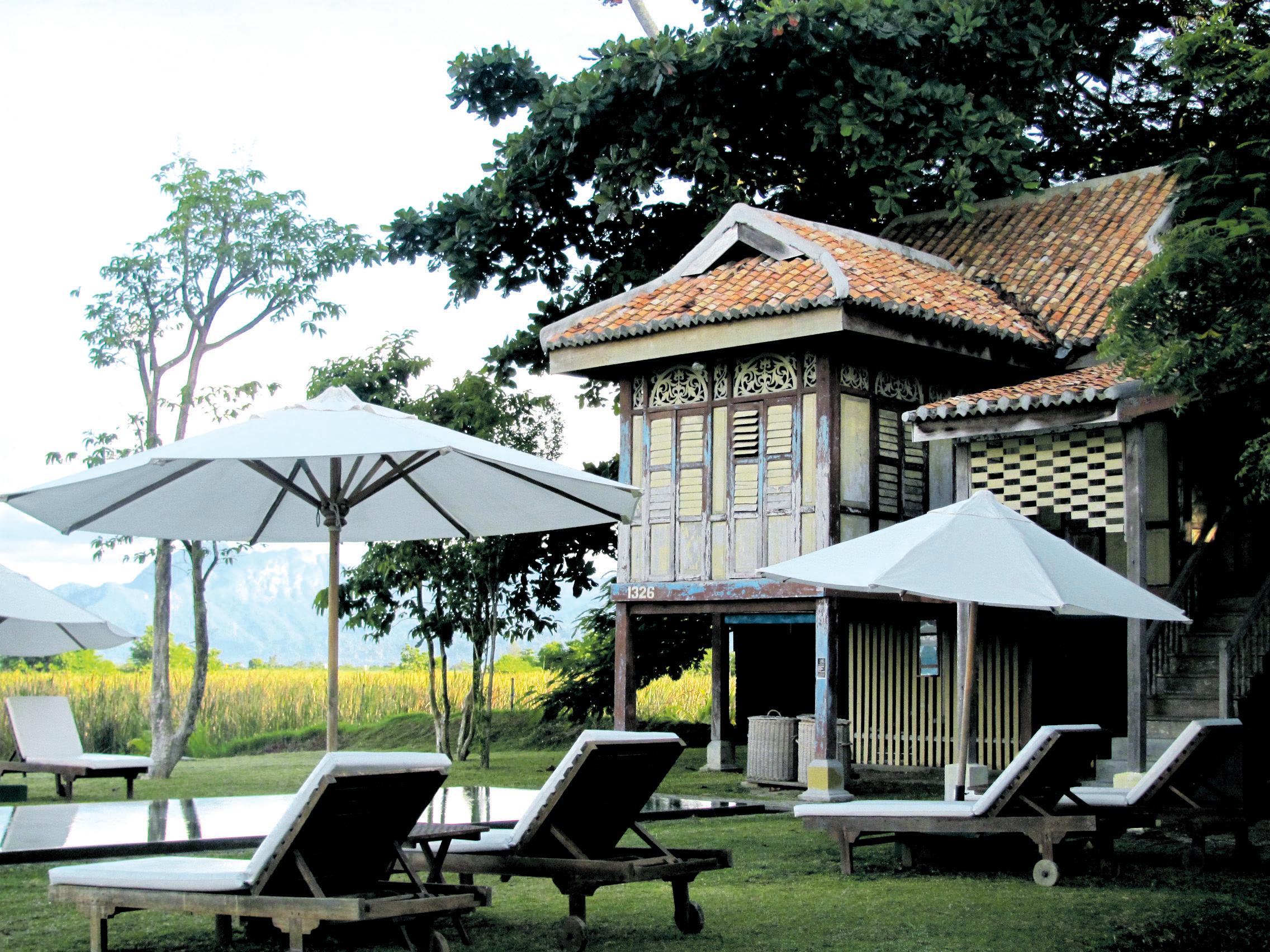
who offered to stop to allow me to look for tarantulas. He seemed disappointed that I found none.
We drove by traditional villages, with mango, papaya and jackfruit trees that are cultivated in neatly tended gardens to Tanjung Rhu, another spectacular beach with a drier, more exposed landscape of casuarina trees. Further on are dense mangrove swamps that protect the coastline.
Telaga Tujuh is a waterfall that cascades through seven limestone pools. You can hike or go by cable car to the summit of Gunung Mat Cincang, Langkawi’s second highest mountain and at 550 million years, the oldest rock formation in Southeast Asia. During the steep ascent the islands of southern Thailand become visible.
I spent time at Pantai Tengah, the main backpacker area at the Sunset Beach Resort, a laidback, relaxed place, where I hired a pushbike for leisurely rides past rice paddies and grazing water buffaloes to explore nearby beaches. Langkawi is a popular destination for Malaysians on holiday and many families enjoyed strolls along the beach, while young couples dared each other to try parasailing.
most well known is that of Mahsuri, a nineteenth century beauty sentenced to death on suspicion of adultery while her husband was off at war with the Siamese. As the blood ran from her veins, it turned white proving her innocence and bleaching the sand white. Her mausoleum is a popular tourist stop.
Hawker markets are held each evening at a different locations by rotation with Sunday being the biggest and most popular. Malaysian cuisine, a fusion of Malay, Cantonese, Indian, Thai and Indonesian, is delicious.
In the neon lit markets it is remarkably varied and incredibly cheap. Sunday’s Padang Matsirat market has the atmosphere of a street fair as tinny music plays and families enjoy meals of seafood, noodles or nasi lemak, rice cooked in coconut milk and served in a spicy sauce.
For the final two nights I splurged at the Temple Tree, owned by Australian Narelle McMurtrie, who also runs Bon Ton Resort next door. Bon Ton is a cluster of eight traditional Malaysian Kampung houses that were rescued from demolition, reassembled and restored. Each is filled with Asian antiques and an eclectic array of knick-knacks and rich woven silk fabrics in a lush tropical garden setting. Temple Tree comprises eight mansions and colonial bungalows
Langkawi
and Eurasian origin. All are exquisite. Mine had lime shutters, hardwood floors, a massive bathtub and several day beds for relaxation. As I entered my suite a white cat greeted me, and for the duration of my stay, followed me from room to room.
Several months earlier I’d been in Pondicherry, India. My most lasting memory was of a dog who followed close behind me for several hours as I went in search of food for him. I didn’t know what else to do. But this time, I’d researched beforehand to find an outstanding example of responsible tourism, and this was it. The resort promotes the adaptive reuse of Malaysia’s architectural heritage and uses the profits to support a shelter for neglected, abused and abandoned cats and dogs. Tourism can be
LANGKAWI


GETTING THERE
a positive force and a stay here allows you to feel that you have made a worthy contribution. On my last day there, my taxi driver, Duns, met me before we were to embark on the drive to the port town of Kuah, to catch the ferry to the mainland. He asked if I could reconsider my travel plans and stay for just one more day so that I could be a guest at his daughter’s wedding. He had been preparing for the festivities all week. He handed me a wedding invitation that had his address. Next time you visit he said, please come and meet my family. As I left Malaysia behind on the express train bound for Bangkok, I reflected on the warmth of my stay. Langkawi is a beautiful, safe, clean, inexpensive and welcoming destination and yes, I do miss that cat!
Malaysia Airlines flies to Langkawi via Kuala Lumpur from Australia. You can also access Langkawi by ferry from Penang or the mainland. Trains run from Kuala Lumpur and Butterworth, stopping at Alor Star.
WHERE TO EAT
There are numerous restaurants along the main road of Pantia Tengah. The night markets are great fun and allow you to experience the variety of Malay cuisine. At the restaurant at Bon Ton, owner Narelle McMurtrie and her staff cook up a Malay feast that should not be missed, with a host who explains the details of each dish.
ACCOMMODATION
Of the luxury high-end resorts I visited three, the Datai, Andaman and Tanjung Rhu. All are large, quite formal and secluded with beautiful beaches. The Datai offers accommodation in rooms or villas. Email: Datai@ghmhotels.com; website: www.ghmhotels.com The Andaman next door shares the same lush rainforest setting and spectacular private beach. For nature buffs the hotel offers many activities including rainforest walks. Email: Andaman@ theandaman.com; website: www.luxurycollection.com Tanjung Rhu Resort has a lovely 2km long beach. Email: resort@tanjungrhu.com.my; website: www.tanjungrhu.com.my

Set on the grounds of a coconut plantation, both Bon Ton and Temple Tree are charming, relaxed and intimate, more suited to those who appreciate exquisite taste and historic architecture over service, since guests are left largely on their own with a breakfast hamper delivered the night before, perfect for those in search of peace and privacy. It has a setting overlooking bird-filled wetlands beyond the infinity pools that makes up for lack of a beach. Bon Ton’s airy Malay Kampung villas have wide verandahs for you to enjoy tea and coconut cake. Email: info@bontonresort.com.my; website: www.bontonresort.com.my
Temple Tree next door comprises 8 historic mansions of Chinese, Malay, Indian and Eurasian origin that are full of character. My suite, the turquoise and lime green Penang House, was beautifully furnished and huge with several rooms that I shared with the resident cat. It is
The Datai was Langkawi’s first luxury hotel and a naturalist’s paradise with a multitude of birds including kingfishers and hornbills, lizards, flying squirrels and tarantulas.

Beras Basah Island
Beras Basah Island
Sunset Beach Resort
Macaque monkeys
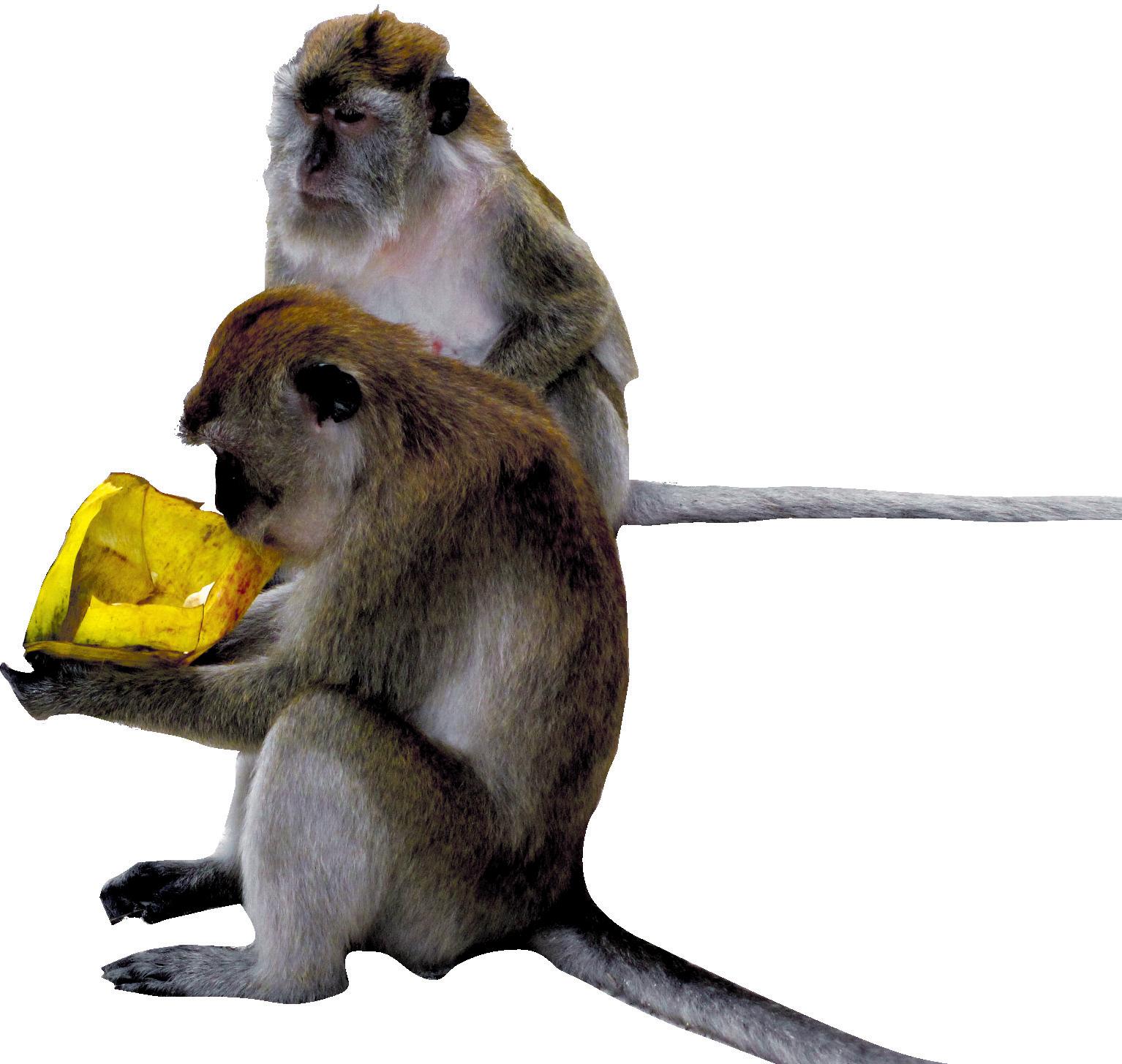
Island hopping
a 30-minute walk to the beach, shops and restaurants. Email: info@templetree.com.my; website: www.templetree.com.my
Guests can visit the clinic and walk the dogs. More information on the animal shelter that cares for neglected, abused and abandoned dogs and cats can be found at info@ langkawilassie.org.au; website: www.langkawilassie.org.au
A favourable exchange rate translates to Malaysia being a bargain destination. There are many clean, great value guesthouses in Pantai Tengah. I stayed at the Sunset Beach Resort, managed by two friendly Malay women. Rooms are comfortable with a path leading along a lush garden to the restaurant and beach. Email: sunset@sungrouplangkawi.com; website: www.sungrouplangkawi.com
G ETTING AROUND
There is an absence of public transport on Langkawi, though mini vans do offer transport. Taxis are very inexpensive and my driver Dans was obliging, punctual and courteous. I paid around $25 for the 3 hour island trip and $6 for the airport transfer. Dans may be contacted on 0124769987.
TIPS
English is widely spoken. Water is safe to drink. Rates of exchange are less favourable here than in Kuala Lumpur. Do not carry food when hiking in rainforests.
INFORMATION
Australian passport holders do not need a visa to enter Malaysia for a visit of up to three months, provided their passports are valid for at least six months on arrival and they have a return or onward ticket to another international destination. For citizens of India, Sri Lanka, Pakistan and Afghanistan, a visa from the High Commission of Malaysia in Canberra is required. Tourism Malaysia has many brochures and is at Level 2, 171 Clarence Street, Sydney Phone: 02-9299 4441 Email: malaysia@malaysiatourism.com.au Website: www. tourismmalaysia.com.au
Main Image: Bon Ton Resort
Left to Right: Temple Tree poolside
Travel noTebook

42 JUNE 2012 www.indianlink.com.au
Franchise for Sale
Established Finance Broking (Mortgage Choice)
Marketing area: Bayswater, Knoxfield, Rowville, Scoresby, Wantirna, Lysterfield.

Unique opportunity to be part of a well recognised and respected brand. Established business with good loan book, client database and sizeable trail income to get you started. Full training, support and leads provided. Relationship building skills essential.
Enquiries to Rakesh Mittal at 0400 614 317.

He captured the magic of Aishwarya Rai when she got back home after winning the Miss World crown in 1994.
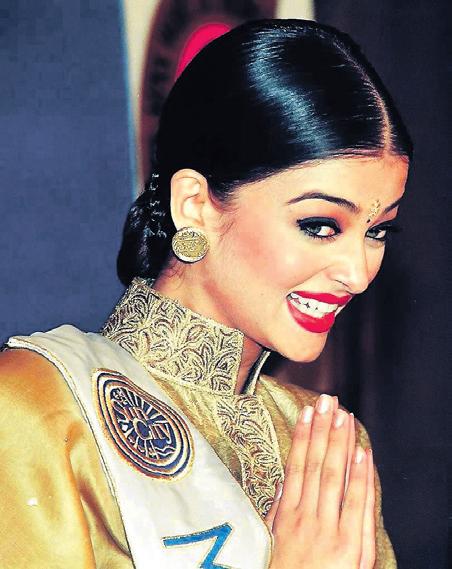
Now Ap GuRuSWAmy captures beautiful moments in Melbourne’s Indian community! In his 40-year career experience as a professional photographer in India Guruswamy covered news, corporate events, large scale events and celebrities.
For stunning images of your next big event, call Guruswamy on 0406 820 413.
JUNE 2012 43 INDIAN LINK
Dont miss out hot deals for December call now! FROM FROM $900. $1050. FROM FROM FROM $925. $895. $835. Dhaka Kathmandu FROM $915. License no: 32885
SeekIng gROOmS
Seeking suitable Hindu/Jain match for our daughter, 5’1”, 22 years. Born and brought up in Sydney with Indian family values. Degree in IT. Working as a Software Consultant in Sydney. Caste no bar. Contact father in Australia on email: rlagrawal55@gmail.com
Seeking suitable match for a Hindu Tamil Iyer girl 26 years old (from Canberra Australia, never married), IT software, vegetarian, non smoker, non drinker, living in Australia for 20+ years, simple, straight forward upbringing, loves playing tennis, bike riding and quiet in nature. Email details to r.cosmic9@gmail.com
Seeking well qualified match for very fair young looking Hindu lady, 54, veg, divorced, daughter living with her. He must be aged 49-55, non smoker with strong moral values. Contact lifepartner@hotmail.com.au or 0404 043 904.
Seeking suitable match (from Australia, never married) for Hindu girl 35 years, Chartered Accountant (non-veg), living in Australia over 25 years, with eastern and western family values.

Please email with all details on ganesh2011v@gmail.com
SeekIng BRIDeS
Seeking graduate Hindu girl for well established 5’10”, very fair 21/11/1968 born Australian citizen. Never married. BE(Electrical) self employed. Vegetarian nonsmoker teetotaller. Please email profile with photo to anandrao68@gmail.com
Decent Mangalorean /Goan gentleman 47 years, seeks marriage alliance from sincere attractive South Indian /Sri Lankan/Pakistani / Bangladeshi bride aged 30 – 52, Caste religion barrier open. Please contact advertiser by writing or phone – 5/47 First Ave Seven Hills 2147.Ph (02) 9676 2512 Mob 0458 153 193. Proper address / phone contact and photograph requested.

Seeking suitable match for clean-shaven Jat Sikh Gill boy, 29 years, 5’9”. MSc. BEd (India). Diploma in hospitality (Australia). Applied PR in 2009. Belonging to a noble and respected family with moral values. Sister married and settled in Sydney. Email australiagill@yahoo. com, mobile 0470 574 071, 0423 238 228.
Matrimonial alliance is required for my nephew, 31 years, 5’10”, fair complexion, engineering graduate, working in real estate, from respectable Hindu Punjabi family. No dowry please. Simple girl, decent education with any job in Sydney or a professional from India. Contact 02 9613-3057; 0423 084 030.
Compatible match for 1975 born, handsome clean shaven Sikh Khatri boy, 5’ 9”, two PostGraduate degrees from India and recently finished Masters in I.T from Australia. Applied for temporary resident visa (currently with full work rights) and working as Vehicle Service Agent for Hertz multi-national car rental company and earning $ 4,000 plus per month. Girl should be tall, well-educated with pleasing personality and must be from Sikh background. Early marriage and serious proposals please. Phone: 042210 2242 or email: jas_ghai01@hotmail.com
44 JUNE 2012 www.indianlink.com.au
m A tRimoni ALS
Growing pains
India deals with its rapid foray into the age of development at its own pace because after all, this is India!
BY TIM BLIGHT
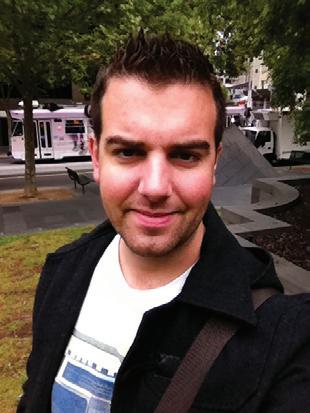
When invited to a party, we select our outfits carefully. It must represent the person we are, and it often says something about who we want to be. Above all, it must be appropriate for the occasion.
Earlier this year, four men and one woman took such care when selecting their outfits for a do to which they were invited in New Delhi. The woman had her hair done, and wore a smart blazer and slacks. Three of the men wore traditional business suits, and arrived clean-shaven. However one man, the host incidentally, did not cut his facial hair, as it conflicted with his religious beliefs, and he wore a Nehrustyle jacket which he probably felt reflected his native culture.
India’s Prime Minister Manmohan Singh mightn’t have given it much thought, but his appearance at the fourth BRICS summit was a declaration to the world that he is a proudly modern, global Indian. But beneath India’s bold exterior lies a conflict – one which the leaders of the other four BRICS nations might have pondered as they sipped their foreign-owned bottled water. They might have contemplated it because they face it in their own nations. As India emerges on to the world stage, how does it deal with the growing pains of development?
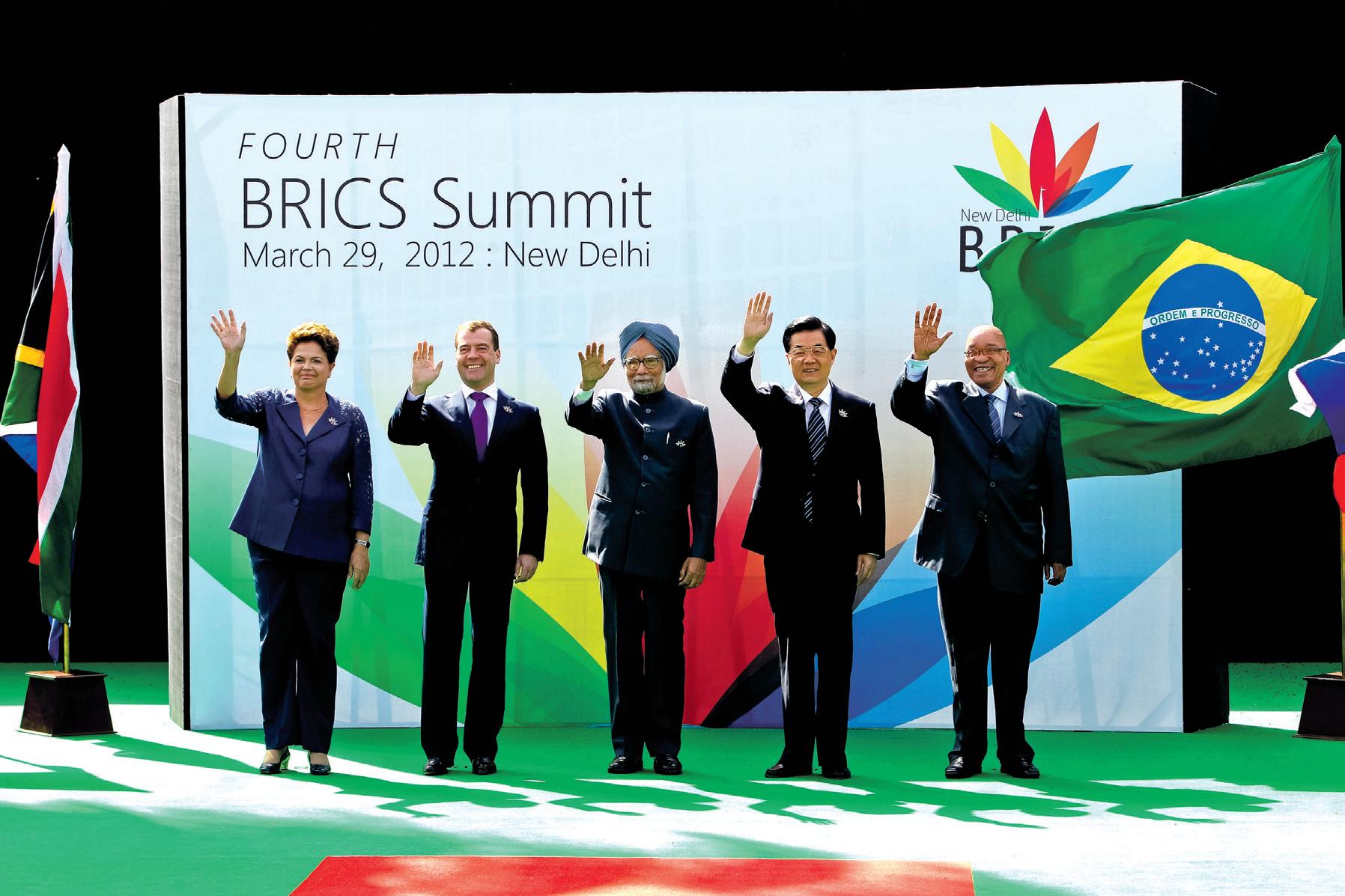
I see this conflict in my daily life in Chennai. I wait for what seems like an eternity while an older or non-urban Indian, hesitates, dares, then hesitates again before getting on an escalator. Their more “mod” fellow shoppers watch on with intrigue, tinged with amusement or disdain –sometimes both. Workers sit in air-conditioned offices and deal with affluent Westerners before boarding dilapidated buses and dealing with clogged, pot-holed city streets. Maidservants, on their rare days off, watch television programs which depict a life which they could only imagine. Young men go to plush cinemas to watch item girls perform dances in revealing outfits that their sisters would never be allowed to wear. And the growing
middle class, while waiting behind Miss “Behenji turned mod” to board the escalator, are carrying a microwave oven which they’ll install in a kitchen with unfinished tilework. In six months, that same microwave oven will be used solely to store the toaster in.
Scenes like these (still) leave me somewhere between astonished amusement and cynical depression. Amused because of the absurdity of so much of it, and depressed because of how many people’s dreams aren’t being fulfilled. The question at the heart of all of this is, what will it take for the dream and promise of modern India to be fulfilled? And does modernity mean abandoning what we hold dear? Last year I waited two months for a washing machine to be delivered. First it was held up at the factory, then it was held up by a truck strike, but all along I was assured that it was on its way. Six weeks later I was asked whether I wanted a washer or a dryer; a question which confirmed a suspicion which I’d held from the beginning. Everyone I told about it smiled and said, “Well, this is India!”, a sentiment which I fully appreciated; I never expected that life in India would run like clockwork. But I doubt that many multinationals investing in India would share my patience and sense of humour. And moreover, should one expect things to run like clockwork in India? After all, “this is India!”
So should they change, or should we? Or to put it bluntly, does India want to claim ‘lateness’ as a cultural characteristic?
How much ground should India concede before defending ‘the way things are done here’?
India has faced many perceived cultural threats before – from the Mughals to the British – but could globalization be the threat which conquers local culture?
History says no, but things are changing so quickly over here that it’s difficult not to at least wonder.
Last year a movie named Delhi Belly pushed the envelope in terms of what is acceptable on screen – an assault on Indian culture, we were told. Before that it was the item song Sheila ki Jawaani However, a viewing of those and other boundary-pushing media reveals something interesting; while they are defiantly modern, they are certainly not Western.
In fact ‘Sheila’ is a bit of a throwback to the dancing girls of old, made-over for a new
generation, and Delhi Belly is a realistic (if not always palatable) portrayal of contemporary India’s youth. It leads me to conclude that, like in times past, India will modernize, but on its own path. Traditions will be modernized, not forgotten. Globalisation will accentuate, not destroy, local culture.
On their way back to Indira Gandhi International Airport, the four visiting BRICS delegations would have passed temples to both Hinduism and consumerism. They would have seen rickshaw
drivers playing games on their Blackberries. They might have noticed a rash of gyms and health clubs full of affluent Delhiites sweating away to the latest Bollywood hits. And somewhere along the road, they might have passed a taxi carrying an NRI

family and their children into town after the long flight from Australia. Inside, the parents are rather impressed, somewhat confused, and more than a bit shocked at what modern India is becoming, and their teenage children think it is just awesome!
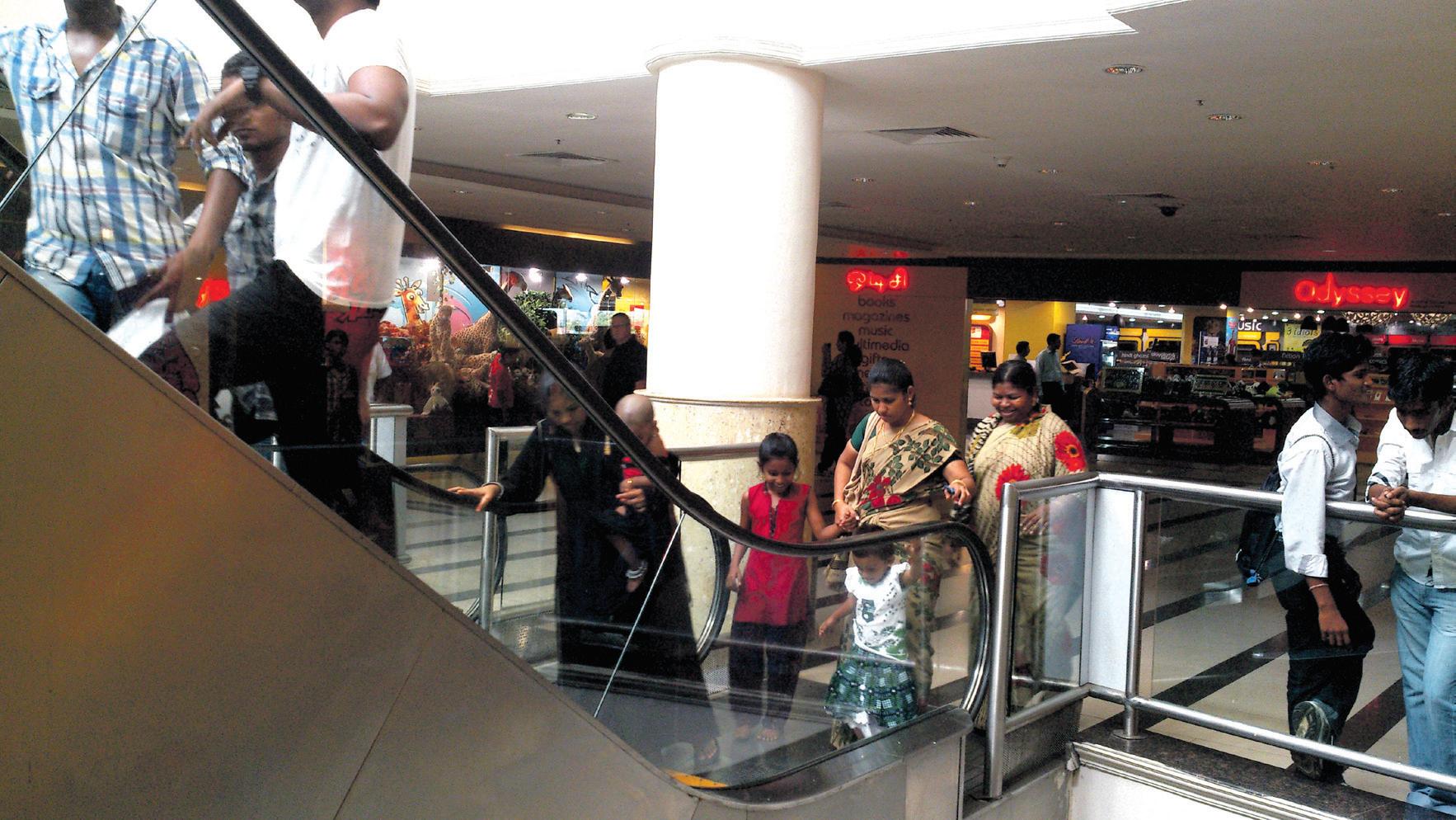
Workers sit in air-conditioned offices and deal with affluent Westerners before boarding dilapidated buses and dealing with clogged, potholed city streets.
On their way back to Indira gandhi International Airport, the four visiting BRICS delegations would have passed temples to both Hinduism and consumerism.

JUNE 2012 45 INDIAN LINK An Au SS ie Boy in Chenn A i
Leaders from Brazil, Russia, India, China and South Africa at their 2012 summit in New Delhi
IT firms and unfinished roads mark life on Chennai’s urban edge
Bengaluru’s modern skyline is the result of recent development
Hesitation before riding an escalator of success

46 JUNE 2012 www.indianlink.com.au
Rooms for Rent
If interested, call or leave message on: 0423 001 508.

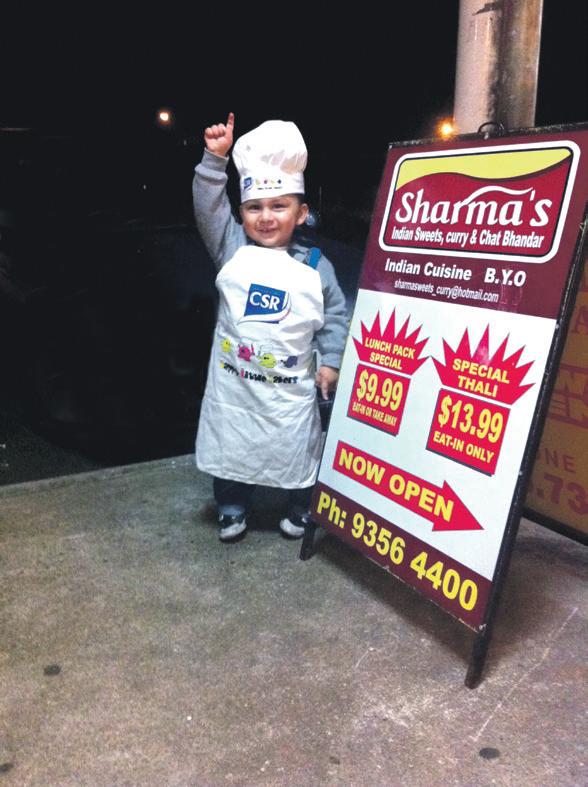


JUNE 2012 47 INDIAN LINK mention SHARMA’S in D i A n SW eet S OPEN 7 Days 11am - 10.30 P m • s h OP 4/350 TaylO rs rD, D E lah E y ALL PU n JAB A n D B eng ALI SW ee TS WE cat E r for all occasions • hom E d E liv E ry availabl E (g ULAB JU m A n, k AJU BUR f I , ALL T y P e S O f BUR f I A n D m A ny m OR e I n DIA n SW ee TS ) 25 yr E x PE ri EN c E i N sw EET s maki N g Ph: 9356 4400 A LL T y P e O f TRADITIO n AL I n DIA n SW ee TS AR e AvAILABL e H e R e
•Room is furnished upstairs bedroom with bed, mattress, desk, chair, dresser •Room has attached private toilet / shower / washbasin
•Room has attached spacious walk-in-wardrobe and storage area
•We will allow shared use of kitchen, fridge, washing machine, TV, DVD •House is close to park, shopping centre, bus stop •Room has heating and cooling
•Food (vegetarian and non-vegetarian) will be provided
•Rent $750 per month including food and reasonable use of electricity, gas, water
professional
family
We offer weekly intakes for all our courses!!!! IIPD strives in providing quality education with Experienced and friendly staff. Workplace assistance also provided. Reaching your potential is a dream come true!
We are a
Indian
with 2 kids (8 years and 6 years). We have up to two bedrooms available in our luxurious house for rent / boarding for a suitable single (male or female).
Korbo, lorbo, jeetbo
The KKR’s resounding victory at IPL 2012 proves that they can survive without their Prince, and win for their King
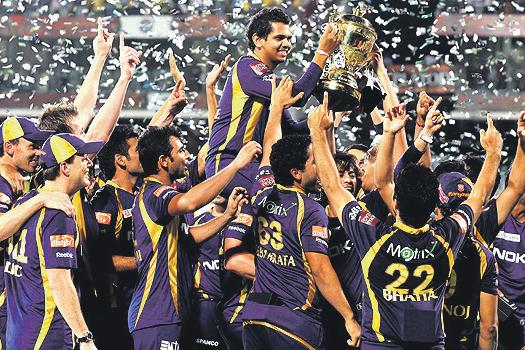 BY RITAM MITRA
BY RITAM MITRA

In the first three seasons of the Indian Premier League, the Kolkata Knight Riders was the laughing stock of the country, and indeed the cricketing world. Until last year, it was the only team to have never reached the semi-final stage, and even then it never seemed likely that they would take the title. It was a sweet victory then, for Shah Rukh Khan’s men, as they took out IPL 2012 in a comprehensive win.
From the very first edition of the IPL, Kolkata were an enigmatic team, fun to watch at the best of times, but positively frustrating at the worst. The glitz and glamour is still there (how could King Khan let it be any other way?), but importantly, it now plays second-fiddle to their cricket. The auction strategy itself showed their desire for a change in direction – Kolkata released all of their players in 2011 and forged themselves a brand new team.
The big story of the season began off the field, of course – as has been the case far too often with the Indian Premier League. Sourav Ganguly, the Prince of Bengal, had moved to the Pune Warriors as captain of the franchise. Split loyalties were but a formality, as was the case when Ganguly was ejected from the Indian team during Greg Chappell’s reign as coach, and spectators at Eden Gardens cheered South Africa on in their comprehensive thrashing of the hosts.
The conflict between Shah Rukh and Ganguly was wellpublicised and brought the actor a torrent of unwarranted criticism – for at the end of the day, the Prince of Bengal failed to notch up a half-century in the entire season, and scored at the lowest strike-rate and average for any batsman with more than 200 runs.

However no cricketer, and perhaps no sportsperson in the world commands as much respect and adoration as Ganguly does in Kolkata. Even Sachin Tendulkar has been booed at the Wankhede stadium in Mumbai.
Ganguly, though, carries with him an aura that stretches back to his days as captain – Ganguly was, and always will be, treated like royalty. From a Kolkata fan’s perspective then, it was purely absurd to have Ganguly captaining the Pune Warriors. Many had torn allegiances – if Pune won, Kolkata fans would rejoice in Ganguly’s happiness; it was as if Kolkata was just another hometown for Pune.
The Knight Riders started with a couple of underwhelming losses, which were exemplified further by the fact that Pune won three of their first four matches. Ganguly’s batting had left much to be desired, but after picking up two wickets in a crucial spell against Delhi, the eventual tabletoppers, Ganguly ran around the field like a schoolboy; his passion will forever be unquestionable.
Unfortunately for Pune, that was as good as it got – they lost each of their last nine matches, including both of their highly anticipated grudge matches against Kolkata. Kolkata, meanwhile, only got better as the season progressed. They were the most consistent team throughout
the group stages, hampered only by problems with the middle order.

Gautam Gambhir and Jacques Kallis were both in stunning form; however, it was little-known West Indian spinner, Sunil Narine, who stole the show and was named the Player of the Tournament. Narine confounded batsmen with his variations, and took 24 wickets, one less than tournament leader Morne Morkel, at the extraordinary economy rate of 5.47. The only other bowler with an economy rate less than 6 in this edition was none other than Lakshmipathy Balaji – Kolkata’s frontline seamer, who played a pivotal role throughout the tournament until injury saw him benched for the final.
The hallmark of the season for the Knight Riders is that there were very few highlights to speak of, in the most widely used sense
of the term. The team peaked only towards the back end of the tournament, quelling a vicious Delhi batting line up and then only scoring their highest score of the tournament in the final against Chennai. The only highlight Kolkata can point to is consistency – and perhaps the national team can take note of this.
Looking at the bigger picture, Gautam Gambhir led an outfit that will challenge strongly at the Champion’s League later this year. He also again pressed his own claims for leadership duties at the national level, having been unceremoniously dumped from the vice-captaincy earlier this year when selectors gave Virat Kohli the honour instead. It will have been a nice personal victory, then, for Gautam Gambhir to lead a team against his national captain in MS Dhoni, and come away on top.
Gautam Gambhir and Jacques Kallis were both in stunning form; however, it was little-known West Indian spinner, Sunil Narine, who stole the show and was named the Player of the Tournament.
48 JUNE 2012 www.indianlink.com.au Spo R t
Shatranj ka khiladi
Indian grandmaster Viswanathan Anand puts an incredible five World titles to his name
Perhaps to Shah Rukh Khan’s intense annoyance, the Kolkata Knight Riders victory seems to be overshadowed, and unthinkably, by another sport. And not any of the ones that involve a ball, but brains! It’s very likely galling to the vociferous KKR! But the rest of the nation, including some stalwarts in Kolkata, rejoice in the triumph of World Chess Champion Viswanathan Anand, who won the title for the fifth time, beating Israeli challenger Boris Gelfand in the tie-breaker in Moscow on May 30.
India, with its usual exuberant enthusiasm for anyone who performs well on the international arena, has quietly overwhelmed Anand with praise, felicitation and fanfare. From Prime Minister Manmohan Singh to Tamil Nadu Chief Minister J. Jayalalithaa, the accolades have been flowing in for the shy Anand, who has also been gifted Rs 10 lakh from the union sports ministry, as announced by Sports Minister Ajay Maken.
Anand is also being highly recommended to receive the Bharat Ratna, India’s highest civilian award, but it is for the Prime Minister to make a decision on this.
India’s five-time World Chess Champion Viswanathan Anand won the title for the fifth time, beating Gelfand 2.5-1.5 in the four-match tie-breaker. And with this win, India’s chess legend can rightly lay claim to be one of the all-time greats in the sport.
Widely considered as the greatest Indian sportsman, the 42-year-old Anand has been among the game’s elite for more than a decade and a half. The latest world title comes as an icing on the cake for Anand, who also established himself as the world’s best rapid chess player in the tiebreaker.
Anand first won the World Chess Championship title in 2000 beating Latvian Alexei Shirov in Tehran in 2000. He then followed it up with wins in 2007 (Mexico), Bonn (2008), Sofia (2010) and now Moscow (2012).
The win adds lustre to his six chess Oscars. Anand has won the Chess Oscar “an award given by polling votes from the global chess fraternity, including players and best writers across the world”, a record five times with the wins coming in 1997, 1998, 2003, 2004, 2007 and 2008.
Anand, who learnt the game from his mother, Susila Viswanathan at a tender age, learnt the nuances while following the game in Manila, Philippines, where his father, R. Viswanathan, a senior railway officer, was posted for some years in the early 1980s.
Anand’s early success in the sport came in 1983, when at the age of 14 he stunned the field with a nine out of nine perfect score while winning the National SubJunior Chess Championship.
A year later he became the youngest Indian to win the International Master’s Title at the age of fifteen in 1984.
By 16, he was the National Champion and he won it twice more and then concentrated on becoming a champion at higher international levels.
Playing his moves at great speed, he earned the nickname of ‘Lightning Kid’ and also ‘Tiger from Madras’ and in 1987, he returned to Manila, to win and become the first Indian to win the World Junior Chess Championship.
In 1988, at 18, he earned three Grandmaster norms within a span of less than 12 months and in December, he became India’s first Grandmaster.
Then followed Anand’s spectacular rise in world chess.
Anand’s first big moment came
at the Reggio Emilia tournament in 1991 where he finished ahead of Garry Kasparov and Anatoly Karpov and signalled his arrival on the world stage.
In 1991, Anand lost in a tiebreaker to Anatoly Karpov in the quarter finals of the FIDE Knockout World Chess Championship.
Anand also played in the Kasparov-promoted Professional Chess Association and reached the final, losing to Kasparov in New York City’s World Trade Centre. After eight draws, which was a record for the opening of a world championship match, Anand broke through with a win in the ninth game.
But then the more experienced Kasparov hit back and won four of the next five games, and went on to win the match 10.5-7.5.
In 2000, with Kasparov and Kramnik staying away, Anand’s win at the FIDE World Championships in New Delhi and Tehran did not impress the chess fraternity, which still considered the classical match-play as the real world title.
But on the tournament circuit, Anand continued his domination in various forms, winning Advanced Chess tournaments in Leon, Spain, the Chess Classic of Mainz, where he won the title 11 times.
His five successes at Wijk Aan Zee have been a record, and he has also won in Dortmund and Linares.
In 2007, he won the LinaresMorelia with the world’s top players in attendance, though Kasparov had retired by then. The tournament was played to crown the undisputed world champion and Anand was finally the one.
Then with critics still claiming Anand had not won a title in match-play, he came up against Kramnik, who had dethroned Kasparov. Needless to say, Anand won and claimed his title in matchplay, becoming the only player to have won the world title in three formats.
Apart from five Oscars, his other awards include the Arjuna award for Outstanding Indian Sportsman in Chess in 1985; the Padma Shri, National Citizens Award and Soviet Land Nehru Award in 1987; the inaugural Rajiv Gandhi Khel Ratna Award, India’s highest sporting honour in the year 1991-1992. He has also now been nominated by All India Chess Federation (AICF) for the Bharat Ratna, the highest civilian award.
Over the past fortnight, Anand had to fight it hard against Gelfand to retain the title for the third time and in the press
conference following the win, Anand admitted that he was still too tense to rejoice in his victory. “Game one was a tense start. It was a long and tough match. The match was very intense, I am relieved. I was better for most part in the second game. It was a back and forth game. The match was so even that I had no sense of what shape tiebreak would take. Right now the only feeling to have is relief,” Anand told reporters in Moscow after winning his third straight title at the renowned State Tretyakov Gallery.
The tournament went into the tie-breaker after Anand and Gelfand drew the 12th game on May 28. They were tied 6-6 after the final round.
Anand went ahead in the tiebreaker after winning the second game in 77 moves following a draw in the first. The first game ended in a draw in 33 moves.
The remaining two games ended in draws. It wasn’t any easier as Gelfand was a tough competitor. But with determination, courage and perseverance, Anand came through and walked away with the title.
So is Viswanathan Anand, World Chess Champion for the fifth consecutive time worthy of a Bharat Ratna? We certainly think so!
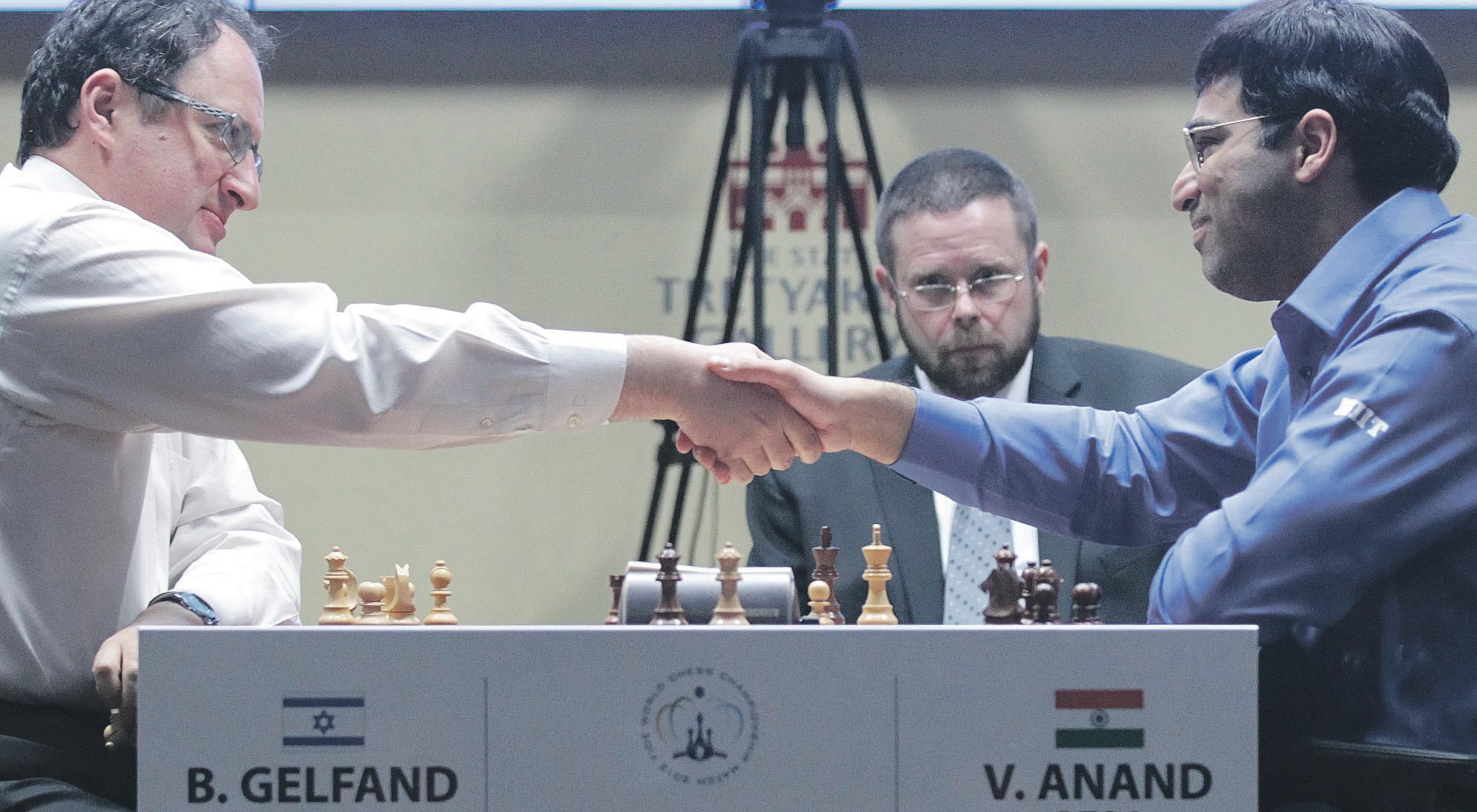
JUNE 2012 49 INDIAN LINK S po R t
Viswanathan Anand after defeating Israeli challenger Boris Gelfand 2.5-1.5 in a rapid tiebreaker round at the FIDE Chess World Championship final match in Moscow on 30 May 2012
Photo: AP
Cheers for cheese
BY SHERYL DIXIT
Living and eating in Australia, it is almost inevitable that cheese will sooner or later cross your path. For the desperately unfamiliar, the white, chewy topping that you find over your vegetarian pizza is also cheese – Mozzarella or Parmesan. If you are used to the standard commercial varieties and our favourite paneer from back home, discovering cheese can be a delight for any foodie, and can enhance your boastful array of hors d’oeuvres at your next social do. Of all the over 1000 varieties of cheese available we are most familiar with Gruyere, Haloumi, Brie, Edam, Camembert, Provolone and the even humbler and more familiar ones like cheddar, Gouda, Colby. Blue cheeses like Roquefort, Stilton, Gorgonzola and the aromatic Limburger are an acquired taste, while Fetta in all its varied flavour is a delightful accompaniment in salads.
Nowadays, cheese can found in different flavours of herbs and condiments, as well as smoked, aged, wood-fired, and many other
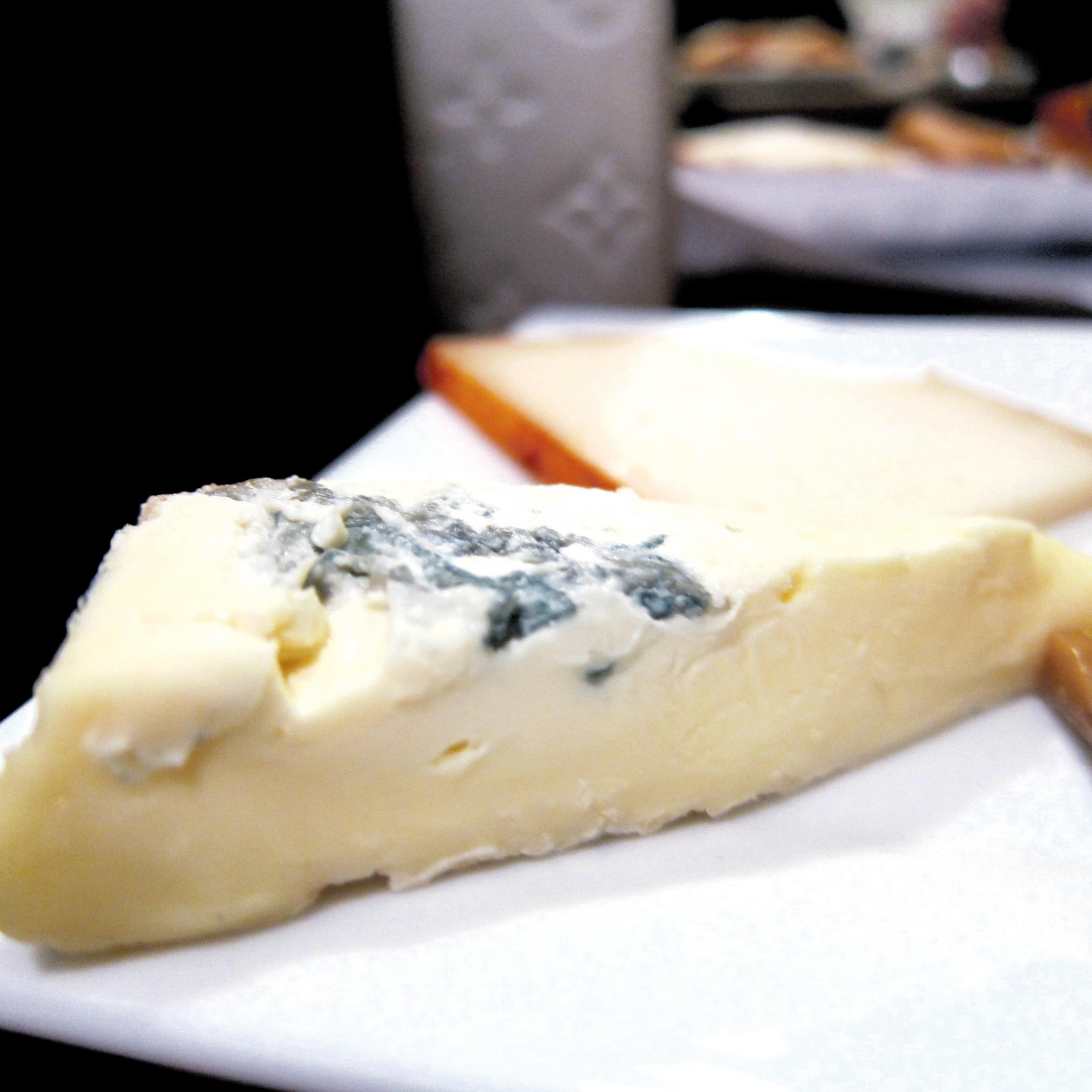
interesting and unique varieties. Cheese is mostly made from the milk of cows, but cheese can be made from sheep, goat, buffalo, reindeer, camel and even yak milk.
Some extremely rare cheese like the one made from moose milk is also extremely expensive, priced at $500 per pound, and is produced in northern Sweden. Lesser expensive varieties are Gorau Glas, an award-winning, blue-veined cow’s milk cheese from Wales, priced up to $40 a pound, or Bitto, a mixed cow and goats milk cheese from the Italian Alps. A cheese platter with grapes, crackers, olives and other antipasto options accompanied by a good white, red or rose wine can be an epicure’s delight.
Whatever the type, there’s something about cheese that lends itself to cuisines from all around the world. On its own or as an accompaniment, cheese can be an entrée, appetizer, ingredient, and can be trusted to make any meal special.
The recipes below are a mix of the traditional and the unusual, with the option of Indianising them to suit your palate, or dropping some ingredients to retain just basic flavours.
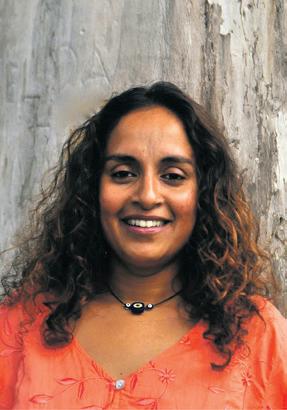
Cheese drops: Crunchy and chewy
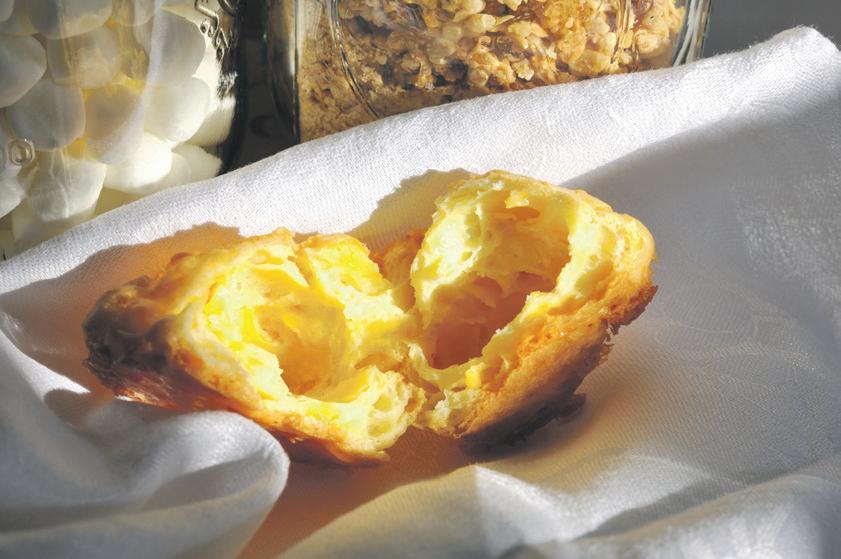
1 cup cornflour
1 cup grated cheese (parmesan, cheddar or tasty)

½ cup milk
1 pinch baking powder
1 egg
1/3 cup breadcrumbs
1/3 cup finely chopped chives
1/3 cup finely cut ham (optional)
1 small garlic pod, finely cut
1 pinch pepper
Salt to taste
Oil for frying
Sift the cornflour into a bowl, then add baking powder and milk, mix gently taking care that no lumps remain. Add egg to the mix, next stir in grated cheese to form a thickish mixture. Add chives, ham, garlic pod, breadcrumbs, pepper, salt and mix thoroughly. Keep aside for 15 minutes. The mixture will expand slightly. Next, heat oil in a deep-bottomed frying pan. Scoop out small circular portions of the mix and drop into the hot oil, deep frying until golden brown. Place on colander for excess oil to drain out, then serve hot.
Paneer burji:

An old favourite
200 gms fresh paneer
1/4 tsp cumin seeds
2 green chillies, finely cut
1 small onion, finely cut
¼ tsp turmeric powder
¼ tsp garam masala powder
¼ tsp coriander powder
1 tsp ginger-garlic paste
1 medium tomato, finely cut
1 tbsp chopped fresh coriander
Salt to taste
1 tbsp cooking oil
Place a deep-bottomed pan on high flame, add the cumin seeds and roast lightly. Then add the oil and once heated, add the chillies, onions and ginger garlic paste. Fry for a minute until the onions turn soft. Add the turmeric, coriander and garam masala powders and fry for a minute. Next, add finely chopped tomatoes and fry till they become soft and pulpy, and are fully mixed with the masala. Add grated paneer and salt to the mix and fry thoroughly until the ingredients are well-combined. Garnish with chopped coriander and serve with hot rotis or chappatis.
Blue cheese gougères:


A touch of france
1½ cups water
10 tablespoons unsalted butter
¾ teaspoon salt
2 cups unbleached flour (or bread
flour), sifted
5 large eggs
1 cup blue cheese, crumbled
½ tsp freshly ground black pepper
1 egg, beaten
Preheat oven to 180 degrees C.
Butter a large baking sheet and
keep aside. In a saucepan over medium-high heat, combine water, butter, and salt; bring just to a boil and remove from the heat immediately. Add all of the flour at once, to swell the starch and dry the dough. Stir constantly until blended, making sure that there are no lumps. Return pan to heat and continue stirring until the mixture starts to dry out and pull away from the edge of the pan. Remove and let it cool. Add the eggs one at a time, mixing until well blended. The dough should be soft and shiny. Add the blue cheese. Season with black pepper and more salt if needed. Scoop up a tablespoon-full of the dough and place onto the prepared baking sheet; continue until all the dough is used up in cocktail sized puffs. Leave a small space between each as they will expand. Glaze the top of each with beaten egg, dusting black pepper over them, if you wish. Bake for about 30 minutes or until puffed and golden brown. Pierce the top of a gougère to ensure that it is fully baked. The inside should be hollow and dry. Remove and serve warm from the oven.
F oo D
Available in an astonishing array of options, this nutritious, versatile and delicious food lends its original taste to any kind of cuisine





JUNE 2012 51 INDIAN LINK Register your interest today: Mr Sanjay Agrawal Contact Number : 03 9413 1481, Mobile No : 040202 3502 Email : sanjay.agrawal@unitedpetroleum.com.au
Choosing a chef
When one has no culinary inclination whatsoever, there’s a simple solution to delicious meals
equipment. There were diplomas and degrees available to students wanting to take cooking courses.
BY RANI JHALA
She came from a society where women served two purposes – producing the next generation and preparing the next meal. Her great-grandmother did it, her nana did it and her mum did it. As a child, Anita had decided that she was not going to follow either of these traditions.
And she was proud of the fact that she had reached the ripe old age of twenty-five without creating one single dish. Apart from making coffee and heating up pre-packaged food, her only other skill in the kitchen was making toast. In an age when everything was easily available in the supermarket, it was not hard to fulfil her promise.
When she got her dream job as a book reviewer, Anita wrote and maintained the Books 2 Read section of the city’s fortnightly woman’s magazine. She reviewed books from different genres, carefully selecting them from the thousands released each week, knowing that her articles guaranteed them a place on the best-sellers list. This power also placed an immense responsibility on her to give an honest and accurate review.
With the new trend in the entertainment industry of reality shows, it was but natural that these shows would have an impact on the publishing industry. People were either writing memoirs or taking out books in their line of expertise. Gardening, renovations and cookbooks were the most popular of lifestyle books. Answering a need, Anita found herself seated at the live recording of a reality cooking show.
Yes! A cooking show! She was only there to interview the guest chef as he had recently released an interactive cookbook. It was a novel concept and her editor was determined that they get that first interview. In preparation for the article Anita had read up on a couple of cookbooks and even learnt a few basic cooking terms. She learnt that there were dictionaries that specialised in cookery terms. There were retailers solely dedicated to the sale of cooking utensils and
Anita could not believe that people enjoyed cooking so much that they took it as a subject.
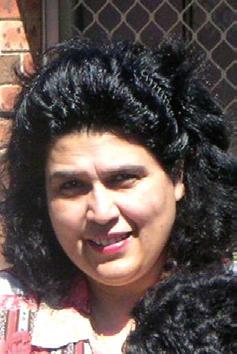

In the years between her childhood and now, ‘they’ had turned cooking into an art where everything had to be scientifically explained and precisely measured.
Anita thought back to her mother’s methods. It was a handful of this and a pinch of that. The food had to taste good. That was the gauge by which a cook was measured. These cookbooks spoke of calories and cholesterol. They categorised foods by the goodness in them, an alien thought for one who judged food on how it looked to the eye and tasted to the palate.
Anita even watched some televised cooking shows, but found herself switching off the television in frustration. How could anyone go so crazy over the freshness of fish, or the availability of a variety of mushroom or the smell of a spice? She wanted to scream back, “Get a life!”
She saw these shows as part of a lucrative business. A billion dollar industry that had been created around man’s natural need for nourishment! Everyone benefitted, from grocery stores to sellers of the produce but most of all, the sponsors. Their products were the first to be bought off the shelves.
Anita had to chuckle when she read how the chef believed that the emotional state of the person cooking greatly affected the outcome of the dish. She had tried so hard to convince her grandmother that this belief was mere superstition, created and spread by men, so that the women of the house felt it was their moral obligation to cook and maintain the mental wellbeing of the family. Here, decades later, man was propagating the same philosophy and the 21st century woman was buying it all over again.
Now seated in the studio, Anita watched with amusement as people rushed around ensuring that all was in working order. The ovens were tested, the ingredients checked and kept ready for the chef to use. Prepared samples of the dish at various stages of cooking were kept ready under the counter, just in case the original did not work out. The contestants were given last minute briefings while the hosts walked through the studio, familiarising themselves
with everything.
The recording started on time. The hosts introduced the remaining contestants and then welcomed the guest chef, Nick Sharlie. While everyone watched Nick enter, Anita watched the contestants. They were awed.
The sheer joy of meeting this chef was clearly visible on their faces. He was like a God to them.
“You have to be kidding!”, Anita thought to herself. “For heaven’s sake, he’s just a cook!”
When she turned to finally face the chef, it was her turn to take a deep breath. She had seen his photograph on the book cover, but now standing in front of her was a very good looking man in his thirties. Dressed in dark jeans and a white T-shirt, he spoke in an articulate manner. Anita could not dismiss his looks, but what got her interest, was the love he had for a task that she so abhorred. He was truly enjoying deboning a fish, dicing onions and crushing garlic. He was like a man in love. So totally in love with his cooking, that it showed in his eyes. She had seen that same look in a nun’s eyes as she spoke of her calling, during one of her previous interviews. Anita smiled to herself. What a waste, to show all that emotion for a mere culinary skill. At that very moment, Nick looked up and straight at her, and his eyes showed that he had read her thoughts. The next moment, he turned his attention to the dish in front of him and was once again lost to his art.
Once his recording was over,
Nick’s manager brought him over for the interview, which she conducted at the café nearby. She learned that he had always loved cooking. His grandma has been his inspiration. His prized possession was a family journal with his grandma’s recipes. He had been bullied for opting to taking cooking as an elective in school. That he did not believe the kitchen was either a man’s or woman’s domain, rather it was a shrine for the one who recognised its worth. That every dish he prepared could be made by anyone and that experience gives the confidence to create variations. And that it was this view that inspired his latest project - an online interactive website. Every day, he would put up basic recipe and his subscribers were requested to try variations and post them if they were successful. He picked the best one each day and these were compiled into a monthly cookbook. And he guaranteed that he could bring out the cook in her. It was here that Anita asked her last question, “What if one honestly and truly does not like to cook. What if one, really does not want to be a chef?”
And Nick replied, “I can’t speak for others, but if ‘you’ don’t want to be a chef, the answer is very simple…” Then a moment later he added, “You must marry one!”
Eight months later at their wedding, she had to laugh when she overheard the conversation between her grandmother and Nick. She was taking down his grandmother’s prized recipes.
Anita had to chuckle when she read how the chef believed that the emotional state of the person cooking greatly affected the outcome of the dish.
He did not believe the kitchen was either a man’s or woman’s domain, rather it was a shrine for the one who recognised its worth.
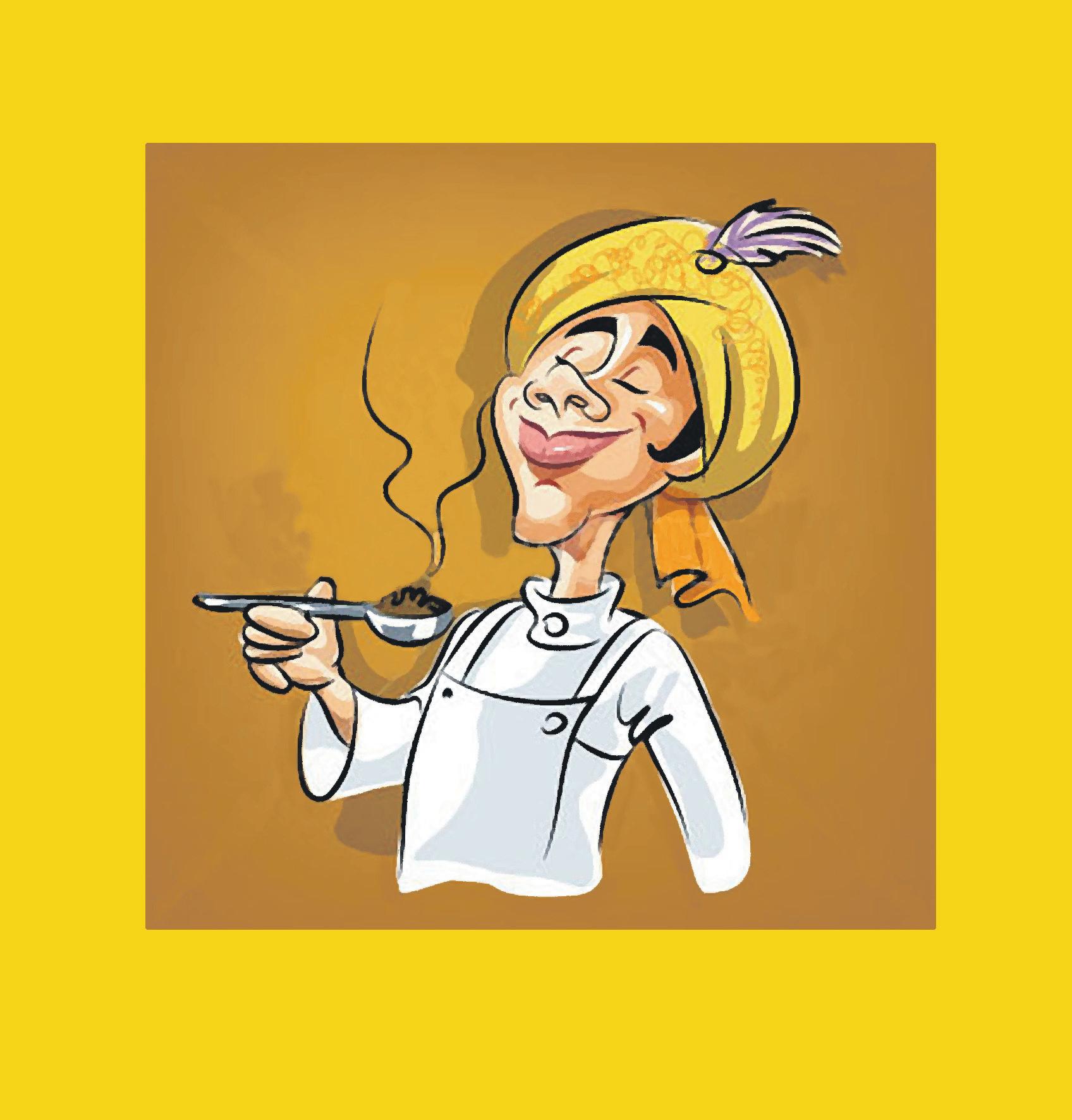
52 JUNE 2012 F i C tion

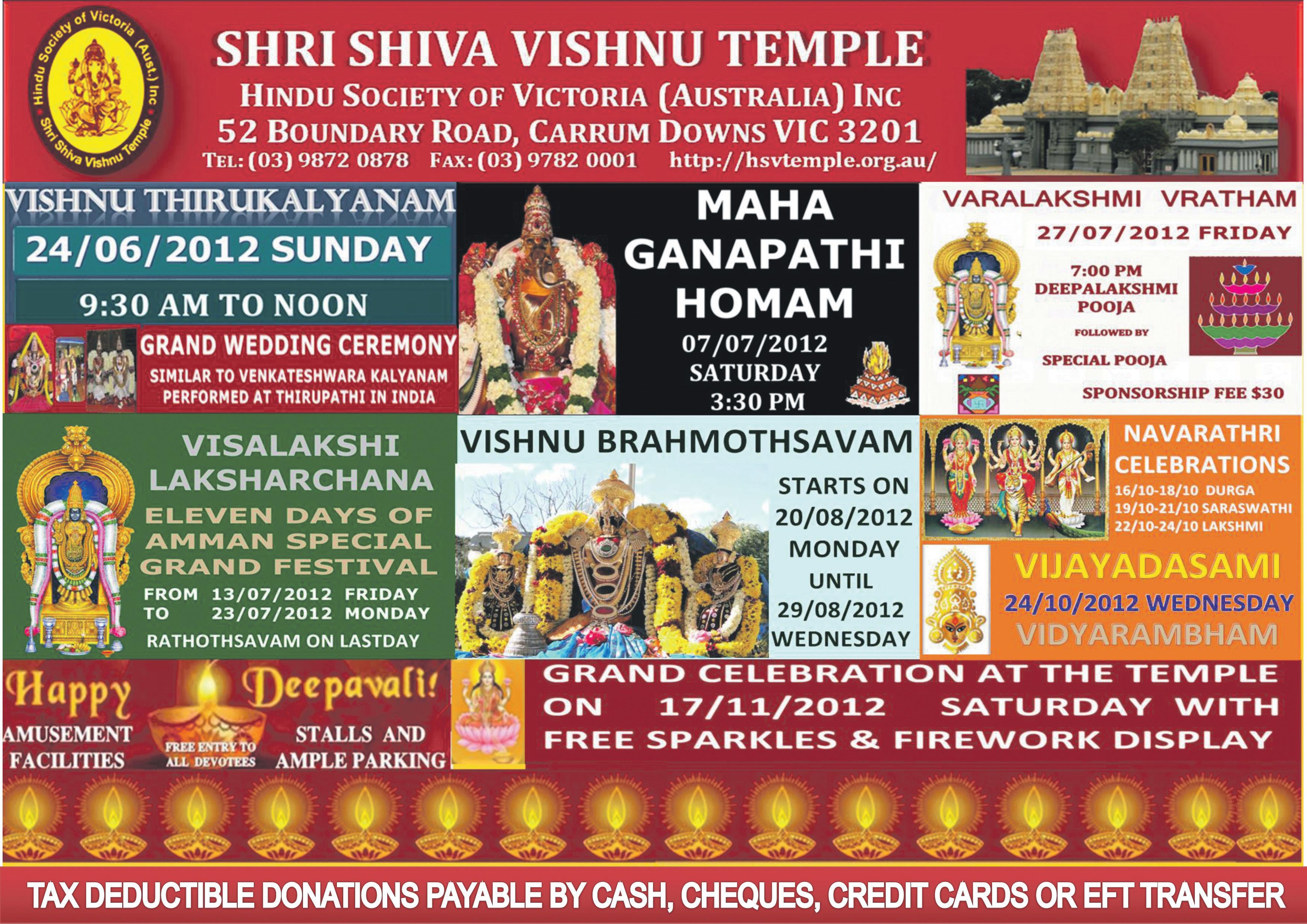
JUNE 2012 53 INDIAN LINK
TAROT
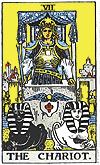

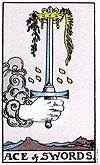
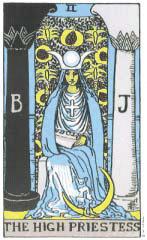

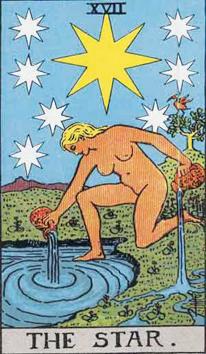
ARIES March 21 - April 19
This is a great time to do your best in all situations. There is a new energy around you right now and whatever you do will yield amazing results. There will be major changes this month. There will be some friends who will not like the changes in your life. You will feel physically fit too. The cards indicate a bright fresh time to excel and shine.

TAuRuS April 20 - May 20
This month you will feel like you have so much to do and have no time to finish all your tasks. The cards indicate that you may feel pent up, with a lot of things to finish. You will feel at ease after the 20th as there will be more energy around you. There may be money to pay out this month, so be careful.
GEMINI
May 21 - June 20
The cards indicate a time where you will be busy with trying to get your life sorted out. The weeks will feel like months, as this will be a time for lots of work and hardly any play. There is an indication on the cards that you will be looking to move from your current employment. You may take time out to settle your relationship.
CANCER June 21 - June 20
The cards indicate that this is a time of great achievement this month, with your work and career on a real high, and opportunities to shine presenting itself. There is also the likelihood of a new romance around you. There is also a time of deep thinking this month about where you really want to be and what you want to do.
LEO July 23 - Aug 22
The cards indicate a great time for you to reap what you have sown, to gather in the harvest of your hard work. Your past efforts are coming to great fruition. Your work and career is going well and you are feeling much happier and more focused. There is more money around you this month. There is also a love interest that you are pursuing.
VIRGo Aug 23 - Sep22
The cards indicate a very busy time. Make sure that you keep on top of all your paperwork and even your bills. There is also a sudden trip you may need to take. Do not worry about a relative’s health, things will be fine. Do take care of your own health as you will be very stressed out this month, for one reason or another.
PREDICTIONS fOR JUNE 2012
 By NANCy JADE ALTHEA www.nancysood.com
By NANCy JADE ALTHEA www.nancysood.com
LIBRA Sep 23 - Oct 22
The cards indicate a time of great activity for you. You will be making many changes around your personal and professional life. You are on a mission to spring-clean your life and you will also make some commitments in a relationship. Family may be on your mind as there are some members who are not getting on with each other, leading to stress.
SCoRPIo
Oct 23 - Nov 21
The cards indicate a time of work, as you will be totally engrossed and involved in your job and will find it hard to create time to meet the needs of those around you. There may be legal matters around you or close friends that need to be handled with care, so be alert. You will be thinking about proposing to your lover this month.
SAGITTARIuS Nov 22 - Dec 21
The cards indicate a great time for you and your lover. You have decided to make things better and will be making all the right moves to progress your relationship. You have not been as supportive as you could have been of late. Your work is becoming a little stressful, so take time out and make sure you get enough sleep to help you relax.
CAPRICoRN Dec 22 - Jan 19
This month will be all about your security and stability. The cards indicate that you will be doing a lot of financial planning for your future, and it is also indicated that this is a good time to purchase property. You may find yourself in the mood for companionship, so this is a great time to get out there and meet new people.



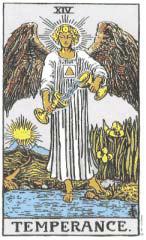

AquARIuS Jan 20 - feb 18
The cards indicate a time of great communication and you will receive a letter for which you were waiting. Be patient as you have a lot on your plate and you will achieve what you have set out to do. You may need to go for a medical check up, which is overdue. You will also come to an amicable solution in a romantic connection.
PISCES feb 19 - March 20
The cards indicate a time of increased spending, you will want to buy presents for your lover. Make sure you buy yourself something nice too, and go for a long swim or walk as you need time to relax and chill out. You have been worrying a lot lately and not sleeping too well. An interesting time is coming up, as you plan for your future.
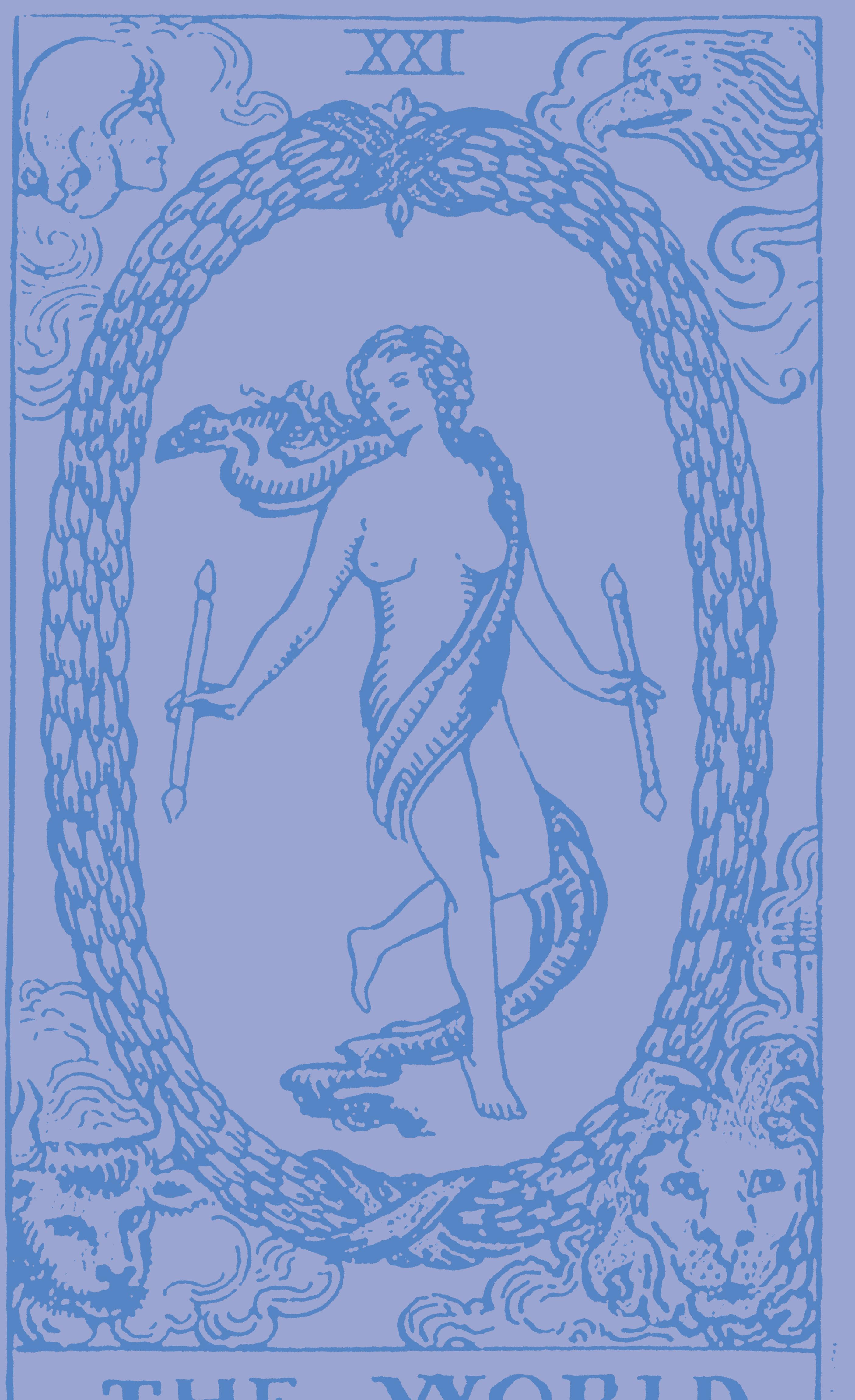
STARS FORETELL
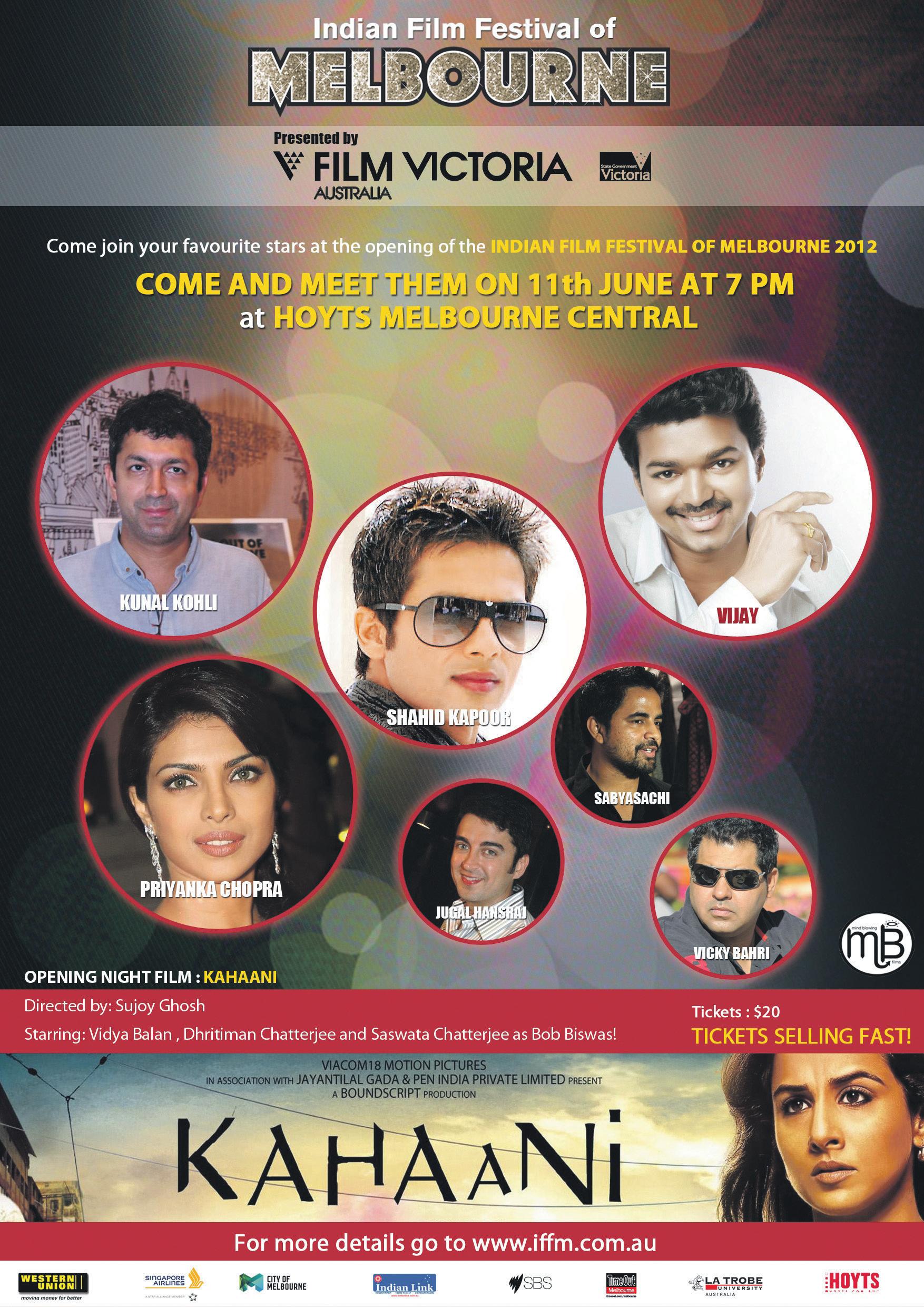
JUNE 2012 55 INDIAN LINK
the Buzz
kat’s keeping busy
Poor Katrina Kaif! She’s shooting heavy duty action sequences with Salman Khan in Thailand for Ek Tha Tiger, but instead of spending her time off shopping or lounging by the beach, the actress is training by night for her forthcoming action sequences, which include handto-hand combat, with Aamir Khan, for Dhoom 3
“Aditya Chopra has flown in three special trainers for Katrina to get bodytoned for her action sequences with Aamir in Dhoom 3,” said a source, adding that the trainers have to make her look convincing as a combatant assassin in the movie.
And Kabir Khan is making the actress do other kind of stunts in front of the camera as they shoot during the day. An on location source revealed, “It’s two completely different kinds of action discipline for Katrina on camera for Ek Tha Tiger and off camera for Dhoom 3. And it’s sapping her energy. Her metabolism is confused - as during daytime she is doing hardcore raw action with Salman, and in the night she trains for highly sophisticated Jackie Chan kind of flips and somersaults for Dhoom 3”. Luckily, for the over-exerted diva, she now has some reprieve on the Dhoom 3 front. Apparently Aamir Khan has informed his producers that he is not quite ready for action. So poor Kat can take a break. Well, we’re just glad that Kat will feature in her toned, super-glam body on the big screen before long… watch this space!
gUeSS WHO
?
Wasseypur premiere gets full house at Cannes
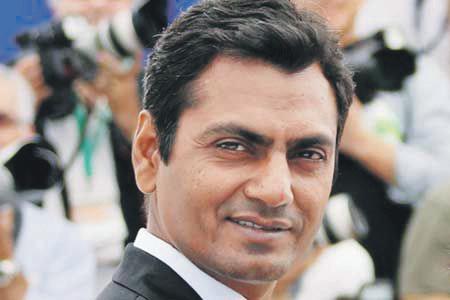
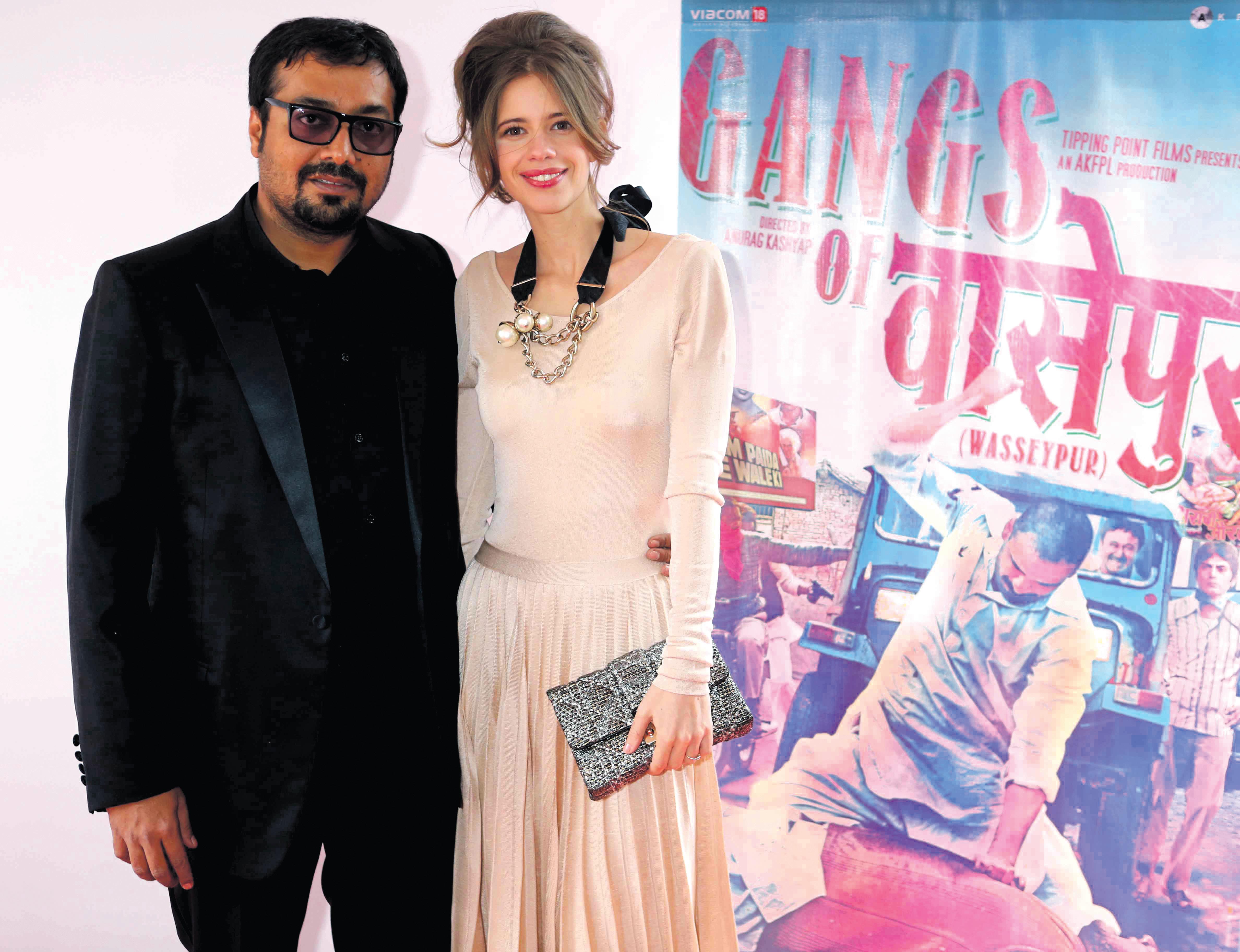
We’re waiting with bated breath for the Sydney film fest to screen Anurag kashyap’s Gangs Of Wasseypur. The 5 ½ hour epic, screened in two parts, saw a packed audience at the at its world premiere at the 65th cannes International film festival recently.
eager crowds lined the streets outside the JW marriot hotel at Cannes for the show, while Bollywood celebrities kalki koechlin, ( Anurag’s wife) Huma Quereshi, Richa Chadda and Reema Sen walked the red carpet. Also attended by kashyap, male actors manoj Bajpayee and nawazuddin Siddiqui and female music director Sneha khanwalkar, the premiere saw a full house in an 800-seating-capacity hall.
Both parts of Gangs Of Wasseypur, a gritty take on the coal mafia, were screened at the festival’s Directors’ fortnight, a non-competitive section. Sadly for Sydney fans, director Anurag will not be here to introduce the film. He will be busy with preparations as the film hits the screens in India on June 22.
Big B turns nostalgic on 39th wedding anniversary
Megastar Amitabh Bachchan and Jaya Bachchan have been married for a whopping 39 years, and they seem a fairly content couple. Despite both enjoying celebrity status in their own right and being grandparents, the couple are still going strong and seem to have moulded into a cocoon of affection and caring which should be an example to all couples, young or old. Celebrating their wedding anniversary made the Big B nostalgic, as he recounted their wedding day on June 3, 1973 on his blog bigb. bigadda.com
Amitabh recounts that he and Jaya had planned a holiday in London to celebrate the success of Zanjeer, but his father Harivansh Rai Bachchan wanted them to get married before going on the vacation.
“Zanjeer had just released. And Jaya and I and a few dear friends had decided that if the film did well we would all go to London for a holiday. After a few anxious days on the results of the box office, it was time to put our decision ‘in line’. So I told my parents, who I had now invited to come and live with me, as is the culture in our land, about our decision. And my Father came down heavily on me - ‘If you are planning a holiday with this girl, you will have to marry her and go, else your decision is denied.’
“I was an obedient child! I got married the very next day in a quickly organised wedding with family and some dear friends, without any fanfare, and left for the holiday that very night,” he further posted.
Big B says that his wedding was not a lengthy affair.
“Weddings entail great amount of ritual and protocol and decorum and priests and pundits and maulvis. They last for days with great fanfare. Ours was a simple Bengali pundit wedding, exchange of flowered garlands, the mangalsutra, the sindoor and it was all over before the women from Jaya’s side could stop their finger-in-mouth screams of ‘odododooooo’ … or words to that effect,” he added.
Well, 39 years on, the marriage has persevered, their children have become successful and they’re content. The Bachchans have a lot to be thankful about. So good luck and here’s to hitting
-time’s back for Bollywood biggies
They snubbed it as small fry in comparison to the mega bucks doled out for featuring on the large screen, but now Bollywood’s biggies are queuing up to gain mileage on the small screen. Yes, Indian television is coming of age, with
ENTERTAINMENT
ABHILASHA SENGUPTA brings us up-to-date on what’s hot and happening in Bollywood (Find the answer under Caption Contest)
A n URAg-k AL k I
This talented actor has burst onto the screen in a major way in the past few months (Hint: he is pictured here at Cannes this year)
mainstream Bollywood actors, producers and directors taking a long hard relook at this medium for the masses.
Aamir Khan upped the growing trend with Satyamev Jayate, a well-researched show focussing on crucial social issues. Before that, of course, stars such as Amitabh Bachchan, Shah Rukh Khan and Salman Khan had discovered the reach of television. However, it was this hardhitting and socially conscious show from Aamir that brought about a change in attitude towards the small screen within Bollywood.
Now we hear that producers Vipul Amrutlal Shah, Ritesh Sidhwani and Sanjay Leela Bhansali are planning a bouquet of television shows covering anything and everything from soaps to social issues, reality shows and game shows.
Shah, who is making a comeback on TV after a long gap, explained the movement saying, “Whenever there is a platform, which is strong and powerful, everyone wants to work on that. Everybody recognises that TV is a very strong medium and has grown multi-fold. Its increasing popularity is the reason why people from silver screen are coming on TV.” Shah’s successful past skirmish with TV was in 1999 with Ek Mahal Ho Sapno Ka. He has now returned to the small screen, producing Bhai Bhaiya Brother
Ritesh Sidhwani is ready with a game show for television, teaming up with Farhan Akhtar to bring in a new and enthusiastic audience. Bhansali, too, is keen on bringing his style of lavish filmmaking to the small screenalbeit as a producer of serial soaps. “TV is the most powerful medium today, and it will grow even more powerful tomorrow. I feel it is important for my work to reach out to the homes of the people, rather than people coming to the theatres to watch my work,” said Bhansali, whose film splendorous, to say the least!
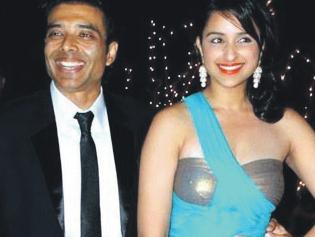
YRF TV, a wing of Yash Raj Films has already done shows like Mahi Way, Rishta.Com, Khottey Sikkey and Kismat looking forward to a long and productive relationship with TV. So now Bollywood’s finding itself in competition with a rival it had long taken for granted. Watch out Bollywood, TV-time is here to stay!
Awaara will be aawara
Time magazine may have added Raj Kapoor’s Awaara to the All-Time 100 Best list of the greatest films made since 1923, but Kapoor brothers Randhir and Rajiv are strictly against remaking this and any of Bollywood legend Raj Kapoor’s films. “We don’t want to touch any of Raj Kapoor’s films,” they said. “We have given up the idea of making a remake of very difficult to reproduce the same magic now”. The showbiz brothers were speaking at a special screening of the movie to commemorate the acting legend’s 24th death anniversary. Raj Kapoor died on June 2, 1988, at the age of 63. Made in 1951, Awaara was one of the classics which showed Kapoor in the role of a tramp. The film also had Nargis, one of the prime actresses of the golden era.
Even though the Hindi film industry has some of the best talent today, the brothers feel that there is no comparison to Raj Kapoor.
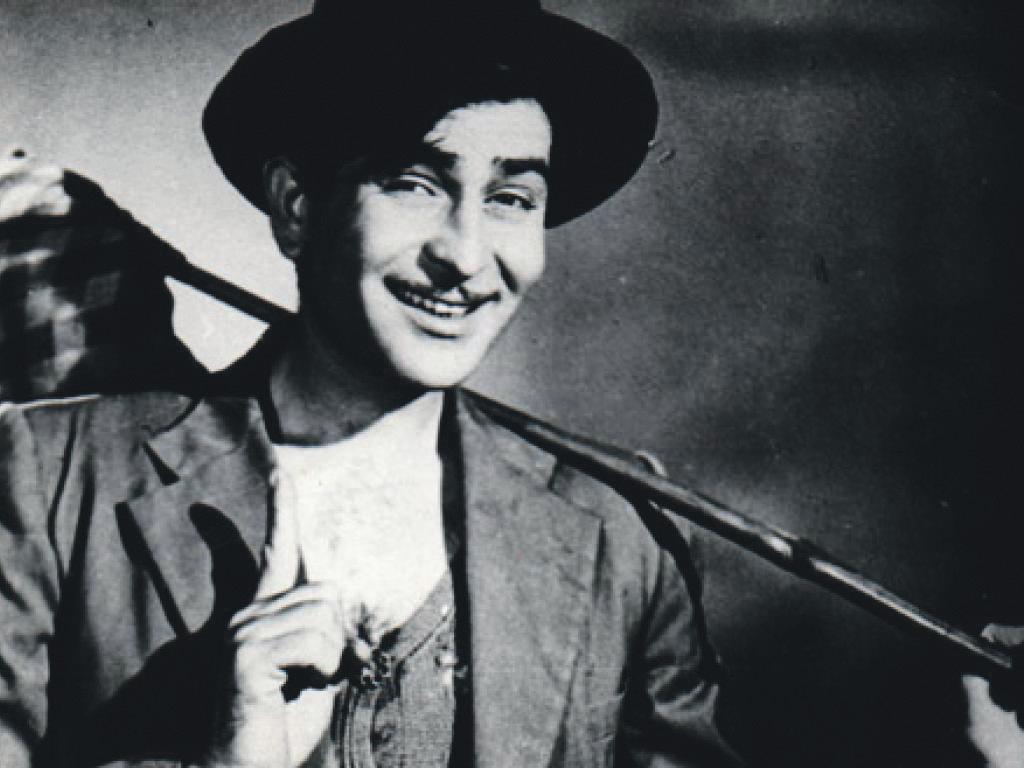
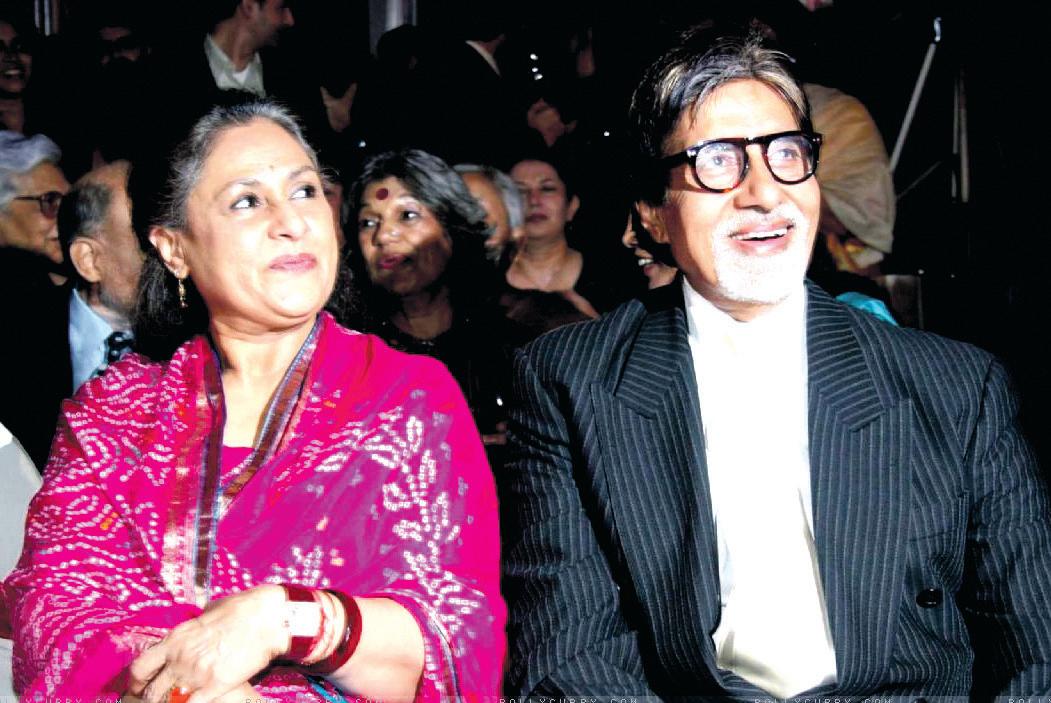
“There is no actor like Raj Kapoor today. People remember him today because of his showmanship. We are so happy that even after 60 years, people watch his films. Till the time people love
has received acclaim from the audience and critics alike, leading Arjun to state that a star surname is not a criterion for recgonition, but good work is. “You are as good as what you do in front of the camera. Nothing else matters, your surname, from where you come or where you will go ... The audience is very intelligent. It gauges you and knows if they want to see you or not,” the 26-year-old said, of his debut in Arjun made his point by citing the Band Baaja Baaraat actor Ranveer Singh. “Ranveer is a prime example of that. Somebody like him came out of nowhere. It just shows
What’s Aish whispering to Abhi here?
Aish: Abhishek, you’ve got to protect me this time – they’re all talking about my weight gain. Can’t you open your mouth at least once and stick up for me?
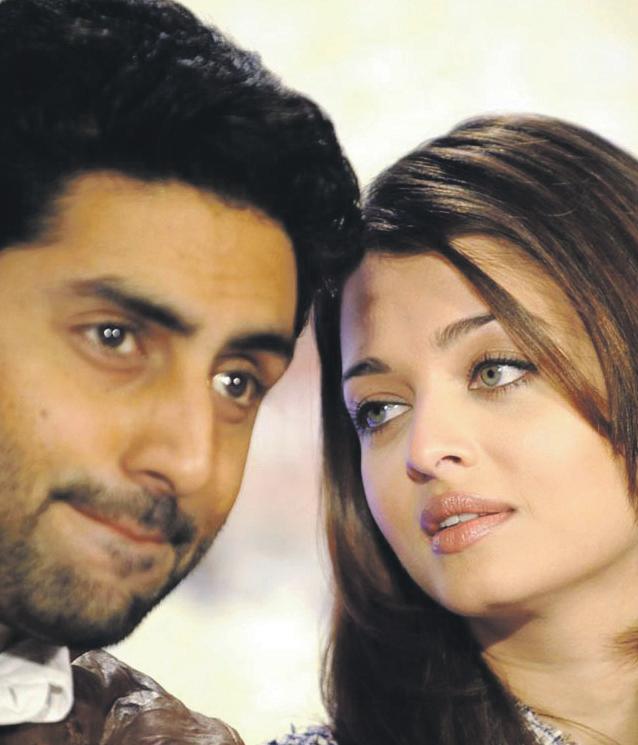
Pankhuri Goel Champion Lakes WA
Pankhuri wins a double pass to new Hindi film Rowdy Rathore
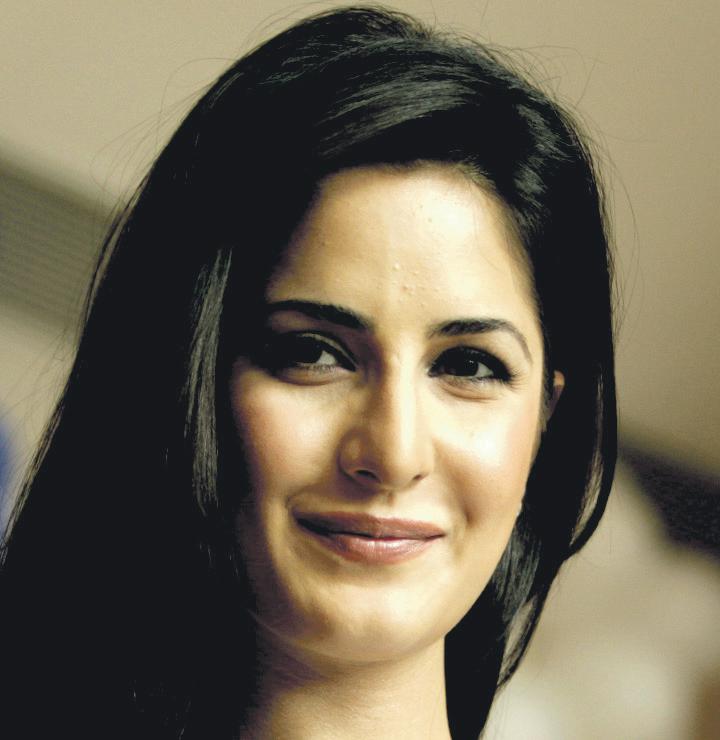

champions Dempo to pick up stakes in the Goa-based sports club.
The King Khan’s interest has excited soccer clubs, who have struggled for recognition from sponsors in a bid to keep the sport alive at a national level. Talks are still in progress, but it’s a tremendous boost and one that is likely to have a domino effect, as other star celebrities begin to emulate SRK, perhaps with the hope that they can emulate his success!
Dempo, India’s most successful club in recent times, has an annual budget of around Rs.12 crore. But Shah Rukh’s involvement will surely be a boon for the club, and will very likely bring in a raft of sponsors. So there is hope for soccer in India, and kudos to SRK for going beyond the cricket.
JUNE 2012 57 Last issue Caption Contest winning entry CAPTION CONTEST Answer to GUESS WHO? Nawazuddin Siddiqui What’s the chitchat between Uday Chopra and Parineeti Chopra here? Send in your responses to info@indianlink.com.au and win a surprise prize
kATRInA kAIf
RAJ kAPOOR
AkSHAy kUmAR
AmITABH-JAyA
Cine Talk
Crazily colourful and rollicking fun
Rowdy Rathore races on the premise that heroes are made by circumstances, not design. That’s how the street-smart Shiva ends up in a town run by garish goons, where homes, humans and hopes are burnt in effigies mocking human rights.
It is an old-fashioned goodversus-evil comedy-actiondrama with paisa-vasool written in every frame.
Prabhu Deva, who earlier directed Salman Khan’s copon-a-rampage saga Wanted puts Akshay on the same page.
To his credit, Akshay manages to create his own world in that Salman-space. Never letting go of that twinkle in his eye, Akshay sinks his crooked teeth into the meaty double role with the warmth, affection and relish of a dinner guest who knows all the yummy dishes on the table have been cooked only for him.
Akshay goes for the sumptuous meal with the hunger of a man who may not see tomorrow. It’s high-octane
performance full of warmth and fury, never over-the-top, even when all hell breaks loose.
The fights are ferocious, but never gut-churning. You can watch the bloodshed with the kids. They’d know, Uncle Akshay is going to win.
The thing about Rowdy Rathore is it never takes itself seriously. The cop and his double won’t kow-tow to the powers-that-be. Ironically, the film grandly bows its head to the Great Bollywood Formula. The dialogues are bombastic, bordering on the corny, nevertheless fun in their intended ideological inferences.
A profound reverence for every trick in the book of filmic formulas sees the accelerated narration to its breathless finale. Even when the going gets gory, there is a tongue-in-cheek humour in the violence.
It’s not the arrogant aggression of Salman in Dabangg or Wanted. In Rowdy Rathore, Akshay creates a new language of heroic aggression. He is goofy, wonky, clumsy and oafish. He has no respect for
the rules of the office. But his character loves doing what he does, because a man has got to do what he has to do, and really someone has to do the dirty job of cleaning up the mess we’ve created.
Metal rods from rickety machines are wrenched out and used to teach the anti-socials a lesson. The ‘ouch’ is never unwelcome. Akshay creates a ‘no wince’ situation. Whether it’s wooing a Patna girl (Sonakshi Sinha) all over Mumbai streets and right into a wedding venue, or in the second half, taking on the vile villainy of a selfappointed lord of diabolism named Baapji (Nasser), who is so uncouth, unwashed and unmannered that he is downright funny in his obscene rowdyism.
The generous splash of colour and music (Sajid-Wajid at their peppy pinnacle) pitches the film at a massy level without toppling over into a revolting rowdyism.
Formulistic cinema has never been celebrated with more gusto.
Rowdy Rathore revives the years of Eastman colour cinema
in the 1960s and 1970s, when movies were crazily colourful and rollicking fun, when you knew the villains would get their cacaphonic come-uppance. Pulling out all stops to give us a spicy meal, Prabhu Deva succeeds in putting a dizzying spin into Akshay’s double-role act. Twirling his moustache in Rajputana pride, romancing the spirited small-town chick or beating up 23 goons with one weapon (self-determination), Akshay delivers a performance that makes you want to jump out of your seat, clapping, whistling and cheering in appreciation. While the fights are brilliantly conceived and executed, it’s Akshay’s courtship with Sonakshi that had me giggling non-stop. If he is outrageously coy in his wooing act, Sonakshi gives him tit-for-tat, matching steps with
FILM:Rowdy Rathore
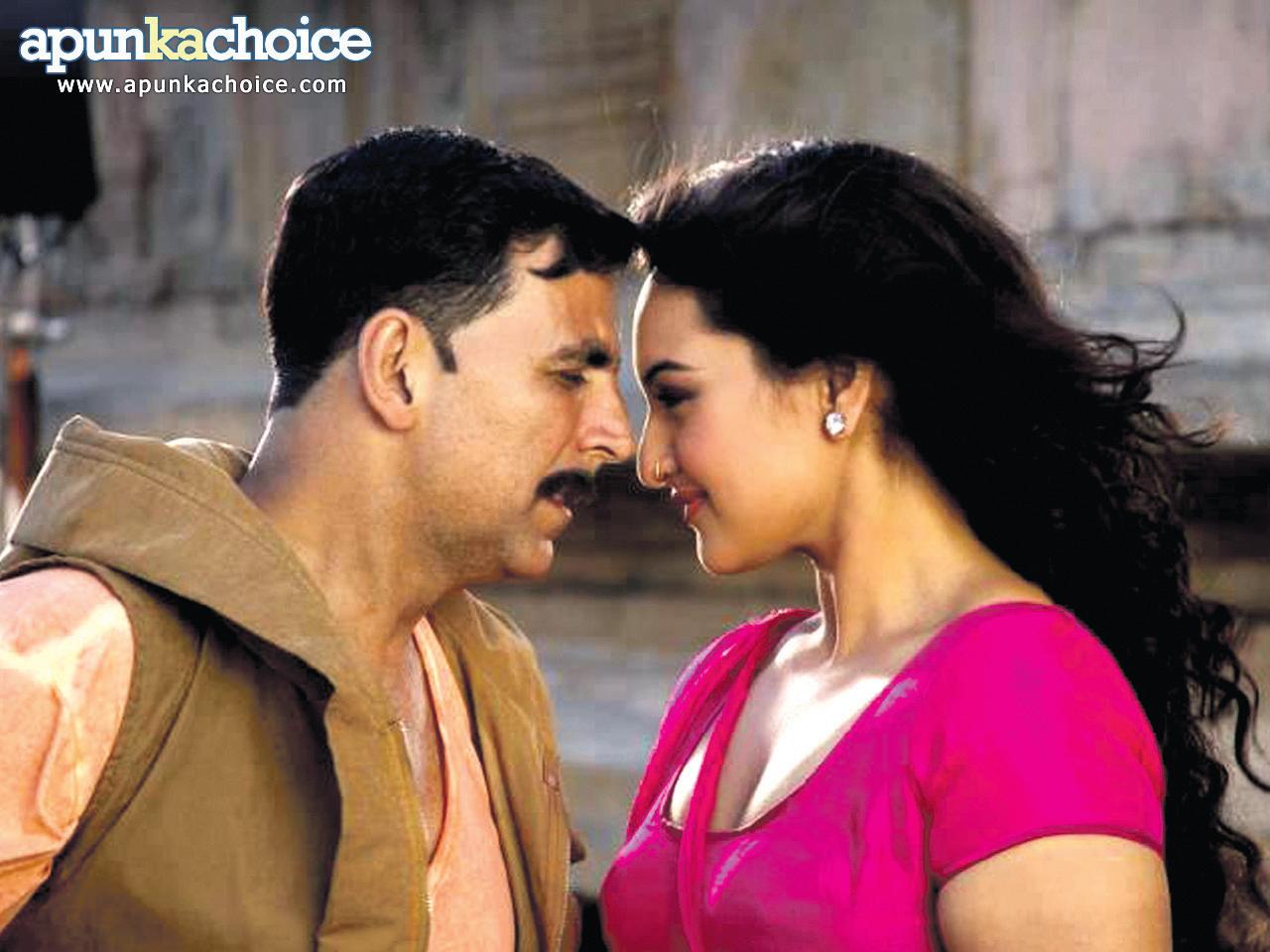
her far more experienced co-star, never letting the age difference daunt her.
The rest of the cast only has to stand around to extol and cheer our down-to-earth superhero cop. All the while, the narration never loses its tempo, warmth or humour.
The choreography ensures that the dances merge with seamless elan into the action. Rowdy Rathore is quite a gravity-defying feat. It often finds the villains being hurled into the air. But the narration manages to keep its feet on the ground. Really, Akshay as the angry cop is more entertaining than intimidating.
Three cheers for producer Sanjay Leela Bhansali for coming out of his comfort zone to celebrate the spirit of Hindi commercial cinema at its dizziest and craziest.
CAST: Akshay kumar, Sonakshi Sinha, yashpal Sharma
DIRECTOR: Prabhu Deva
58 JUNE 2012 www.indianlink.com.au
ENTERTAINMENT
Subhash K. Jha
A slice of today’s India
Watching Shanghai is revisiting your daily local newspaper, full of scams, conspiracies and crime stories. In short, the film is a slice of today’s India. Adapted from Z, a 1966 novel by Vassilis Vassilikos, Dibakar Banerjeer brilliantly exposes the reality behind the irony of India Shining.
The scenes are verbatim daily newspaper briefs.
Set in present day nondescript shanty called Bharatnagar, it sees Dr. Ahmedi (Prosenjeet Chatterjee), a USbased professor and activist, visiting Bharatnagar to enlighten its inhabitants about pragati (progress).
He opposes the transformation of the shanty town into a zany township, a la Shanghai. But he is murdered by the opposition who try to pass off his death as an accident.
After that the story moves ahead with Shalini Sahay (Kalki Koechlin), Ahmedi’s besotted student and daughter of an exarmy general who is involved in a scam, IAS Officer T.A. Krishnan (Abhay Deol), videographer Joginder Parmar (Emraan Hashmi), Ahmedia’s wife Aruna (Tillotama Shome), chief minister (Supriya Patak) and her PA (Farooque Sheikh).
While the film grips you, it’s the system that gets to you.
“Why did you do commit the murder, when you knew it is wrong,” Shalini asks the murderer.
Another dialogue Jeene se haraam lagta hai, par marne se darr bhi lagta hai... clearly shows the hunger for survival. It’s a sorry state of affairs, where the common denominator is the victim. There is a simplistic nature to the narrative and archetype.
The performance of every character is realistic and matter-of-fact. Emraan impresses with his rustic portrayal, quite different from his usual flamboyant characters. Abhay Deol, as the IAS officer,
bowls over the audience with his grit and, of course, unmistakable Tamil accent. Kalki slips effortlessly into the character, yet again, revealing her versatility. However, what you take home is not the memories of a character well-performed, but the story.
The film is frighteningly true.
The strength of Shanghai is its tight screenplay by Urmi Juvekar and Dibakar Banerjee and the meticulous details leave no scope for arguments.
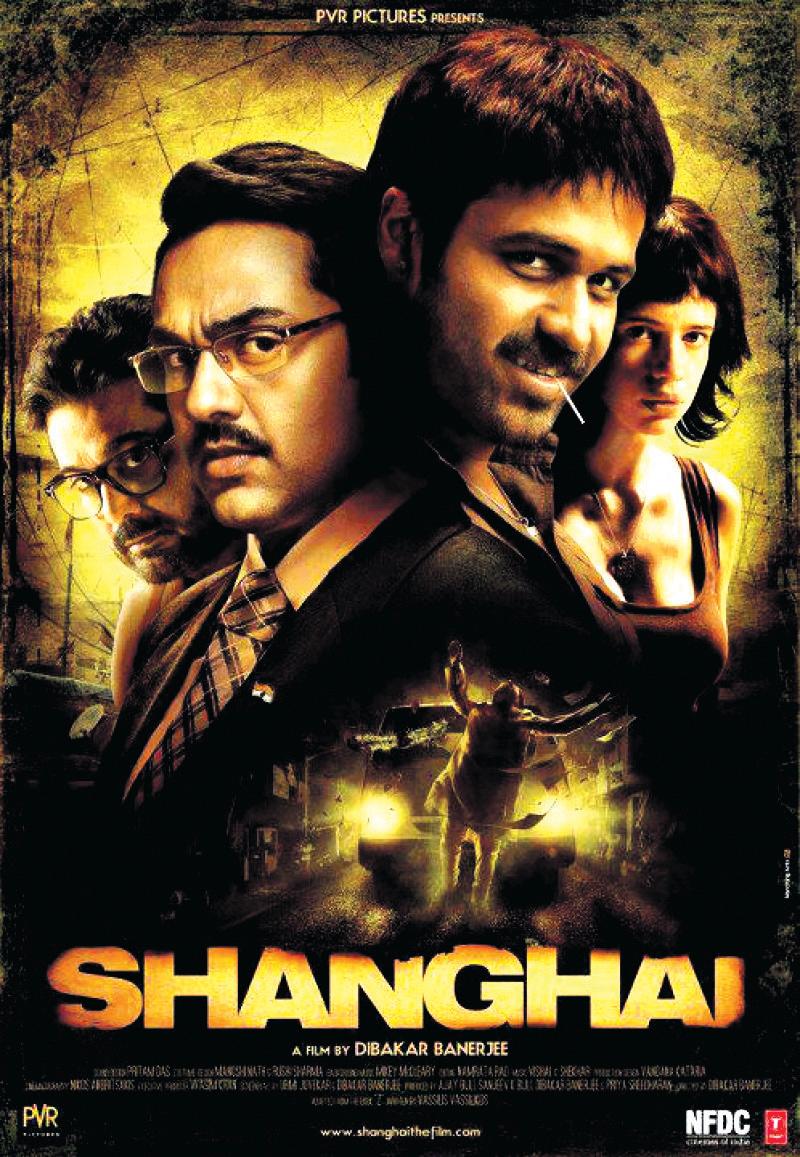
What adds to the flavour is excellent cinematography by Nikos Andritsakis and the marvellous use of sound, both ambient and otherwise, to build up the tension in the political drama.
The controversial song Bharat Mata Ki Jai and the item number Imported Kamariyaa are wellpicturised and the latter is on the way to become the next favourite numbers at all basti celebrations.
Despite its simplistic and down-toearth locations, Shanghai has a nice hard-boiled vibe and a sense of semiexotic danger. Definitely gives you a lot to ponder about.
Don’t miss this one.
Troy Ribeiro
FILM: Shanghai
CAST: Prosenjeet Chatterjee, Abhay Deol, emraan Hashmi, kalki koechlin, Supriya Pathak and farooque Shaikh
DIRECTOR: Dibakar Banerjee
Raghuvir shines in heart-warming tale
It was that great poet-thinker Harindranath Chattopadhyay who said: “It’s very simple to be difficult, but very difficult to be simple.” By that logic, debutant director Gitanjali Sinha has pulled off a reasonably admirable feat in this simple straight-from-theheart film about the relationship between a neglected boy Avinash (Raj Tandon) and his lonely grandfather.
The film vaguely echoes L.V. Prasad’s 1974 tearjerker Bidaai, though not in any overt way. That the grandfather who embraces the boy’s loneliness and insecurities is played by Raghuvir Yadav is a happy coincidence, and one that fills up the rather austere spaces in the film’s narrative.
The small-town ambience in Bihar, the old sprawling houses with acres of greenery stretching out from here to eternity, furnish the film with a burnished exterior.
As for the interiors, don’t look
too deep. Sinha seems content skimming the surface of the emotions gliding along gently as the boy finds a new beginning in his grandfather’s company.
Dramatic conflicts are created through some villainous elements creeping in with embarrassing inopportunity into the placid ambience. The build-up towards a kite-flying contest is negotiated with disarming naivete.
Yeh Khula Aasmaan is an old-fashioned simple and transparent tale told with a straightforwardness that challenges current filmmaking trends of irrelevant complexities.
The narration is kept simple and largely formulistic. A romance between the gawky hero and the-girl-next-door (Anya Anand) is teased into the tale. The real hero of the film, besides the smalltown ambience, is Raghuvir. He is in his elements, even pitching in with a folk song somewhere
down the line while the youngsters at the helm serve their purpose. Yashpal Sharma as Avinash’s sophisticated tycoon-father is completely miscast.
Yeh Khula Aasmaan is a well-intended heartwarming film which revels in postures of pristine idealism associated with nonmetropolitan life. There are no heartstopping moments of high and low.
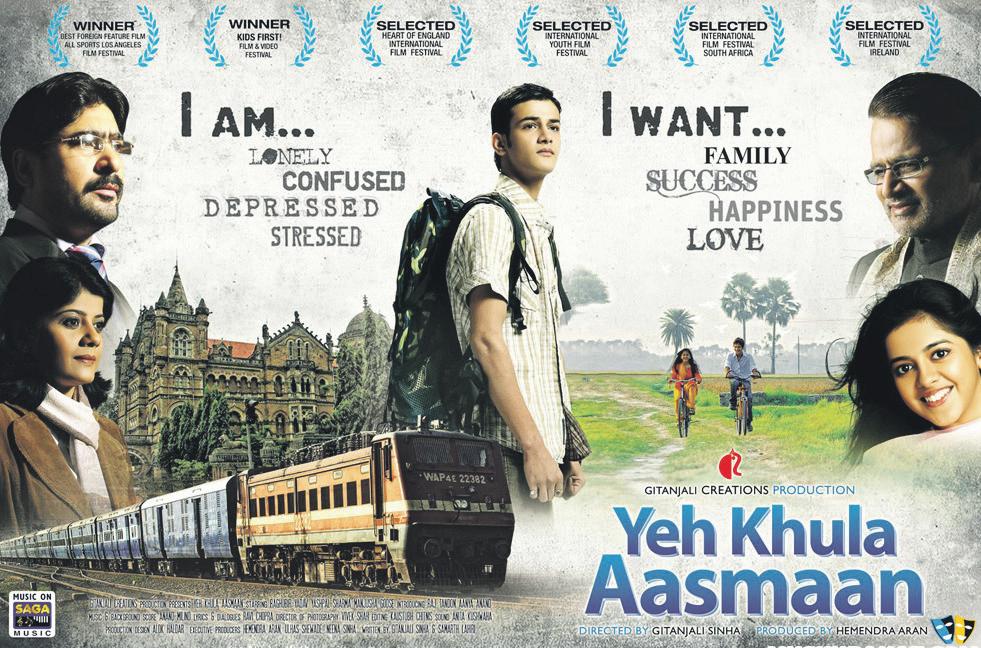

The drama, when it ensues, is brought on with disarming simplicity. That the heart is in the right place is undeniable.
Subhash K. Jha
CAST:
DIRECTOR: gitanjali Sinha
JUNE 2012 59 INDIAN LINK
FILM:Yeh Khula Aasmaan
Raghuvir yadav, Raj Tandon, Anya Anand, yashpal Sharma and manjusha godse
Data savers or dodos?
Technology gets better almost as fast as it gets obsolete, but some ancient receptacles of knowledge still survive
BY LP AYER
Ihave, in the past through this column, bemoaned the plight posed by PCs and the plastic junk plaguing Planet Earth. I lambasted laptops and demonised desktops. But the harrowing tale of getting rid of the heaps of hardware reaching Himalayan proportions is just a Sunday picnic compared to the sorry saga of storage devices.
My grave concern is the problem we may face, not before long, in accessing vital personal information snugly stored in various storage media and feeling smug about retrieving them any time in the future. Some time ago, owing to my part-time role in a medical practice, I attended a healthcare industry managers’ seminar where the main topic was saving storage space and retrieval of data. Understandably the speakers, sponsored by software vendors, waxed eloquent on computers’ capacity to save you dollops of dollars by shrinking storage space and sparing tropical forests by creating paperless offices. Anyone with any link to the medical industry would know that it is a prolific paper-user and records need to be kept for years and years. Every patient’s portrayal of their pain has to be painstakingly preserved to protect the service provider’s professional integrity and indemnity. Some patients’ paper records where I worked were bulkier than a Harry Potter book. So I had a good reason to attend this seminar in the fond hope of saving storage space and rental dollars for my employer.

At the end of the meeting almost everyone seemed swayed by the smooth talking software spokespersons. Waiting for the Q&A segment to close, the cynic in me dared to dig into my bag of tricks and voice my concerns about the possibility of our securely saved data sliding into a sinkhole, never to be seen again.
In the mid ‘80s, my Apple 2c required five and half inch floppy discs to save data. The X and Y gens may not know what this floppy disc looks like. I have dozens with my personal correspondence, important and not so important, ensconced in them. With the old Apple having lost its core, there is no way of retrieving this data now. I hope anyone I had lent money to doesn’t see this column. I have no
proof that they owe me. In the mid ‘90s I used the more popular 3 ¼” diskette to store the medical practice data, and we were crunching one disk every few days; so we upgraded to a Zip drive as it zaps data into a more compact mode. But that joy was short-lived since it was no different from its slimmer 3 ¼” cousin. Does any desktop now come with drives to read these disks? Sadly, no! A chest full of these diskettes lie dormant, hoarding valuable data. They are like the buried treasures of the Thiruvananthapuram temple. I know they are there, but I can’t access them. Next, I migrated to CDs and DVDs, and have dozens of them with critical info of client consults. They are still accessible, but how long will it be before they meet the same fate of the earlier diskettes. But these round shiny shingles have some use. I
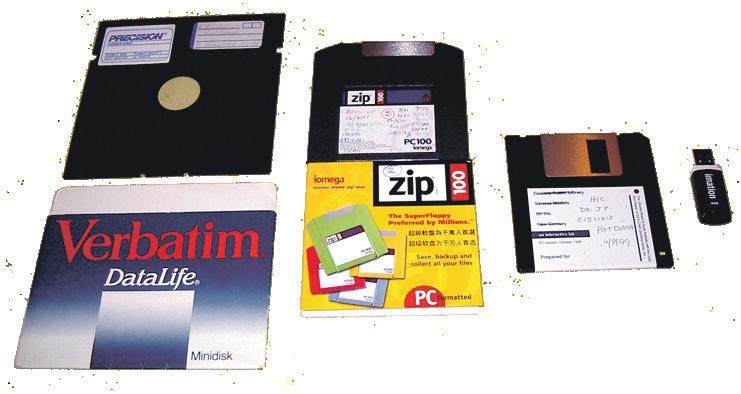
hung a few of them in my fruit trees and they seem to scare away the birds.
Now come the flash drives, aka memory sticks. How secure are they? If you unfortunately lose one, all your life secrets are out for the whole world to see.
Much to the chagrin of the speakers I pulled out a file containing handwritten letters, including the last one from my father before he passed away some 40 years ago. Written on Titagur (Orissa) mill paper, I can flip to any piece in that folder in a matter of seconds, with all its contents clearly visible.
Next I pulled out my trump card. A stack of palm leaves the size of Mars bars with wooden pieces of the same size on the top and bottom, serving as protective cover. Written with a stylus, every word on those leaves pops out like a pearl. It is of 19th century origin
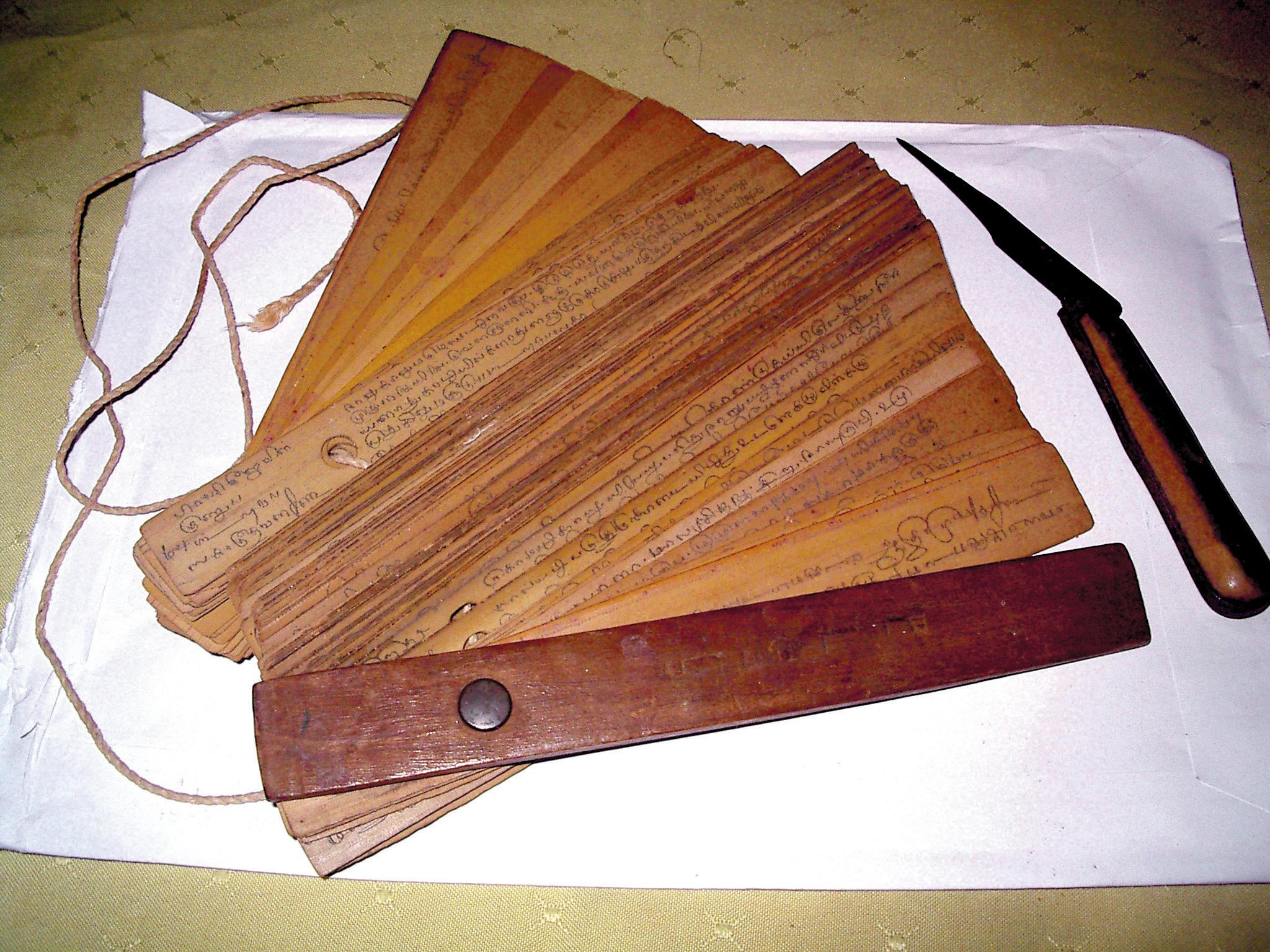
given to my grandfather, and passed on to my father. It contains diagnostic details of cattle diseases and herbal cures. My forefathers used it as a ready reference to treat any ailment of the dozens of cows they owned. It is the ‘Sahadeva sastra’. During their year of anonymity, the Pandavas lived under different guises with Sahadeva leading the life of a cowherd and it was his handiwork reproduced. After over a hundredyear life span, all the information on these palm leaves is accessible, legible and readable; whereas my ten or twenty year-old computer disks are museum pieces. So much for technology!
Desktops have gone the way of dodos; laptops are languishing, with Tablets giving them headaches. It is not just the hardware that gives us the hard time. The short lifespan of storage media is a scary scenario indeed.
With the old Apple having lost its core, there is no way of retrieving this data now.
After over a hundred-year life span, all the information on these palm leaves is still accessible, legible and readable; whereas my ten or twenty year-old computer disks are museum pieces.
60 JUNE 2012 www.indianlink.com.au BACKC h At
Palm leaf document from the 19th century on which information is still legible and readable
Data storage devices from 20 years ago, largely unreadable

JUNE 2012 61 INDIAN LINK
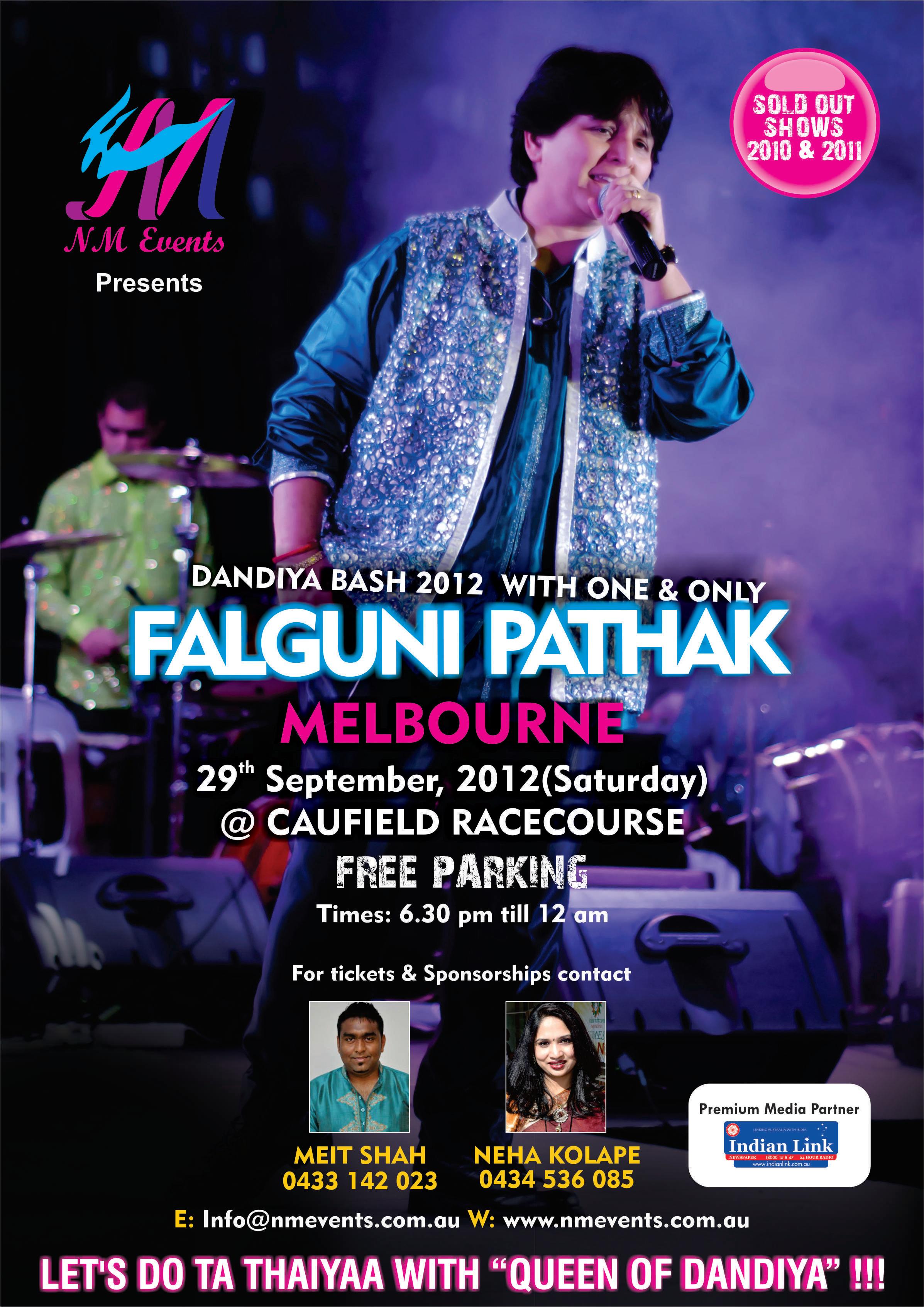
62 JUNE 2012 www.indianlink.com.au

JUNE 2012 63 INDIAN LINK

64 JUNE 2012 www.indianlink.com.au



























 Main photo: News pics Photos: Ravinder Singh Jabbal
Main photo: News pics Photos: Ravinder Singh Jabbal























 Preeti Jabbal
Preeti Jabbal























































































 Preeti Jabbal
Preeti Jabbal








































 BY PETRA O’NEILL
BY PETRA O’NEILL























 BY RITAM MITRA
BY RITAM MITRA

















































